Java Bay Stock Play It Again Sports Stocks
Thomas J. O'Halloran // Library of Congress
Stock market history from the year you were born
Whether or not you are a big investor, most Americans know that a glance at the stock market is usually a dependable gauge of the financial temperature of the country.
Stacker compiled historical total annual returns, including both price appreciation and dividends, from 1920 to 2020. Stock returns data from 1928 to 2020 is from YCharts and New York University finance professor Aswath Damodaran. The 1920 to 1927 stock returns are based on Robert Shiller's Standard & Poor's (S&P) Composite total returns, originally published in his 1989 book "Market Volatility," which has been revised and updated. In 1957, the S&P transitioned its major index into an examination of 500 select companies, creating the well-known S&P 500 index. The index tracks companies listed on the New York Stock Exchange (NYSE) and the Nasdaq Stock Market, using a market capitalization weighting methodology—giving more weight to larger companies—as compared to the price-weighted approach employed by the Dow Jones Industrial Average. Annual returns for three-month U.S. Treasury bills—short-term bonds that serve as an indicator of the risk-free rate—are included as a basis for comparison to stock market returns. All current stock prices listed are from the week of March 2, 2021.
Whether you're a finance buff, a history fiend, or looking to relive a slice of American life from your youth, the following slideshow is sure to inform. During the history of the American stock market, Wall Street has experienced bombings, shocking closings, and ticker-tape parades. Keep reading to learn about this and much more stock market history from the year you were born.
You may also like: 50 biggest retailers in America
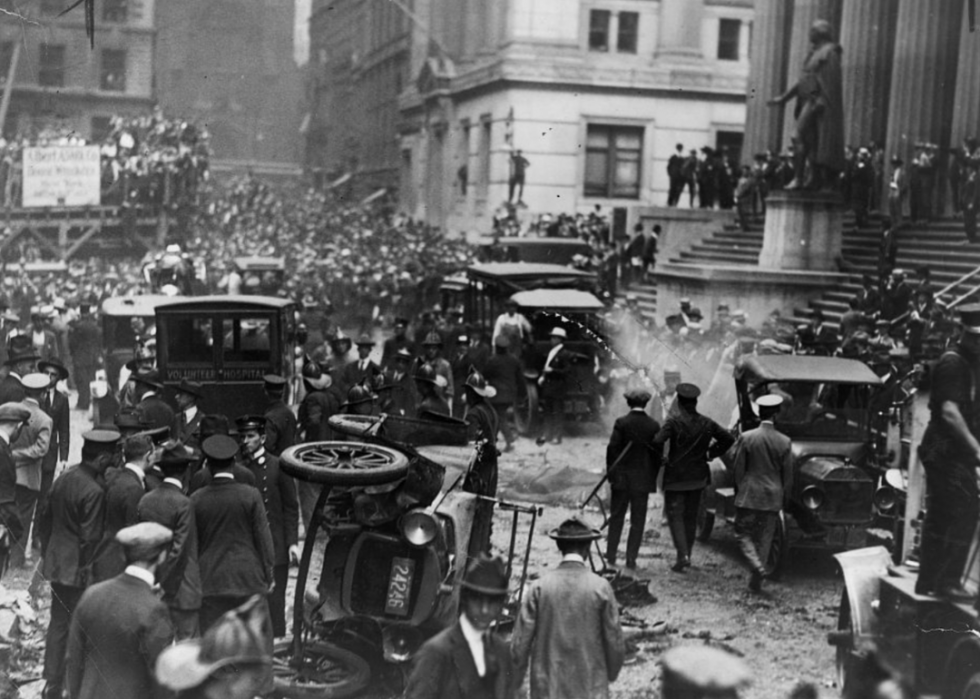
1 / 102
1920
- Return on S&P Composite index: -12.34%
- Return on 3-month Treasury bills: 5.42%
On Sept. 16, a bomber killed 30 people on Wall Street in the heart of New York's financial district. Trading was cancelled for the day, and although anarchists were primary suspects, the case was never solved.
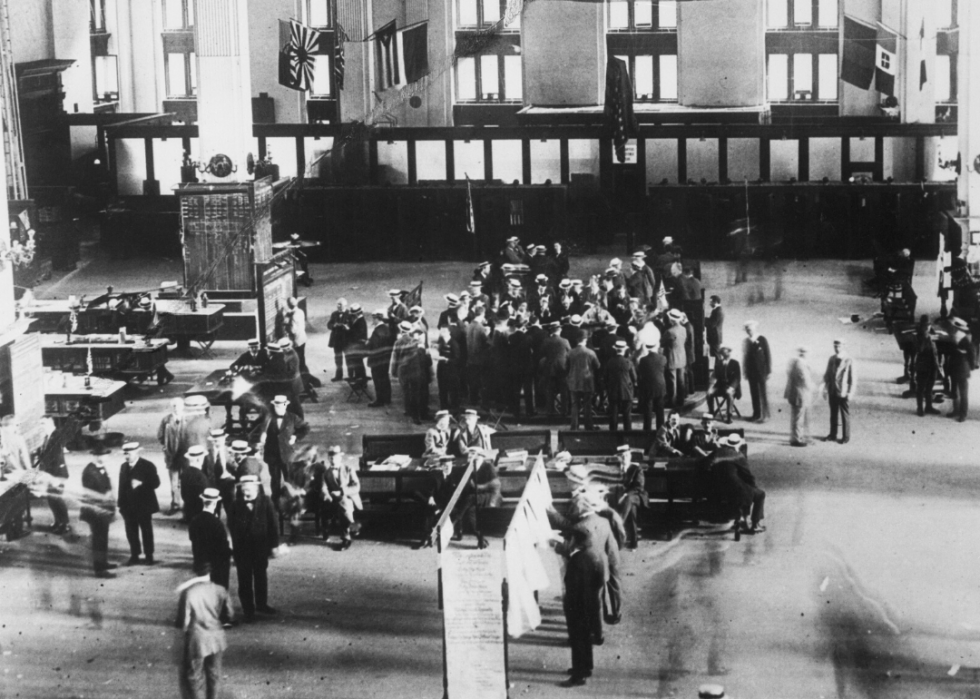
2 / 102
1921
- Return on S&P Composite index: 22.70%
- Return on 3-month Treasury bills: 4.83%
After World War I, a depression ran from early 1920 to the summer of 1921. By some measures, stock prices were cut in half and unemployment affected almost 20% of the American labor force. When the market rebounded, the Roaring ʼ20s took off.
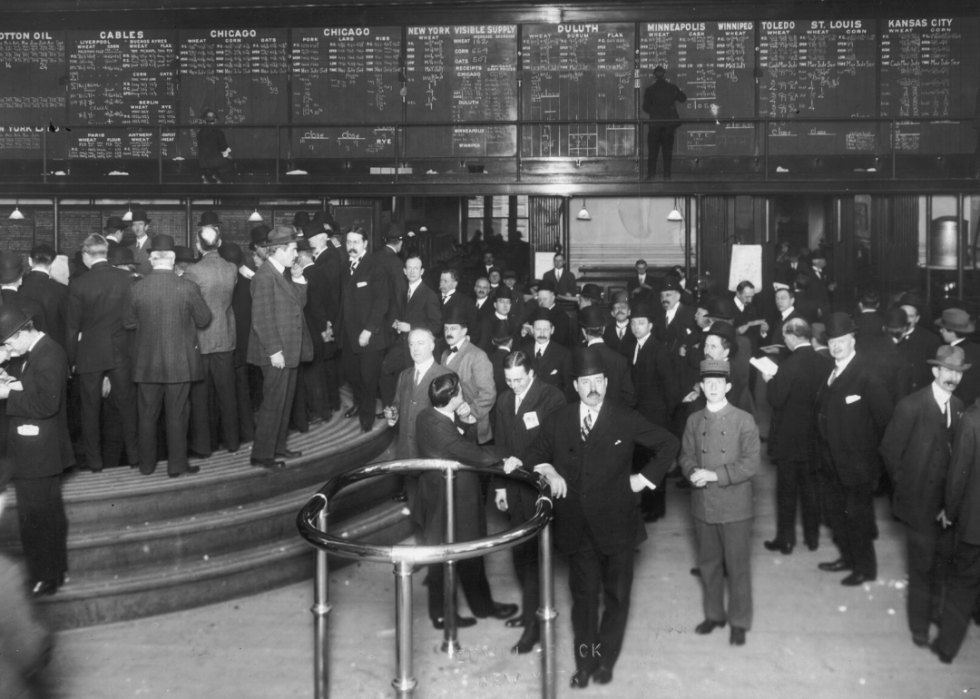
3 / 102
Edwin Levick // Getty Images
1922
- Return on S&P Composite index: 29.67%
- Return on 3-month Treasury bills: 3.47%
Beginning in 1922 and lasting until 1929, gross national product grew annually at 4.7%, setting off the Roaring ʼ20s. In addition, industrial production grew annually at 3.1%, and the unemployment average was 3.7%. At year's end, the stock market was up 21.5% from 1921.
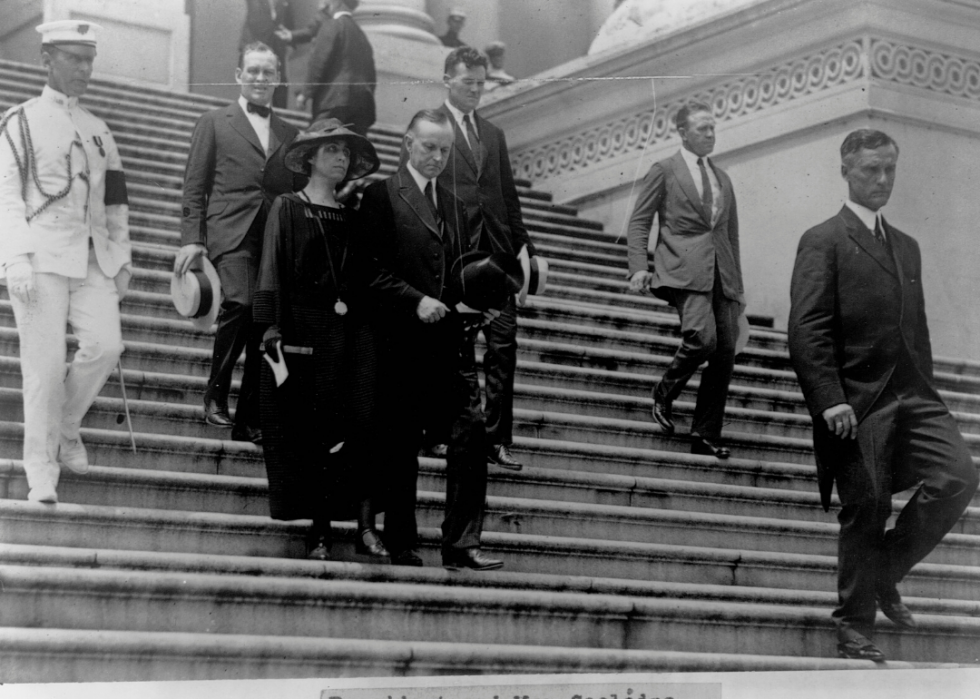
4 / 102
French Harding/Library of Congress/Corbis/VCG // Getty Images
1923
- Return on S&P Composite index: 2.13%
- Return on 3-month Treasury bills: 3.93%
In 1923, Calvin Coolidge became president of the United States after the death of Warren G. Harding. During Coolidge's first year in office, minimum wage laws mandated for women were declared unconstitutional, and he had to combat a major united coal strike. Stocks continued to rise, though, reaching a high of 105.38, its highest mark since 1920.
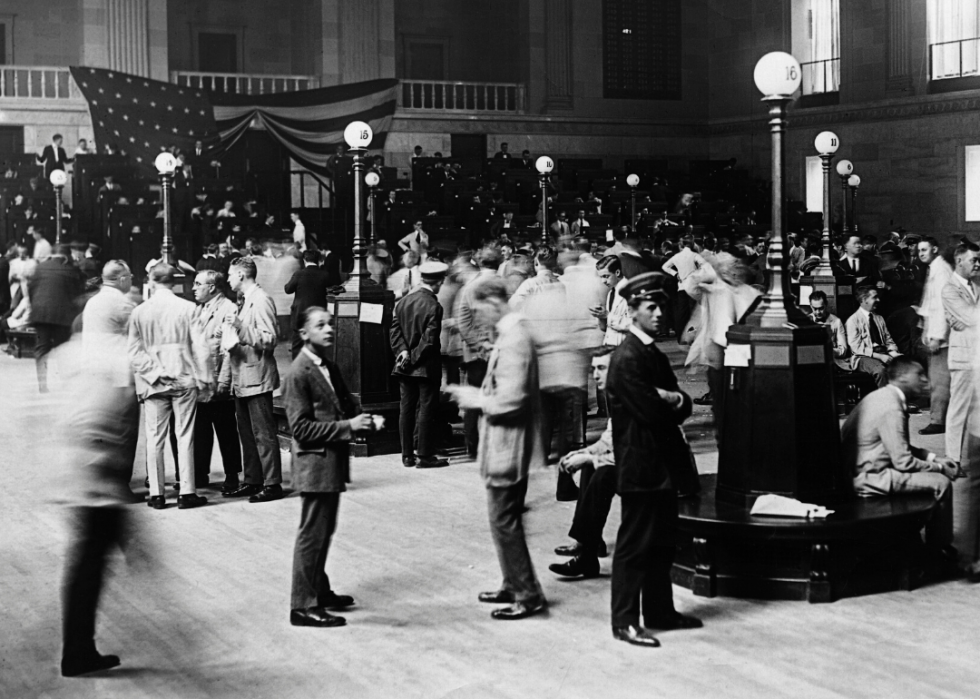
5 / 102
George Rinhart/Corbis // Getty Images
1924
- Return on S&P Composite index: 26.05%
- Return on 3-month Treasury bills: 2.71%
The height of the Roaring ʼ20s began in 1924. Throughout the next five years, the Dow Jones Industrial Average quadrupled. In November, Calvin Coolidge was re-elected president of the United States.
You may also like: History of the supermarket industry in America
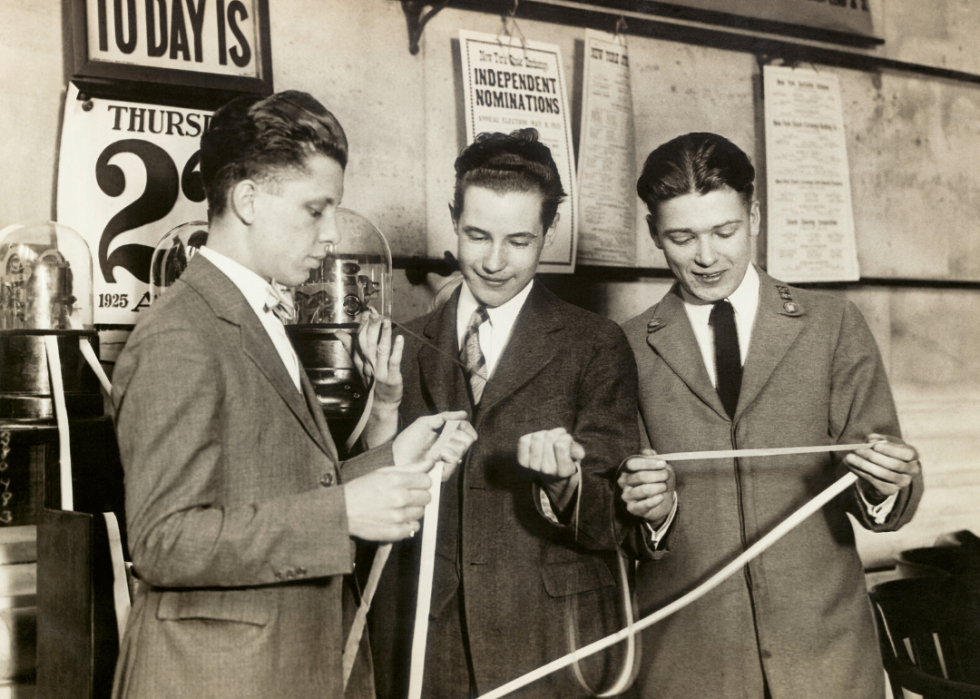
6 / 102
George Rinhart/Corbis // Getty Images
1925
- Return on S&P Composite index: 21.04%
- Return on 3-month Treasury bills: 3.03%
The stock market closed 1925 at its highest price ever, at 151.08. Also this year, the Chrysler Corporation was founded, and automakers soon became some of the biggest drivers of Wall Street.
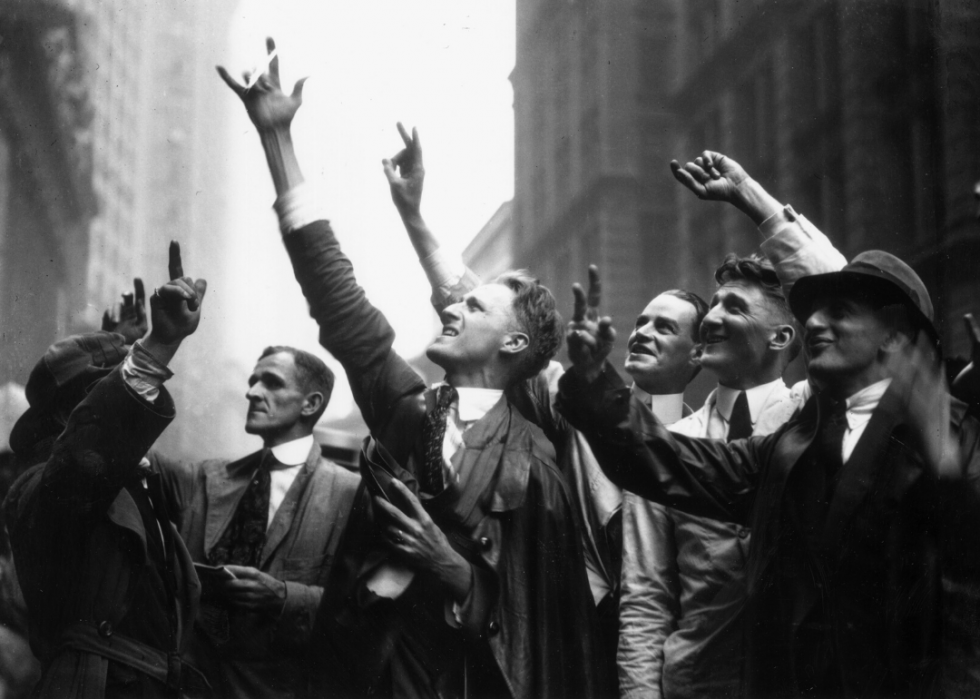
7 / 102
Hulton Archive // Getty Images
1926
- Return on S&P Composite index: 13.93%
- Return on 3-month Treasury bills: 3.23%
At 157.20, the Dow closed at its highest mark ever in 1926. However, that figure would be nothing compared to the next two years, when the Dow closed at over 200 and then 300. NBC and Schick were among the future business titans to open up shop this year.
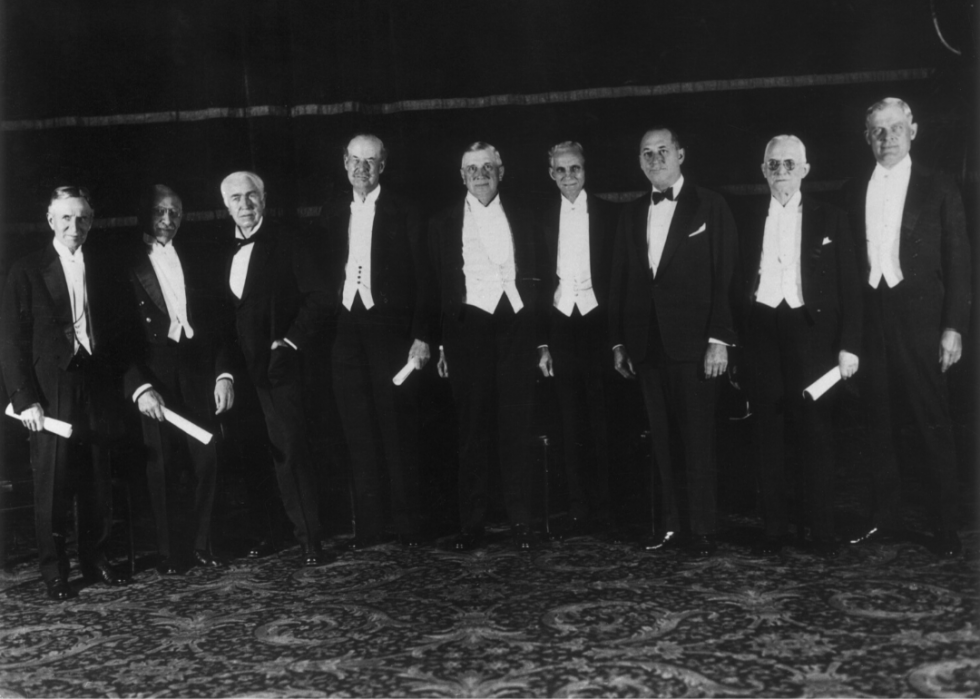
8 / 102
American Stock // Getty Images
1927
- Return on S&P Composite index: 38.15%
- Return on 3-month Treasury bills: 3.10%
In 1927, RCA became a pioneer in television and several other new technologies created a stock market bubble over the next two years. General Motors also introduced its Cadillac division's LaSalle line, and with TV and cars becoming more prevalent, unprecedented opulence permeated the country.
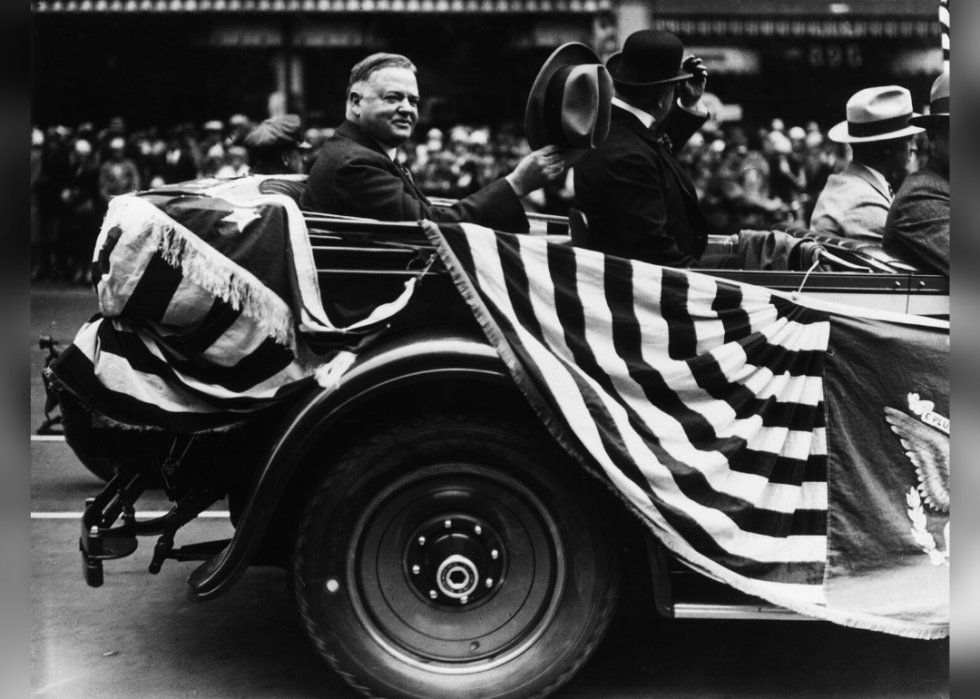
9 / 102
American Stock // Getty Images
1928
- Return on the S&P 500: 43.81%
- Return on 3-month Treasury bills: 3.08%
Allied Van Lines, Delta Air Lines, Farmers Insurance, and Playskool were just some of the companies founded in 1928, as American business was booming and people wanted to get in on the thriving stock market. The Dow jumped more than 49% from 1927, but a cloud was looming, and it would shower down doom in the year to come.
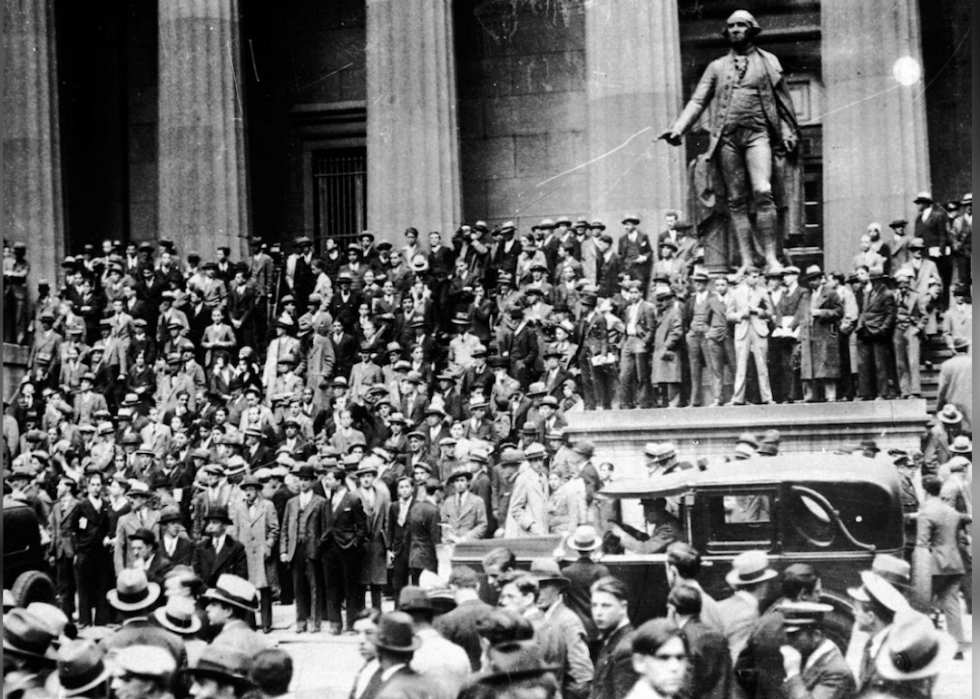
10 / 102
1929
- Return on the S&P 500: -8.3%
- Return on 3-month Treasury bills: 3.16%
Oct. 28, 1929, is remembered as Black Monday, when the stock market dropped 13%. The following day, the market fell 12%. The 1929 high of 381.17 would not be reached again until the 1950s. The great crash of 1929 led America into a financial spiral, precipitated by a recession a few months earlier.
You may also like: The top women CEOs in America
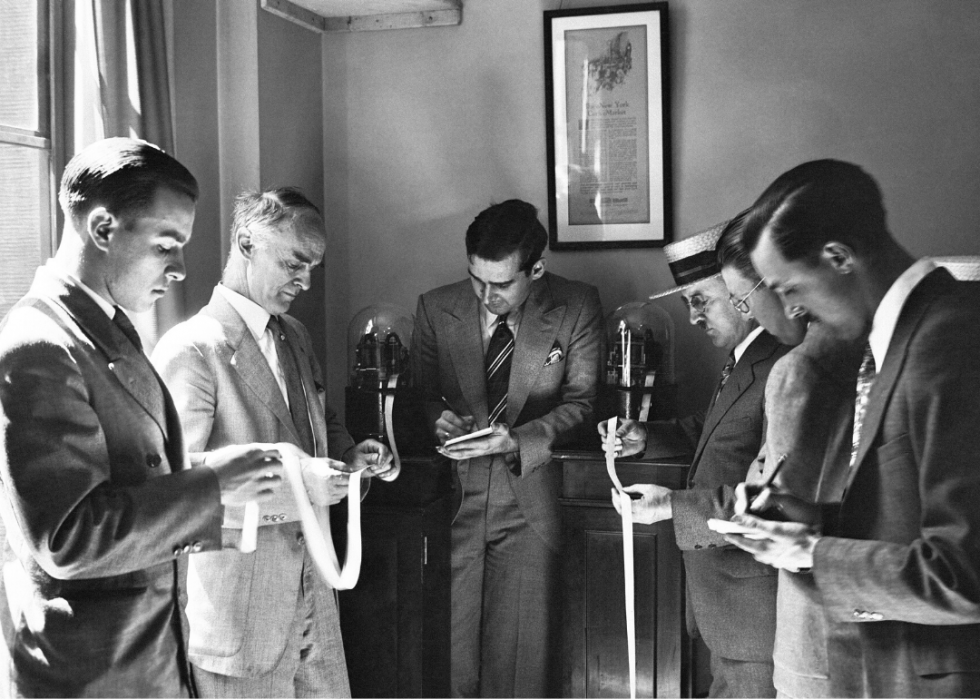
11 / 102
Charles Phelps Cushing/ClassicStock // Getty Images
1930
- Return on the S&P 500: -25.12%
- Return on 3-month Treasury bills: 4.55%
Some historians note that the market rebounded by the spring of 1930. But because banks extended a surplus of bad loans, banks began to fail by the end of the year. The Dow closed the year at 164.58, almost half of what it did at the end of 1928.
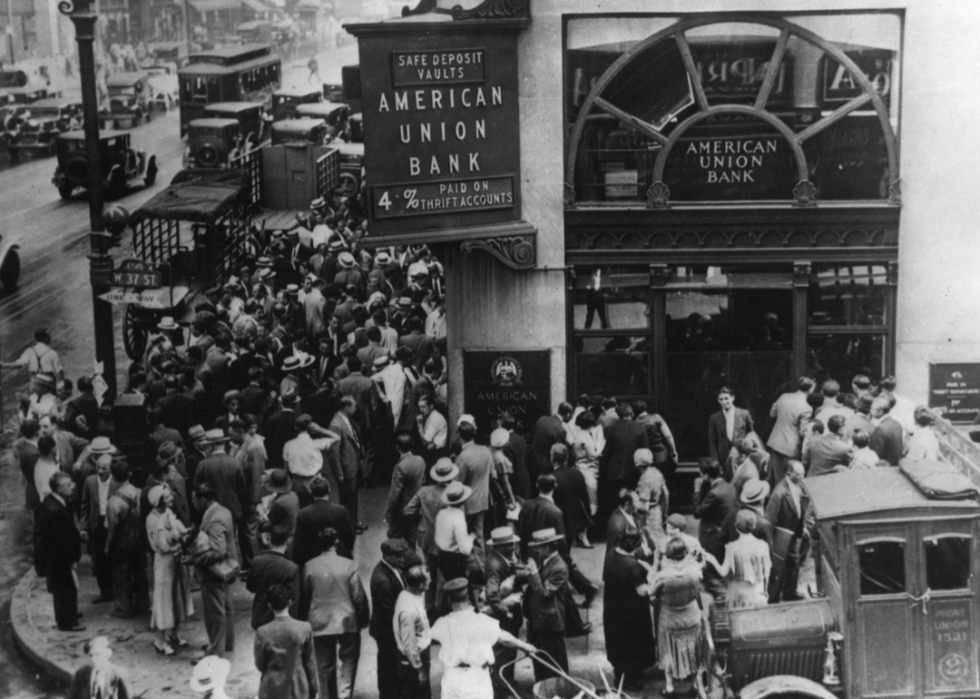
12 / 102
Public Domain // Wikimedia Commons
1931
- Return on the S&P 500: -43.84%
- Return on 3-month Treasury bills: 2.31%
In 1931, the Dow dropped more than 52%, and major banks in Europe were collapsing. By the end of the year, the Bank of the United States, the fourth-largest bank in New York City, collapsed.
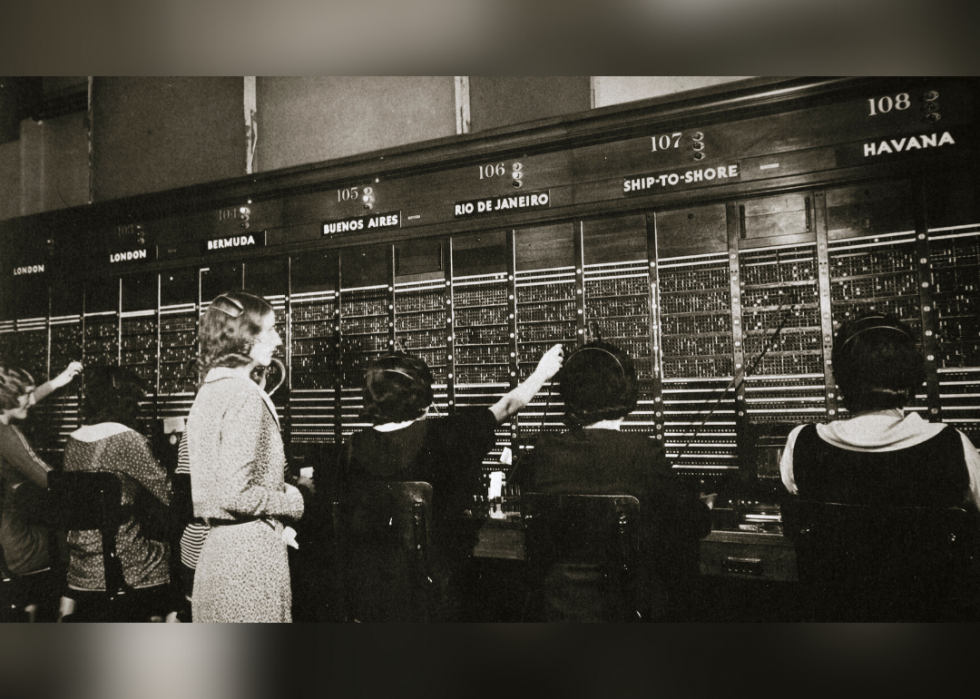
13 / 102
Historica Graphica Collection/Heritage Images // Getty Images
1932
- Return on the S&P 500: -8.64%
- Return on 3-month Treasury bills: 1.07%
The Revenue Act of 1932 was intended to raise tax rates and help scuttle the declining Dow. But one month after it was signed, the Dow bottomed out at 41.22. That November, Franklin D. Roosevelt defeated Herbert Hoover—who signed the Revenue Act into law—in the presidential election in a landslide.
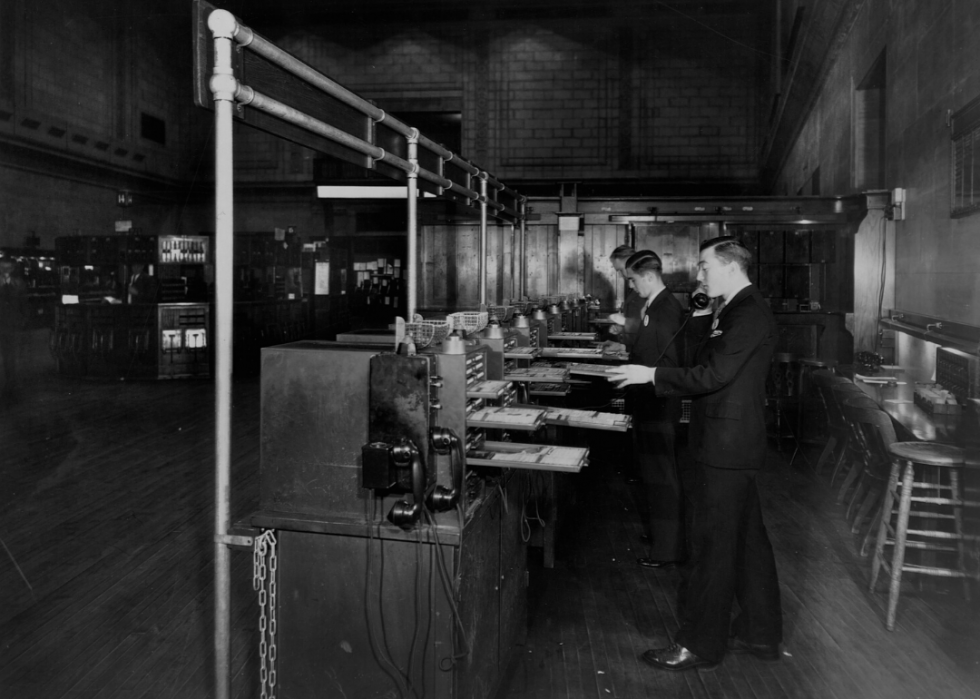
14 / 102
Library of Congress/Corbis/VCG // Getty Images
1933
- Return on the S&P 500: 49.98%
- Return on 3-month Treasury bills: 0.96%
On Feb. 14, 1933, Michigan declared a bank holiday as the state's banks and auto industry were collapsing. Less than one month later, President Franklin D. Roosevelt shut down the nation's banks. By the end of 1933, in another effort meant to stimulate the economy, Prohibition was repealed.
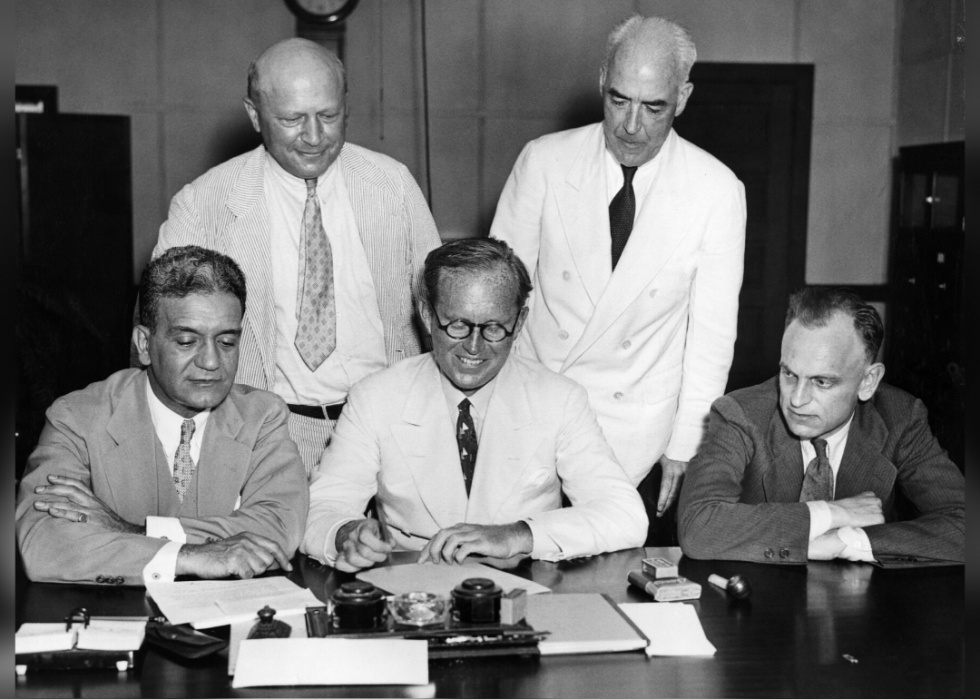
15 / 102
1934
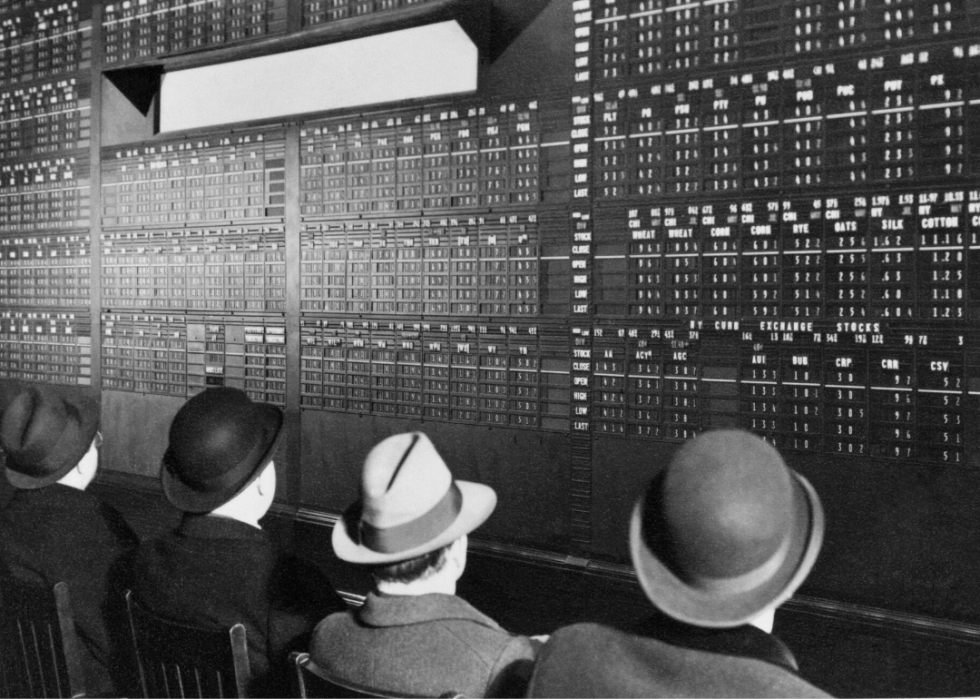
16 / 102
1935
- Return on the S&P 500: 46.74%
- Return on 3-month Treasury bills: 0.18%
For the first time since 1931, the Dow began the year above 100; by the end of 1935, it was up 38%. In September, Morgan Stanley opened for business at 2 Wall St. in New York City.
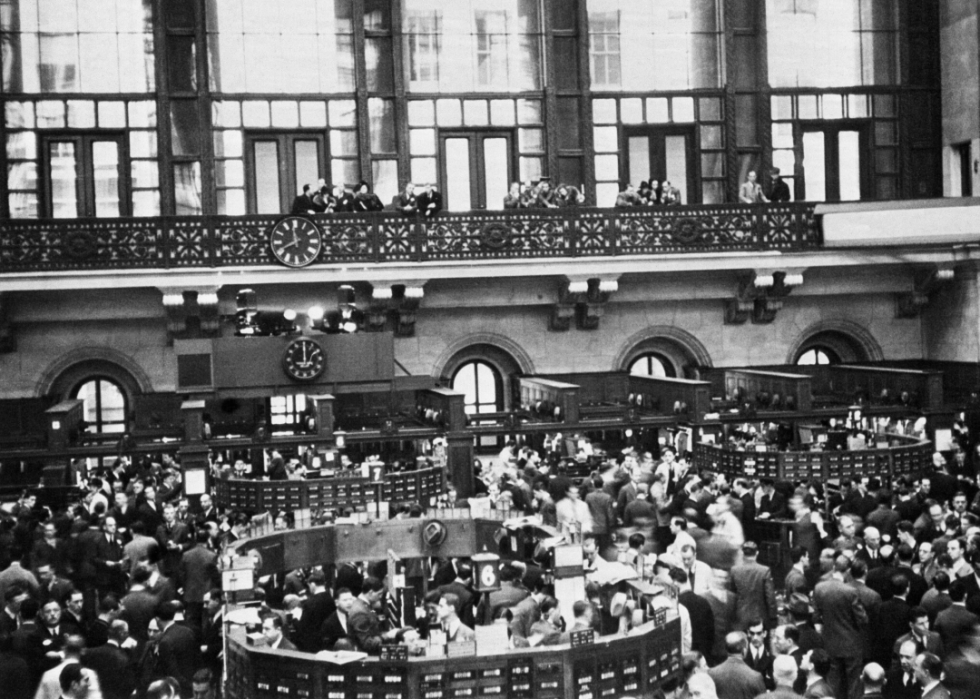
17 / 102
1936
- Return on the S&P 500: 31.94%
- Return on 3-month Treasury bills: 0.17%
By 1936, some Americans began to believe that the effects from the Great Depression were waning and the stock market would get back to its late-1920s heyday. The Dow reached a high of 184.90.
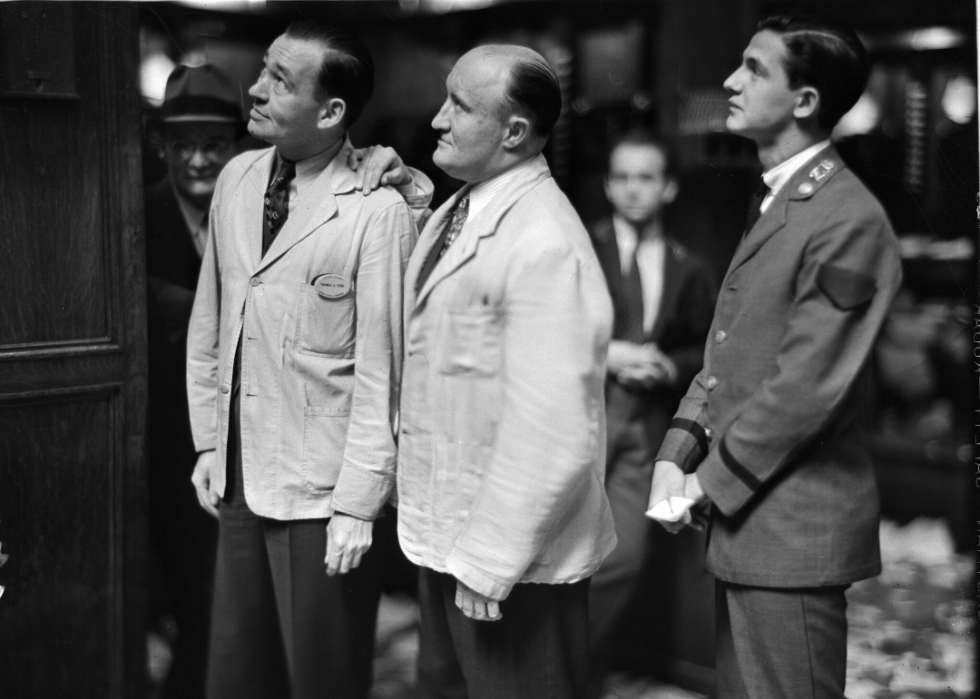
18 / 102
Lotte Jacobi/University of New Hampshire/Gado // Getty Images
1937
- Return on the S&P 500: -35.34%
- Return on 3-month Treasury bills: 0.3%
Early in 1937, the Dow continued its ascent, reaching 194.40. But the Dow closed the year more than 70 points lower, due to a recession that dropped the gross domestic product by 10% and raised unemployment to 20%.

19 / 102
1938
- Return on the S&P 500: 29.28%
- Return on 3-month Treasury bills: 0.08%
The United States was still mired in a recession for much of the first half of 1938. As war escalated in Europe, the market rebounded to end the year above 150, after dipping below 100 for the first time since 1935.
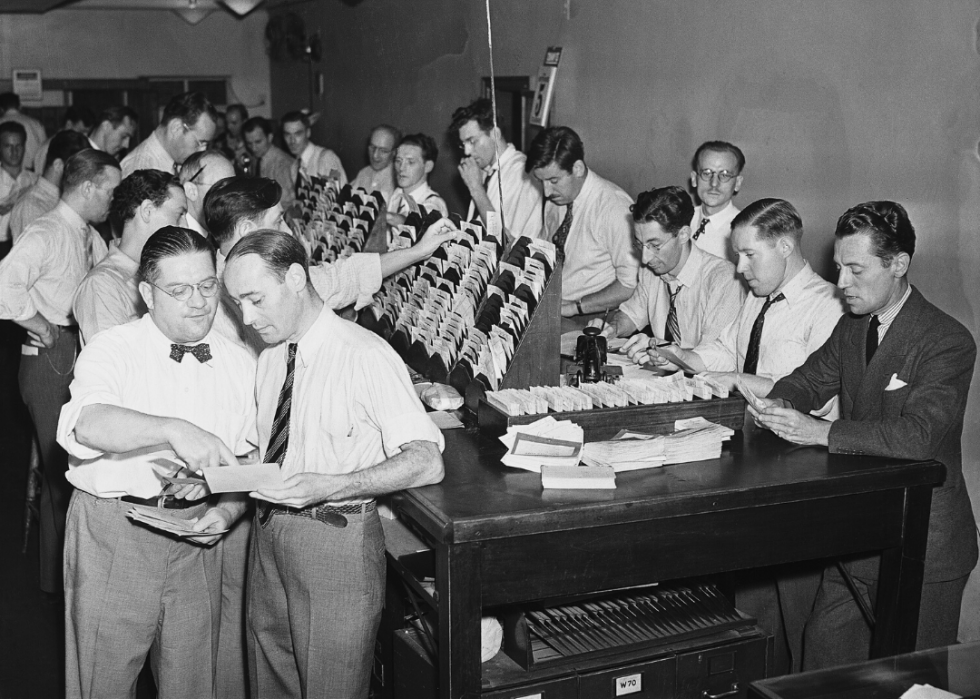
20 / 102
1939
- Return on the S&P 500: -1.1%
- Return on 3-month Treasury bills: 0.04%
Hewlett-Packard and US Airways were among the major companies to get off the ground in 1939. The World's Fair was held in New York, providing optimism for a more-lucrative future, but German blitzkriegs heightened tension among world markets.
You may also like: College majors that make the most money

21 / 102
Lawrence Thornton // Getty Images
1940
- Return on the S&P 500: -10.67%
- Return on 3-month Treasury bills: 0.03%
The stock market fell 12.72% from the end of 1939. In 1940, McDonald's and Koch Industries opened for business.
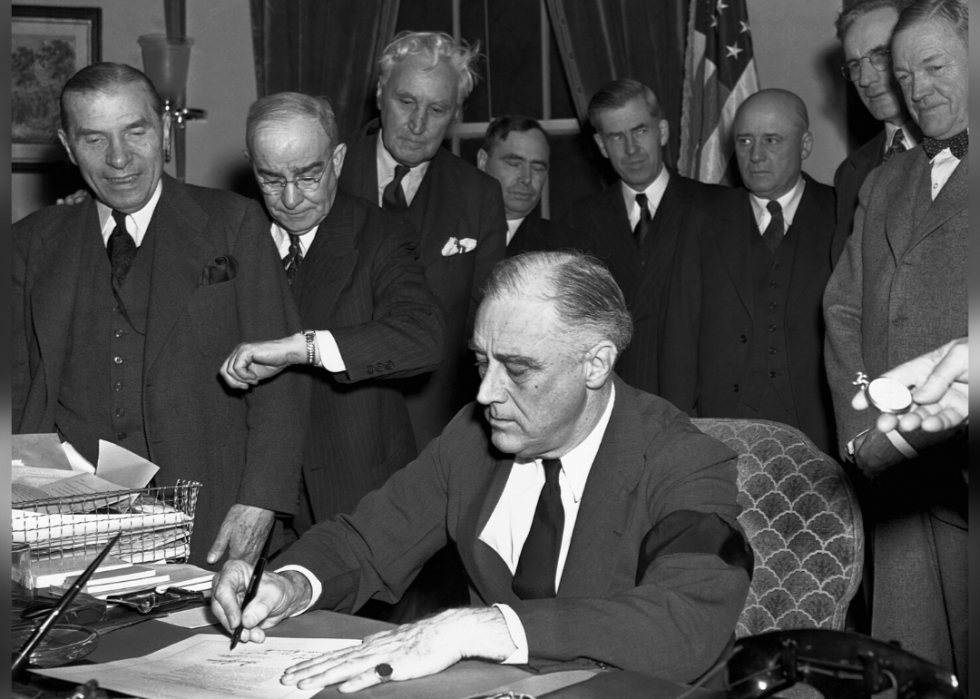
22 / 102
1941
- Return on the S&P 500: -12.77%
- Return on 3-month Treasury bills: 0.08%
For the third straight year, the Dow ended 1941 in decline. The Japanese attack on Pearl Harbor and the United States entry into World War II would soon impact markets around the world. Standard Statistics Co. and Poor's Publishing Co. merged to form Standard & Poor's.
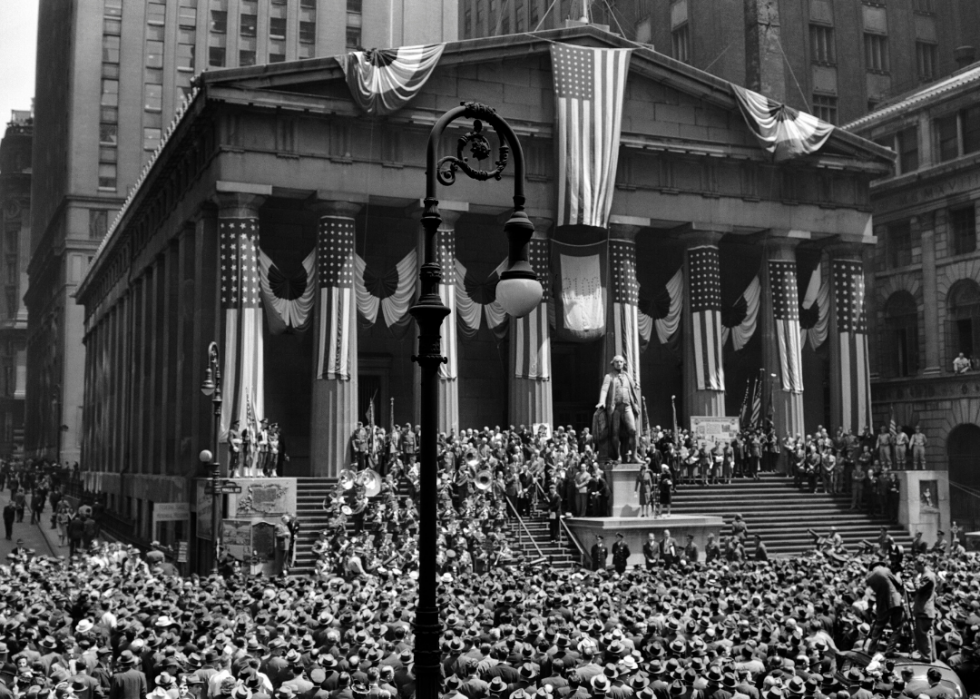
23 / 102
Charles Phelps Cushing/ClassicStock // Getty Images
1942
- Return on the S&P 500: 19.17%
- Return on 3-month Treasury bills: 0.34%
With America firmly entrenched in World War II, the Dow finished 1942 up for the first time since 1938, as industry and the public pitched in during the wartime effort. The sale of war bonds, in denominations ranging from $25 to $1,000, are an example of this public investment into the American wartime effort and economy.

24 / 102
1943
- Return on the S&P 500: 25.06%
- Return on 3-month Treasury bills: 0.38%
For the first time, women were allowed on the NYSE trading floor, working as runners and quotation clerks. In the summer of 1943, three dozen women entered 11 Wall St., for the first time in the NYSE's 151-year history.
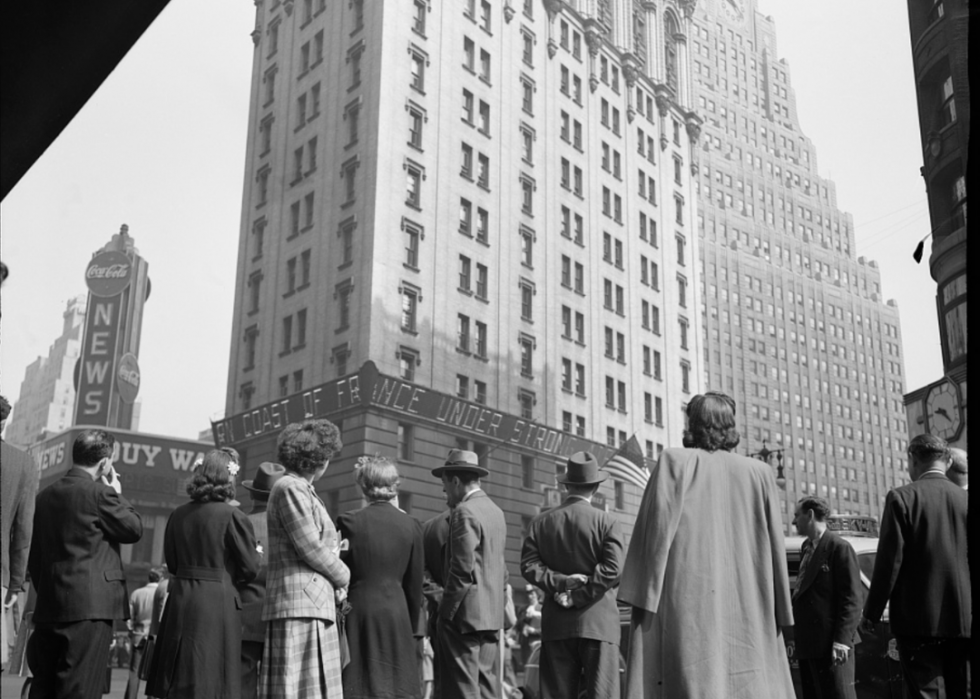
25 / 102
Howard R. Hollem // Library of Congress
1944
- Return on the S&P 500: 19.03%
- Return on 3-month Treasury bills: 0.38%
The NYSE stopped trading for two minutes on June 6. John Colman, chairman of the NYSE board, read aloud General Dwight Eisenhower's D-Day invasion message. With the tide of World War II turning in favor of the allies, the Dow finished 1944 up 12.09%.
You may also like: Billionaires that live in the smallest American towns
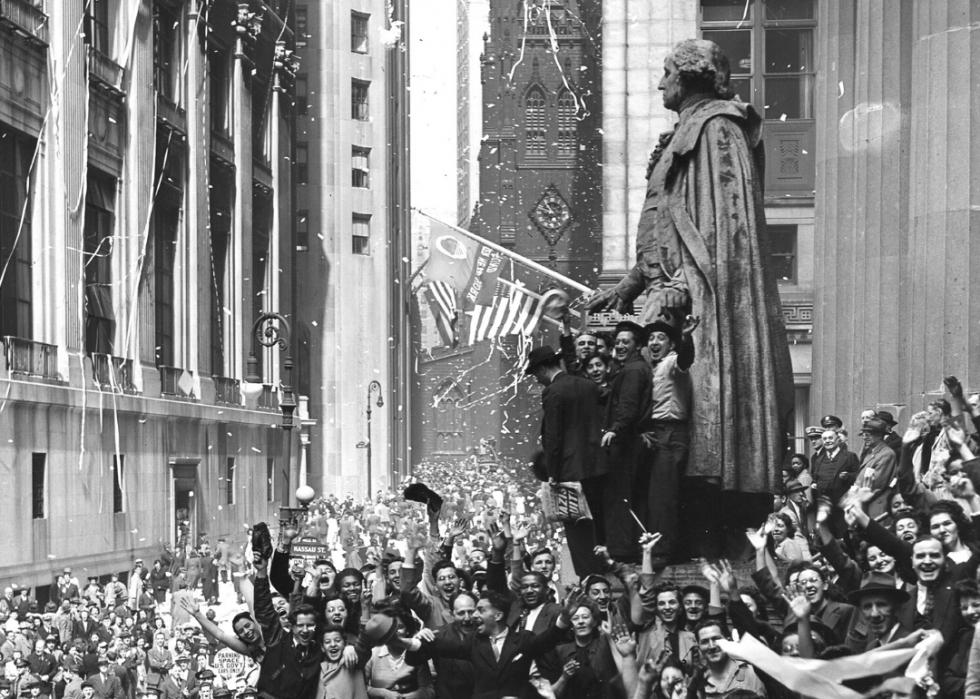
26 / 102
PhotoQuest // Getty Images
1945
- Return on the S&P 500: 35.82%
- Return on 3-month Treasury bills: 0.38%
In August 1945, after Japan surrendered to effectively end World War II, the NYSE closed for the day. By the end of the year, the Dow finished more than 26% higher than in 1944, and America would soon enter an era of prosperity.
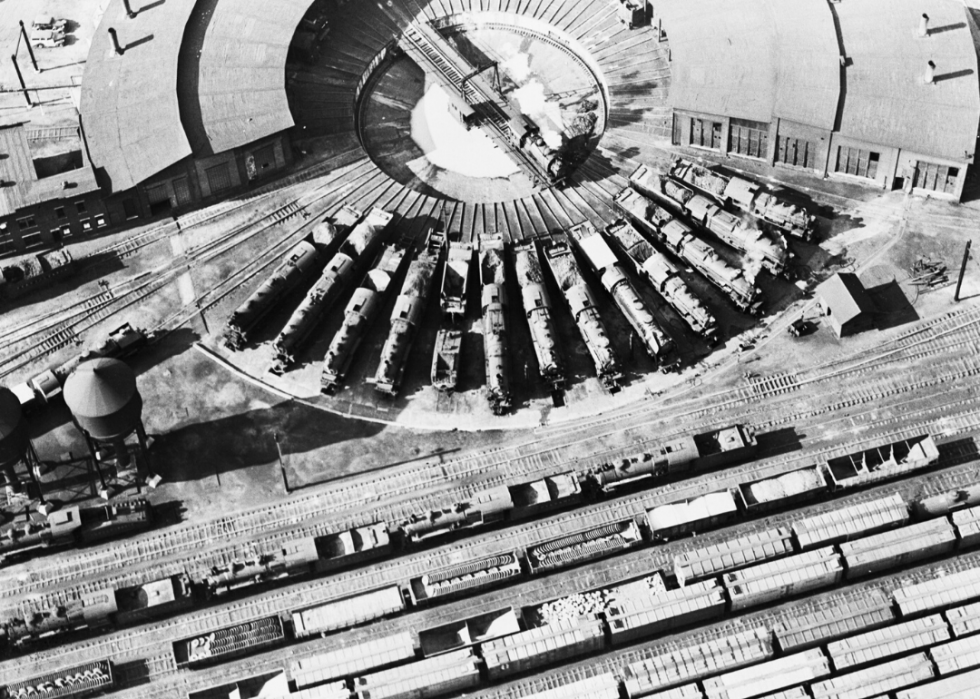
27 / 102
1946
- Return on the S&P 500: -8.43%
- Return on 3-month Treasury bills: 0.38%
Not everything was rosy immediately after World War II ended and the troops came home. The NYSE shut down in May 1946 due to a railroad strike. A few months later, the NYSE adopted a new slogan: The Nation's Market Place.
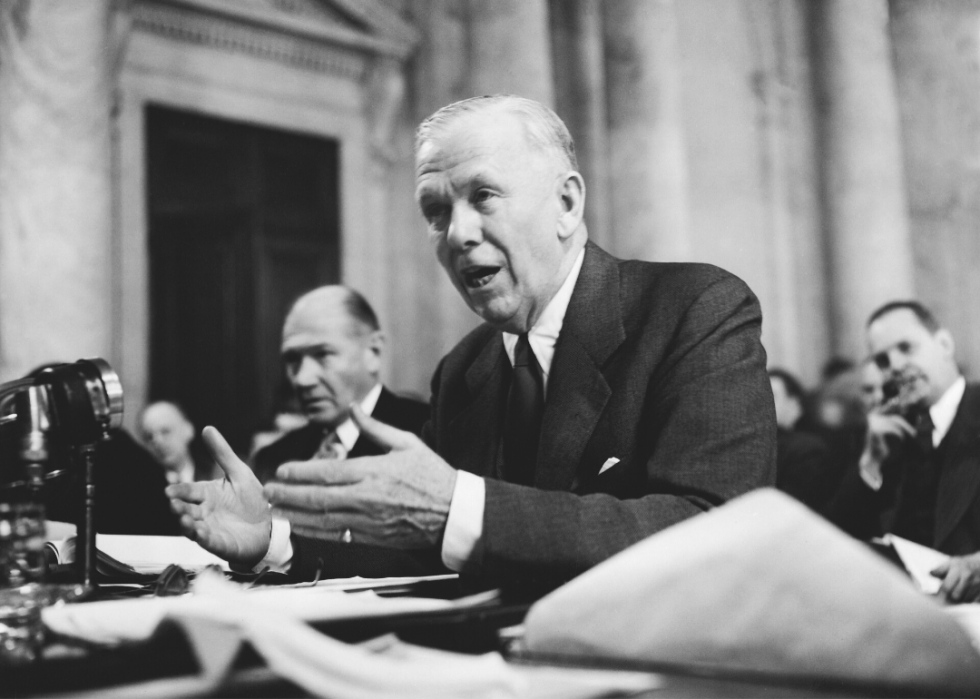
28 / 102
Underwood Archives // Getty Images
1947
- Return on the S&P 500: 5.2%
- Return on 3-month Treasury bills: 0.57%
There weren't immediate gains on Wall Street from the end of World War II. In 1946, the Dow fell more than 8% from the previous year, and in 1947, it only jumped 2.23%. As the American economy slowly rebuilt, economic attention became highly concentrated on rebuilding Europe, including early drafting of the Marshall Plan.
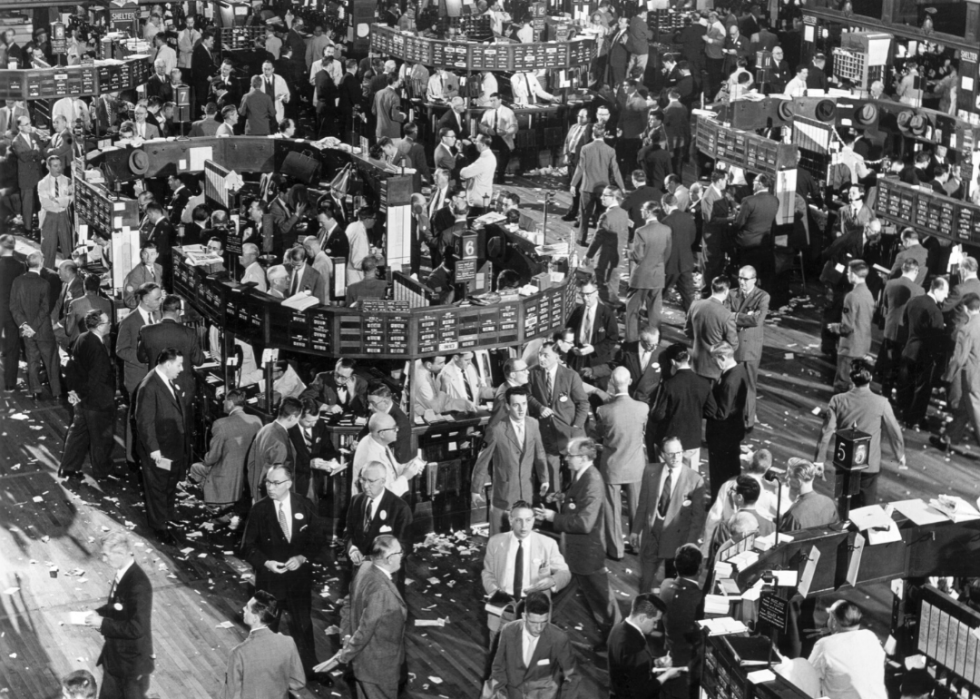
29 / 102
1948
- Return on the S&P 500: 5.7%
- Return on 3-month Treasury bills: 1.02%
With more Americans back home and starting new families, consumer interests began to change. In 1948, Wham-O, Toys "R" Us, and Dick's Sporting Goods were some of the entertainment-based companies to open, and throughout the next decade they would play a role in affecting markets. The 1994 film "The Hudsucker Proxy" dramatized the effect toys and other recreational goods had on the market during the mid-20th century.
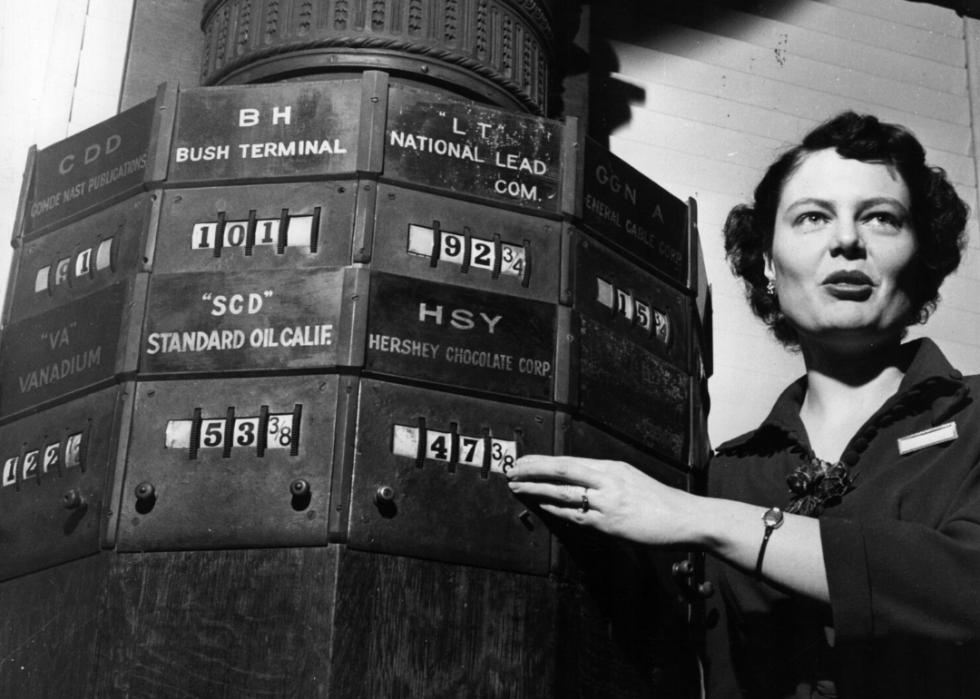
30 / 102
Three Lions // Getty Images
1949
- Return on the S&P 500: 18.3%
- Return on 3-month Treasury bills: 1.1%
Beginning in 1949, the stock market went on a bull run for seven years that led to a 454% gain for the S&P 500. According to Merriam-Webster, a bull market is one where "securities or commodities are persistently rising in value."
You may also like: How many of these 50 GED test questions can you get right?
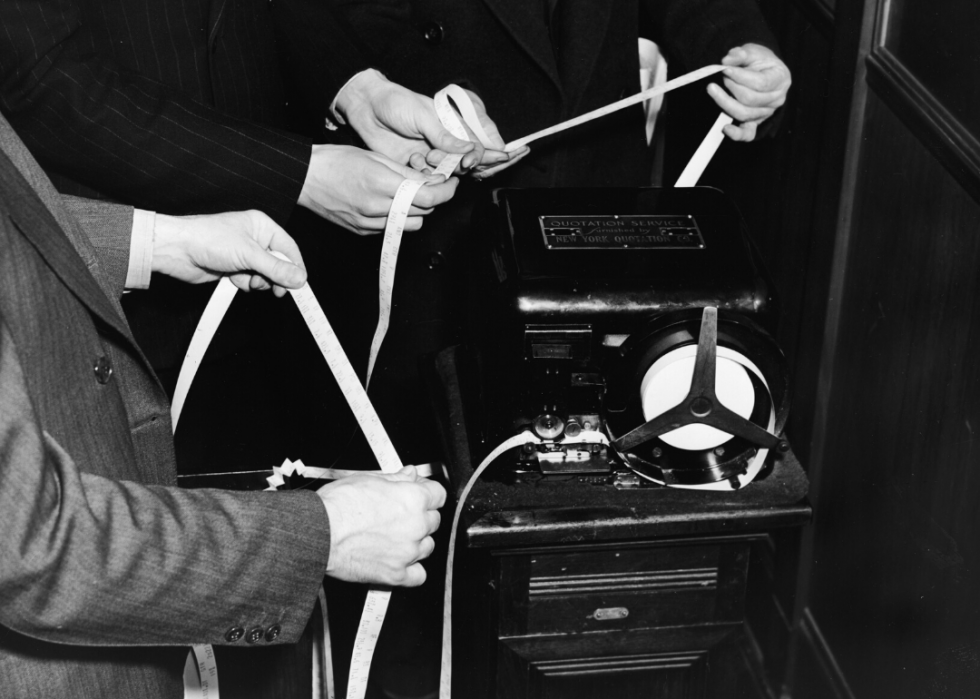
31 / 102
1950
- Return on the S&P 500: 30.81%
- Return on 3-month Treasury bills: 1.17%
In the week after the start of the Korean War, the stock market lost 4.65% of its value. By September, though, the market recovered the lost value and finished 1950 at 235.41, a high it hadn't seen since the early 1930s.
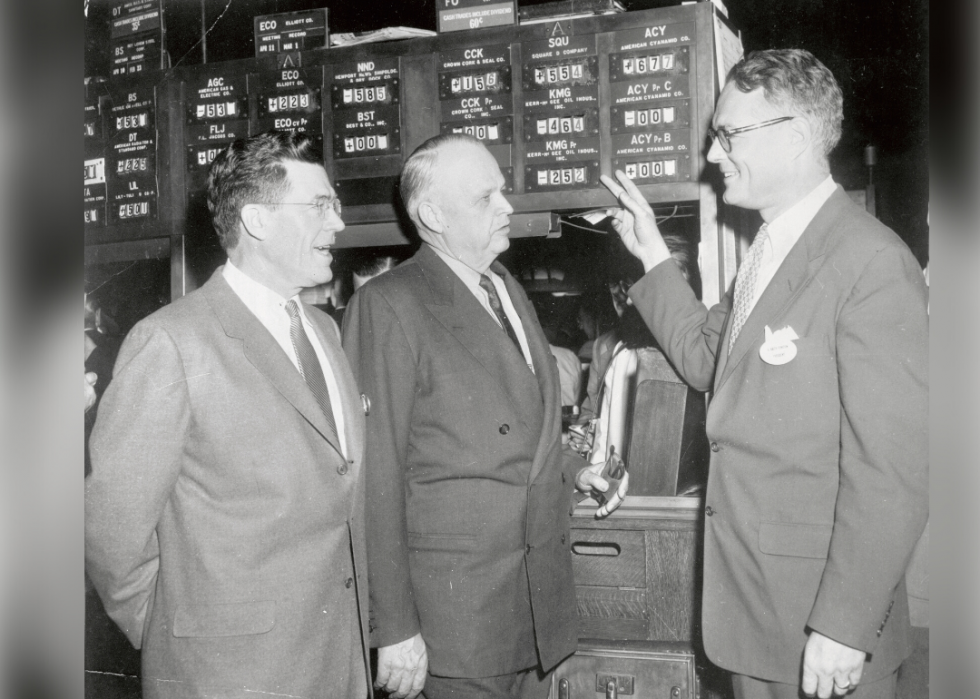
32 / 102
1951
- Return on the S&P 500: 23.68%
- Return on 3-month Treasury bills: 1.48%
Emil Schram ended his 10-year run as president of the NYSE. Schram was seen as a mediator between Wall Street and President Franklin D. Roosevelt's administration. In 1951, G. Keith Funston replaced Schram.
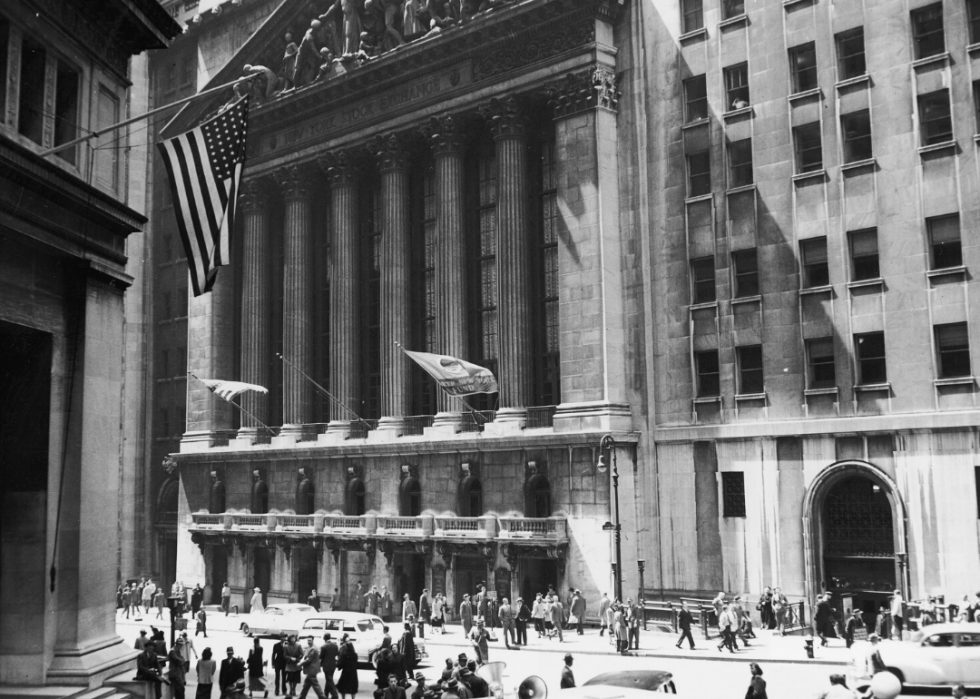
33 / 102
Eve Johnson/Hulton Archive // Getty Images
1952
- Return on the S&P 500: 18.15%
- Return on 3-month Treasury bills: 1.67%
In 1952, the NYSE eliminated Saturday workdays, and added 30 minutes to each day during the week. Monday through Friday, trading hours switch to 10 a.m. to 3:30 p.m. ET.
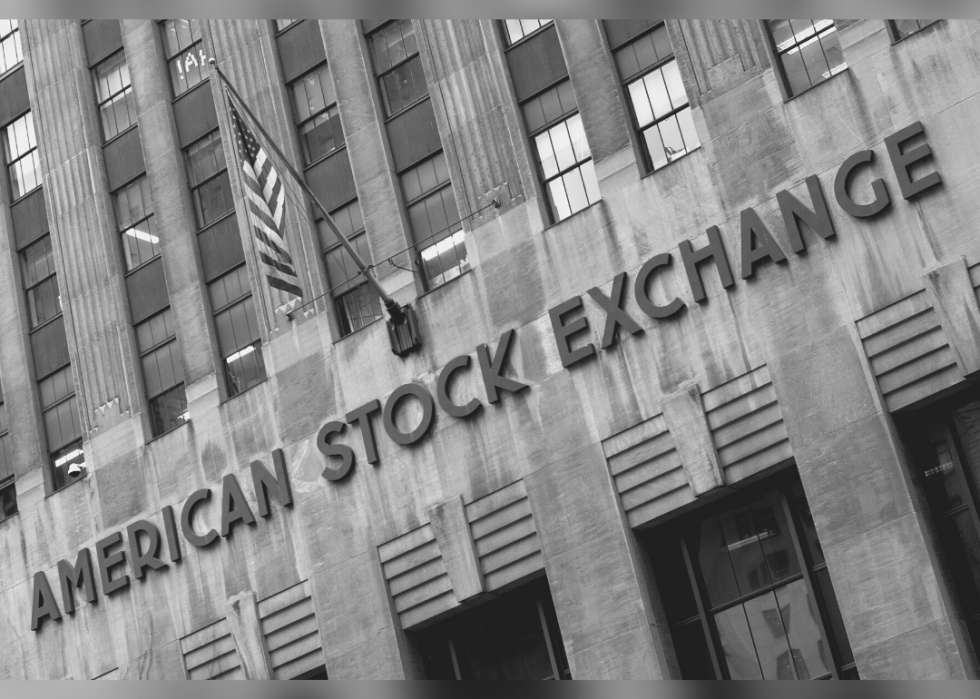
34 / 102
Natalia Bratslavsky // Shutterstock
1953
- Return on the S&P 500: -1.21%
- Return on 3-month Treasury bills: 1.89%
The New York Curb Exchange changed its name to the American Stock Exchange in 1953. The Curb Exchange was started by curbstone brokers, who sold stocks on curbsides near Wall Street. Today, the Exchange is known as NYSE American.
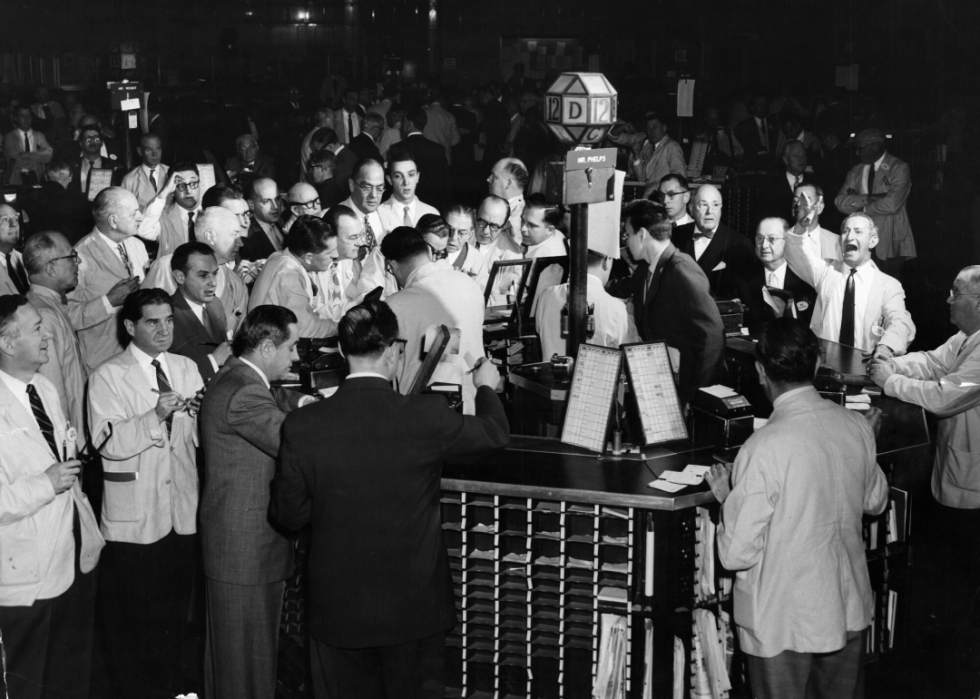
35 / 102
Pictorial Parade/Archive Photos // Getty Images
1954
- Return on the S&P 500: 52.56%
- Return on 3-month Treasury bills: 0.96%
For the first time since 1929, the Dow topped 300. By the end of 1954, it reached an all-time high of 404.39.
You may also like: History of manufacturing in America
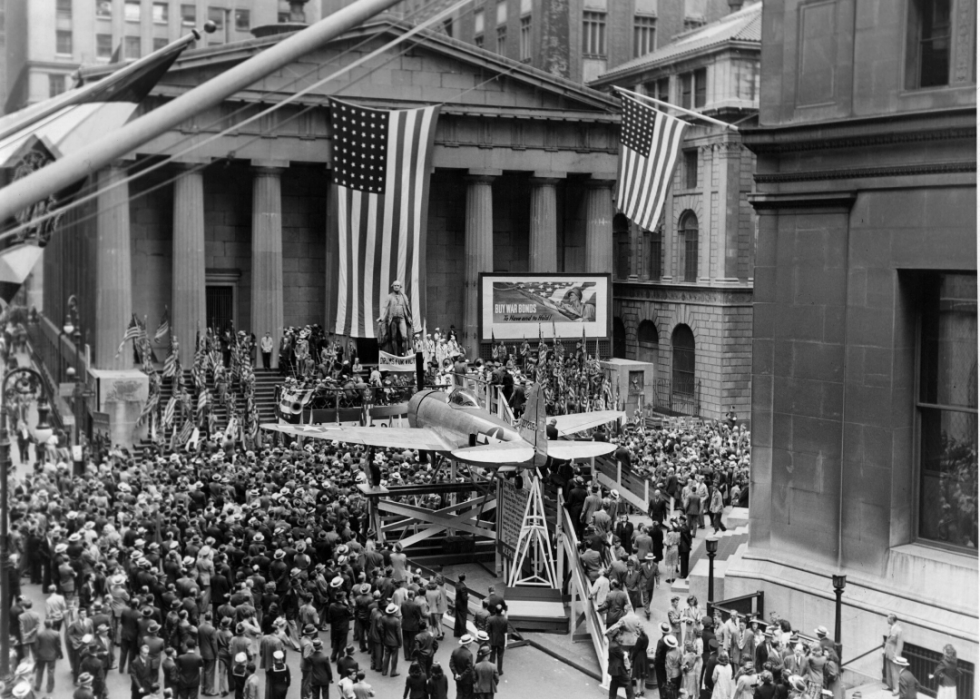
36 / 102
Lawrence Thornton/Archive Photos // Getty Images
1955
- Return on the S&P 500: 32.6%
- Return on 3-month Treasury bills: 1.66%
After jumping more than 43% in 1954, the stock market continued its climb in 1955. The Dow finished the year at 488.40, a more than 20% increase from the previous year. Sony made its stock available to the public.
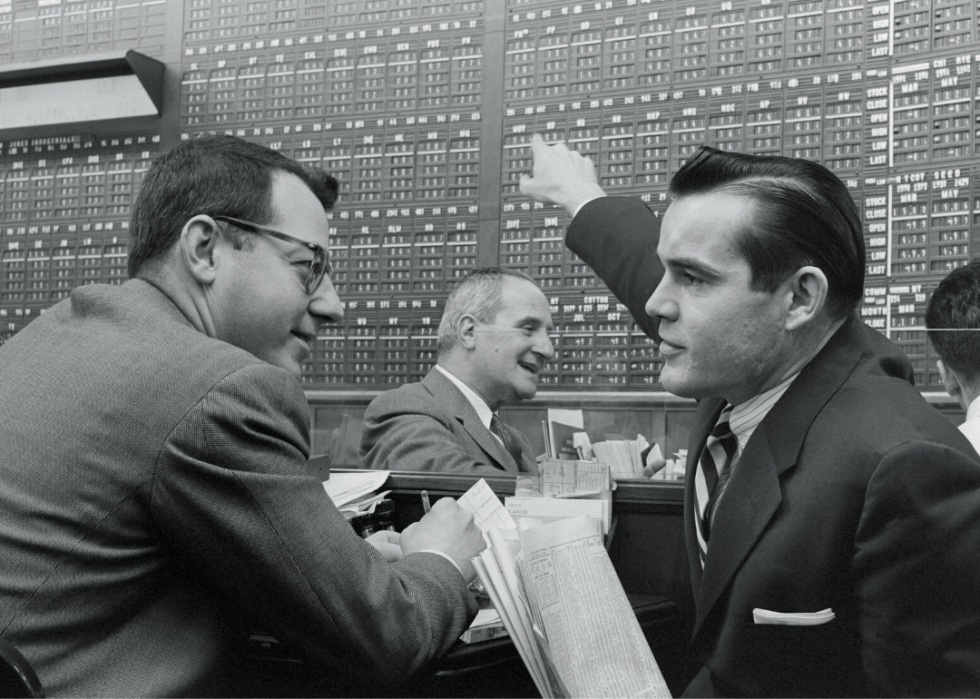
37 / 102
1956
- Return on the S&P 500: 7.44%
- Return on 3-month Treasury bills: 2.56%
Leonard Ross became a national sensation when, at 10, he won a TV quiz show by correctly answering questions about the stock market. In 1956, he became the first guest ringer of the NYSE's opening bell.
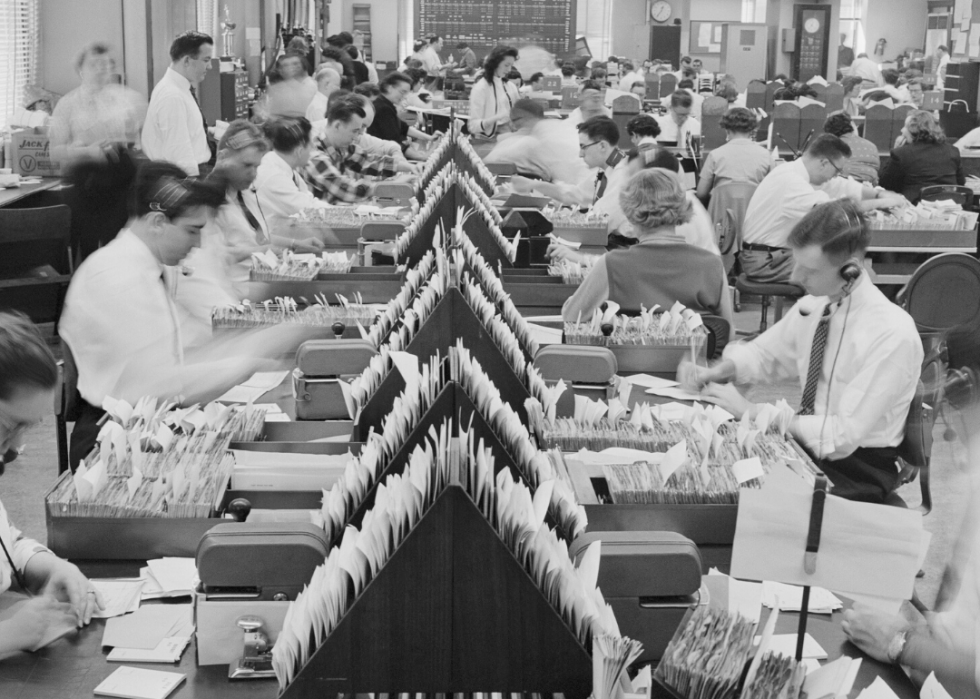
38 / 102
1957
- Return on the S&P 500: -10.46%
- Return on 3-month Treasury bills: 3.23%
In 1957, Standard & Poor's introduced its 500 index, which tracks the performance of the top 500 American companies. The first S&P 500 index tracked 425 industrial, 15 rail, and 60 utility stocks.
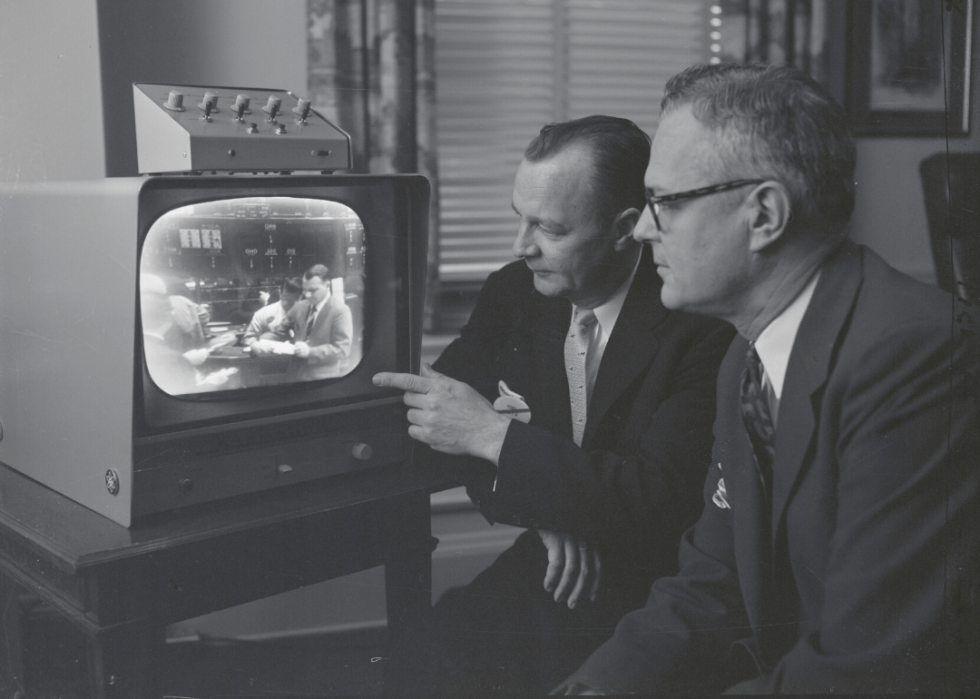
39 / 102
1958
- Return on the S&P 500: 43.72%
- Return on 3-month Treasury bills: 1.78%
Perhaps the most famous face in stock market history may have been born this year. Peter Tuchman has often been photographed during iconic economic moments in U.S. history.
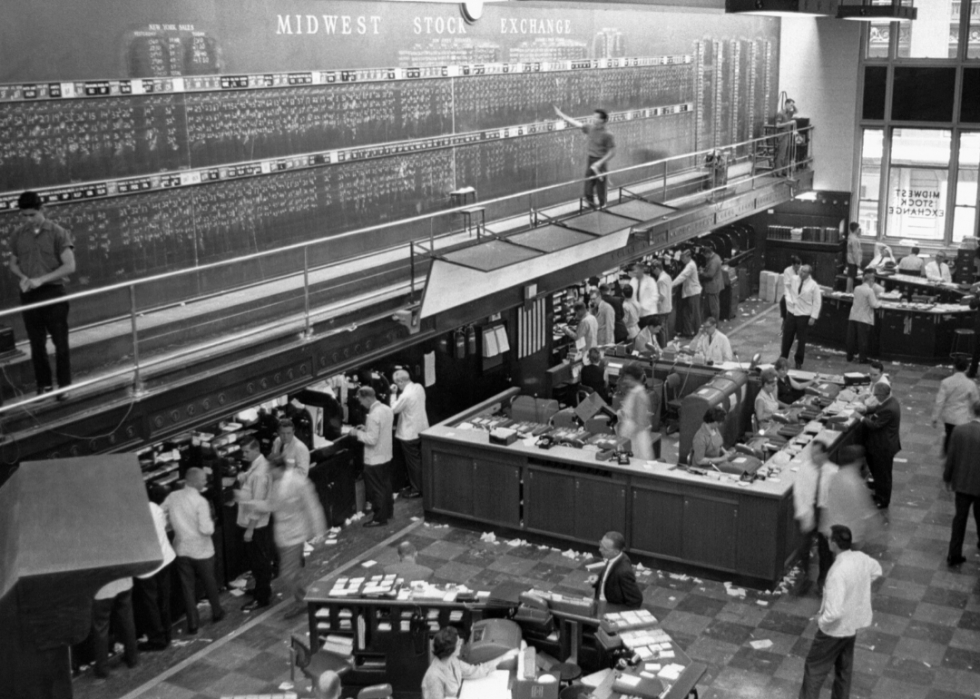
40 / 102
Underwood Archives // Getty Images
1959
- Return on the S&P 500: 12.06%
- Return on 3-month Treasury bills: 3.26%
The NYSE was not the only major American stock exchange. In 1959, the New Orleans Stock Exchange merged with the Midwest Stock Exchange, which today is known as the Chicago Stock Exchange. Today, the Chicago Stock Exchange is under the NYSE umbrella.
You may also like: Jobs that might not exist in 50 years
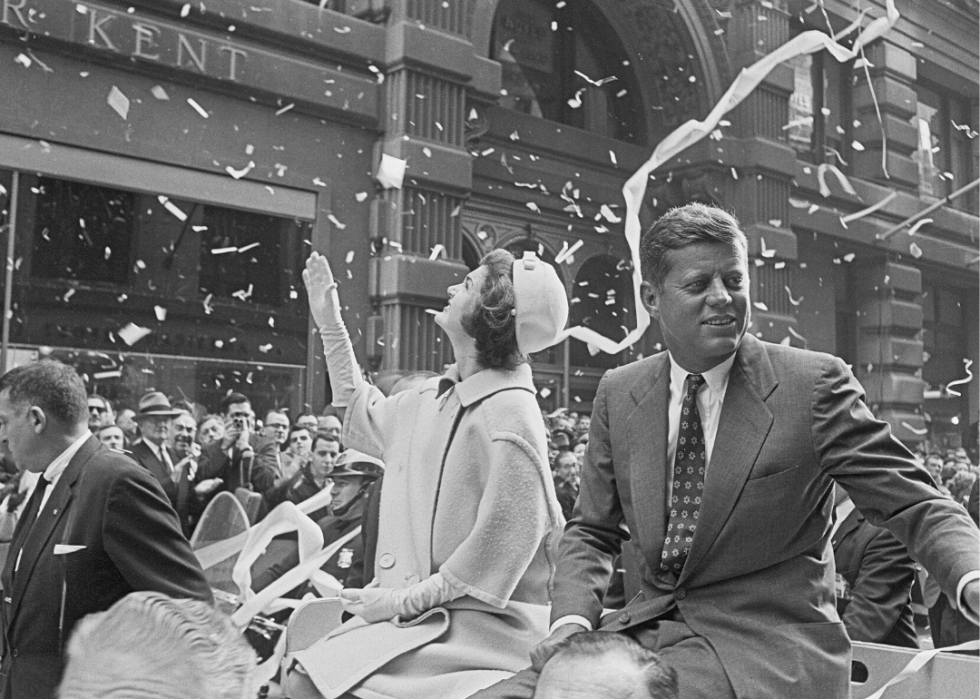
41 / 102
1960
- Return on the S&P 500: 0.34%
- Return on 3-month Treasury bills: 3.05%
In the early 1960s, New York's financial district, including Wall Street, was the epicenter of a series of ticker tape parades. Business did not come to a screeching halt, but many workers paused their days to acknowledge sports champions and other dignitaries in these almost-monthly occurrences. During one such parade in 1960, future American president John F. Kennedy and his wife Jacqueline were greeted by throngs of fans in downtown Manhattan.
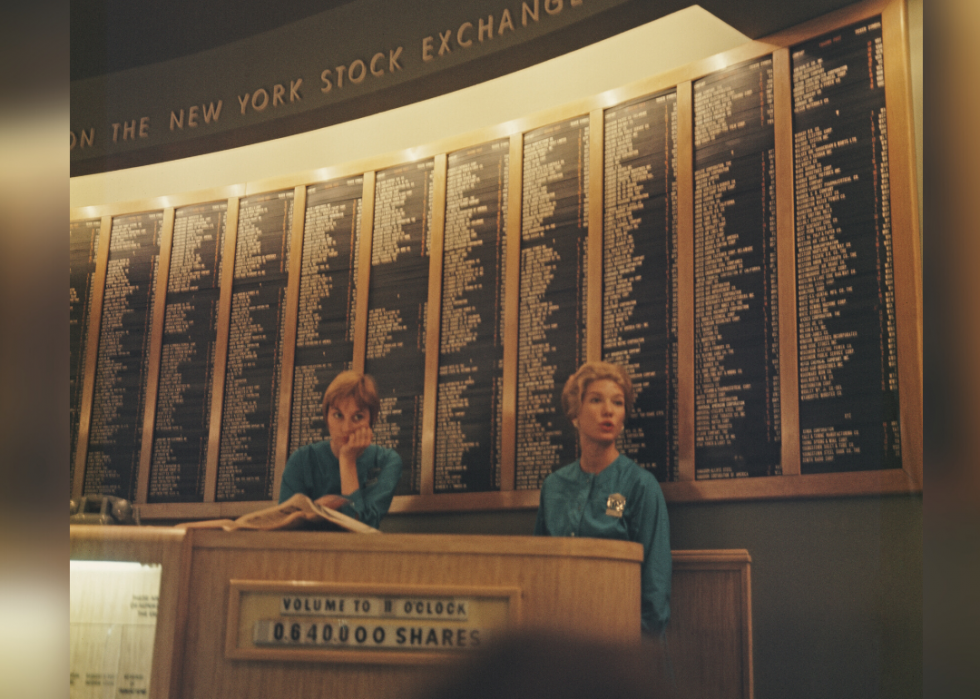
42 / 102
Byron Coroneos/Pix/Michael Ochs Archives // Getty Images
1961
- Return on the S&P 500: 26.64%
- Return on 3-month Treasury bills: 2.27%
The Dow was nearing 700 in 1961, but a few political events caused worry in the market. In April, the Bay of Pigs exacerbated Cold War tension, and by December, the stock market transformed into a bear market.
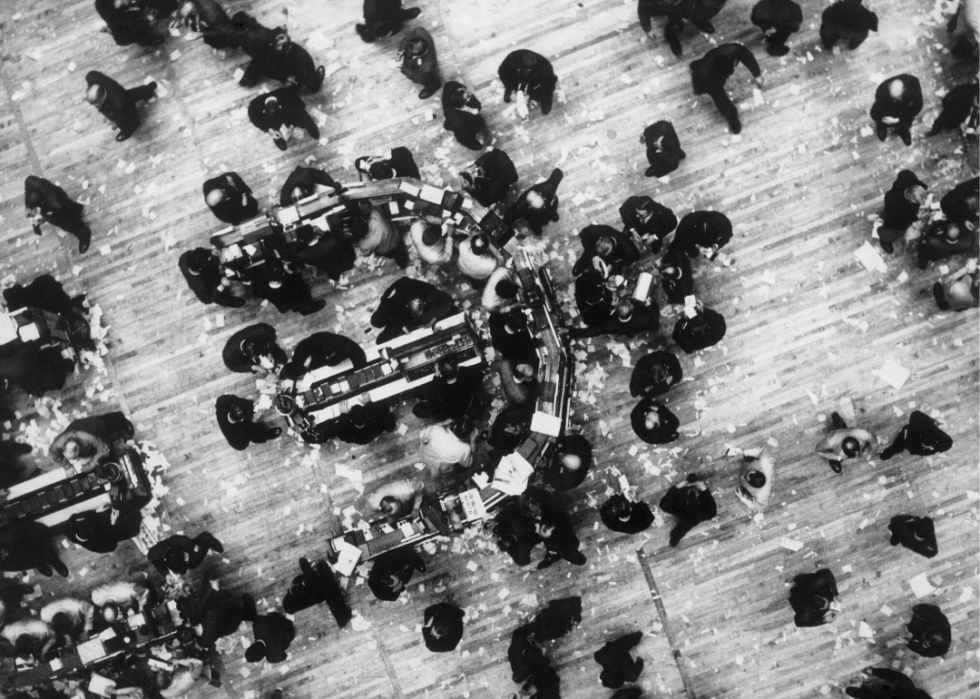
43 / 102
Claude Jacoby/ullstein bild // Getty Images
1962
- Return on the S&P 500: -8.81%
- Return on 3-month Treasury bills: 2.78%
The bear market that began in 1961 continued on into the summer of 1962, and became known as the Kennedy Slide. By the end of 1962, the Dow fell more than 10% compared to the end of 1961.
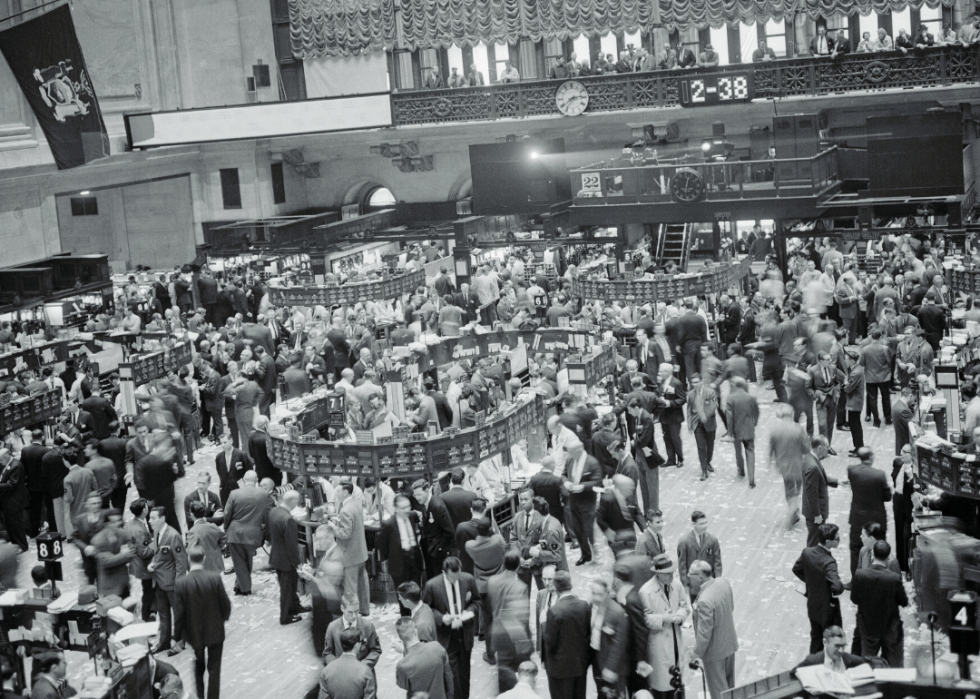
44 / 102
1963
- Return on the S&P 500: 22.61%
- Return on 3-month Treasury bills: 3.11%
The death of President Kennedy in 1963 affected almost every aspect of American life. A clerk ran down to the market floor and yelled that the president was shot and the exchange closed by 2:07 p.m. ET. Prices dipped and traders cried as they tried to process the news.
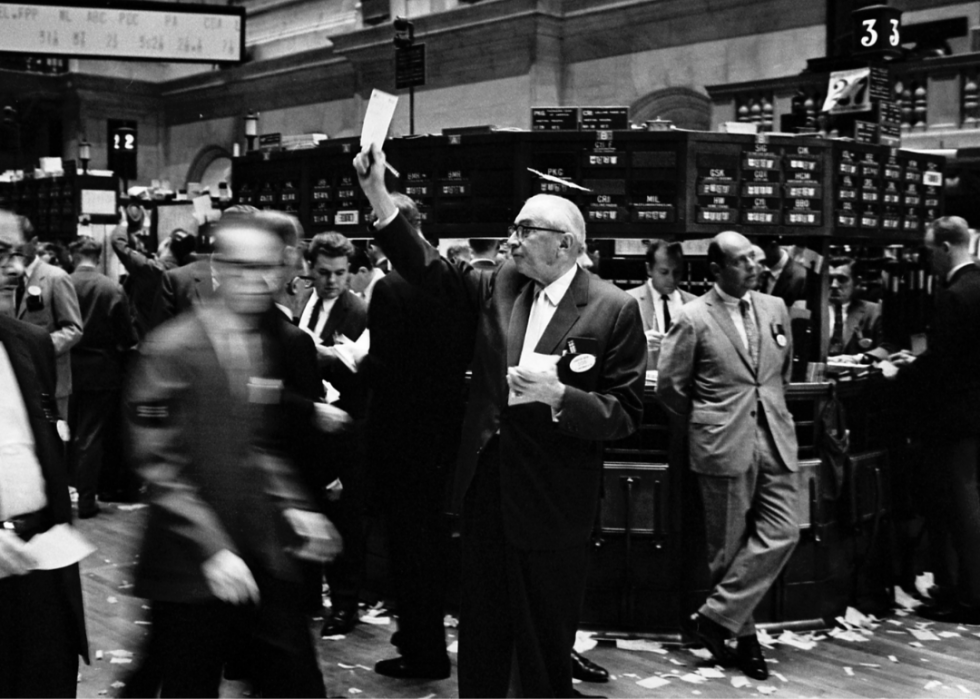
45 / 102
Thomas J. O'Halloran // Library of Congress
1964
- Return on the S&P 500: 16.42%
- Return on 3-month Treasury bills: 3.51%
President Lyndon B. Johnson signed the Kennedy tax cuts, which slashed federal income tax about 20%, into law in 1964. President Kennedy had trouble passing the initiative while he was in office, but after his death, Johnson was devoted to carrying on Kennedy's plan.
You may also like: States with the biggest agriculture industry
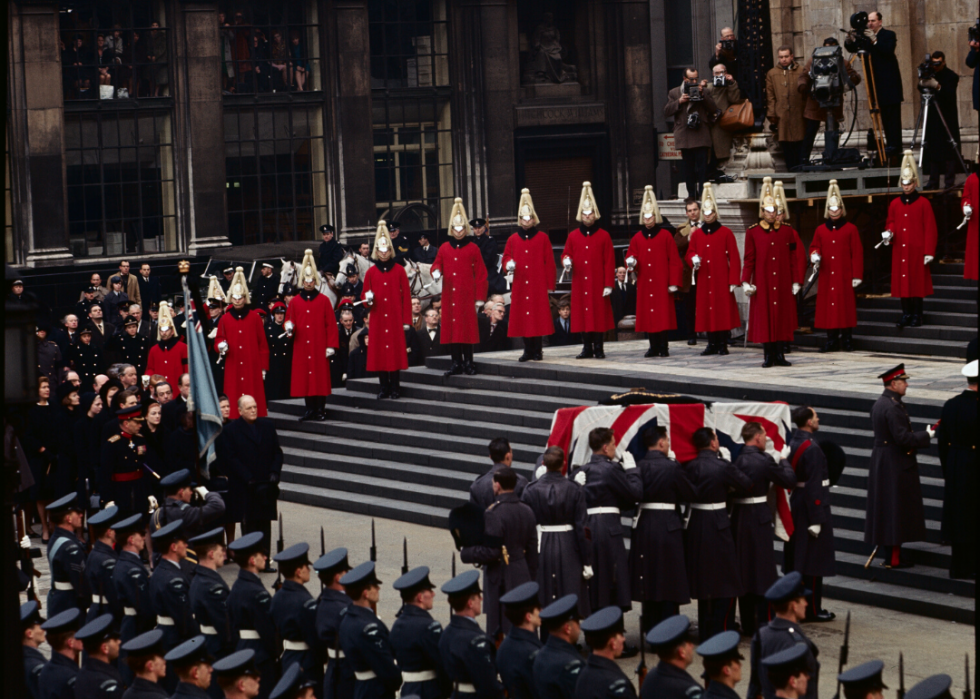
46 / 102
Bettmann/Corbis // Getty Images
1965
- Return on the S&P 500: 12.4%
- Return on 3-month Treasury bills: 3.9%
When former British leader Winston Churchill died on Jan. 22, 1965, the NYSE closed for two minutes the following day to honor the longtime American ally. By the end of the year, the Dow was inching toward 1,000, closing at 969.26.
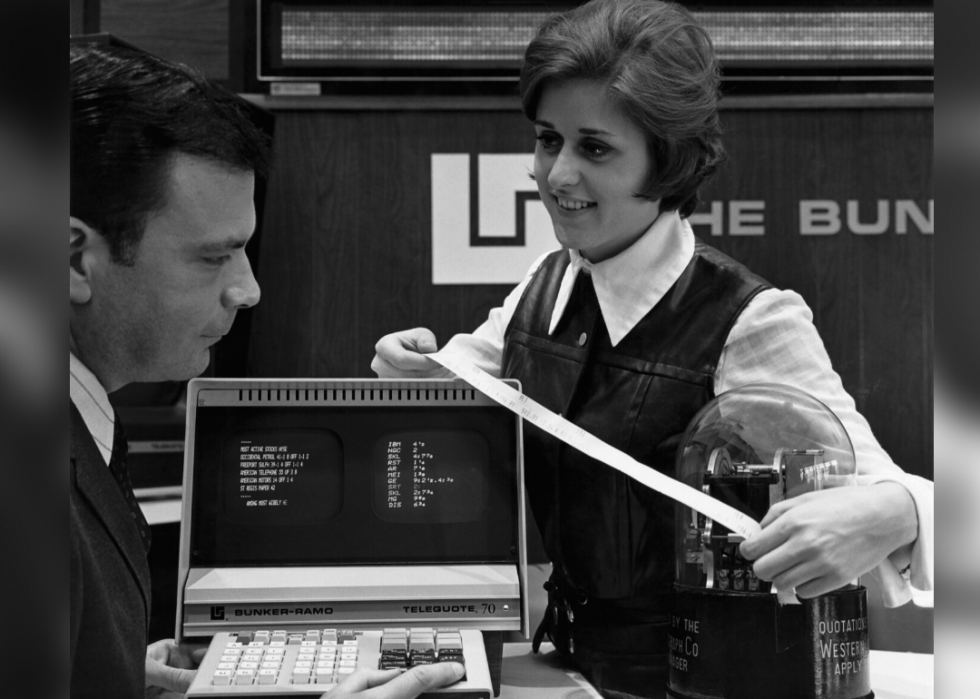
47 / 102
Underwood Archives // Getty Images
1966
- Return on the S&P 500: -9.97%
- Return on 3-month Treasury bills: 4.84%
In July 1966, the NYSE introduced an index of common stocks. The Common Stock Index measured the price of more than 1,250 listings. Later, it was named the NYSE Composite Index.
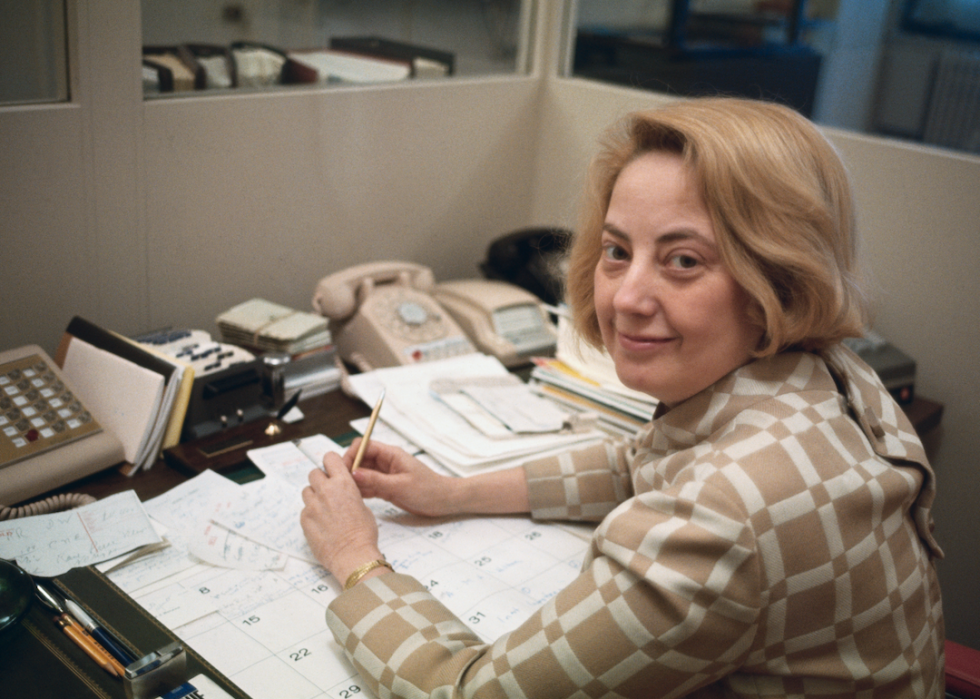
48 / 102
1967
- Return on the S&P 500: 23.8%
- Return on 3-month Treasury bills: 4.33%
Muriel Siebert became the first woman to earn a seat on the NYSE in 1967. Siebert then started her own brokerage, Muriel Siebert & Co. Throughout her life, Siebert, who also encountered anti-Semitism during her career, continually advocated for more equality throughout the industry.
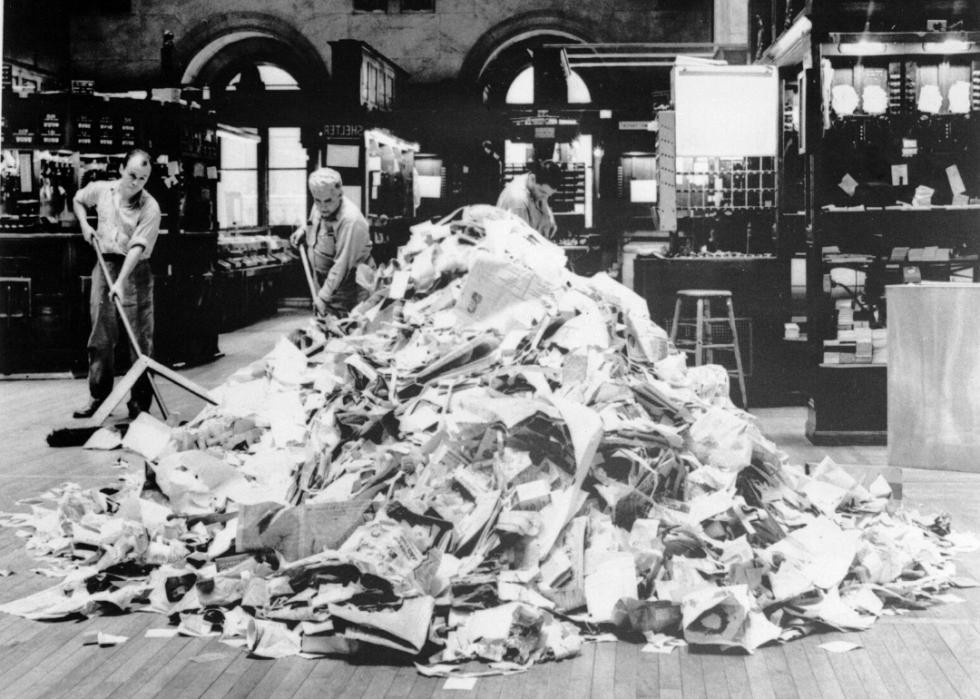
49 / 102
1968
- Return on the S&P 500: 10.81%
- Return on 3-month Treasury bills: 5.26%
Daily trading hit 12 million shares a day, but this action created an overwhelming glut of paperwork. In 1968, trading was restricted to four days per week to combat backlogs of paper during this "paperwork crisis."
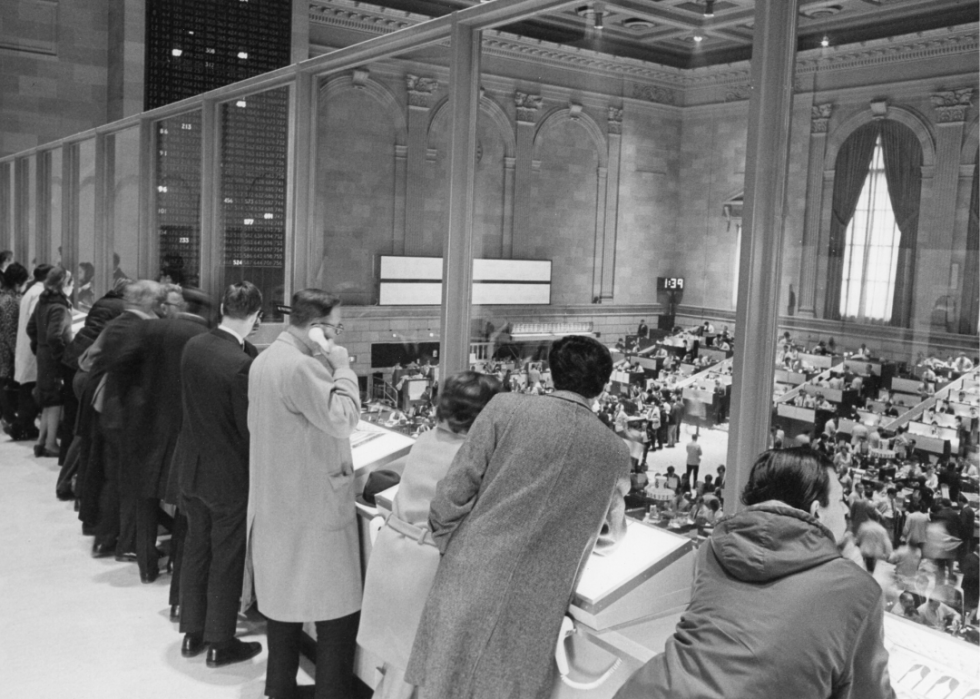
50 / 102
United States Information Agency/PhotoQuest // Getty Images
1969
- Return on the S&P 500: -8.24%
- Return on 3-month Treasury bills: 6.56%
A February snowstorm closed the NYSE for 1.5 days in 1969, as more than 15 inches of snow fell across New York City. Five months later, the NYSE closed for more-celebratory reasons, when Apollo 11 landed on the moon.
You may also like: Best jobs that require a bachelor's degree
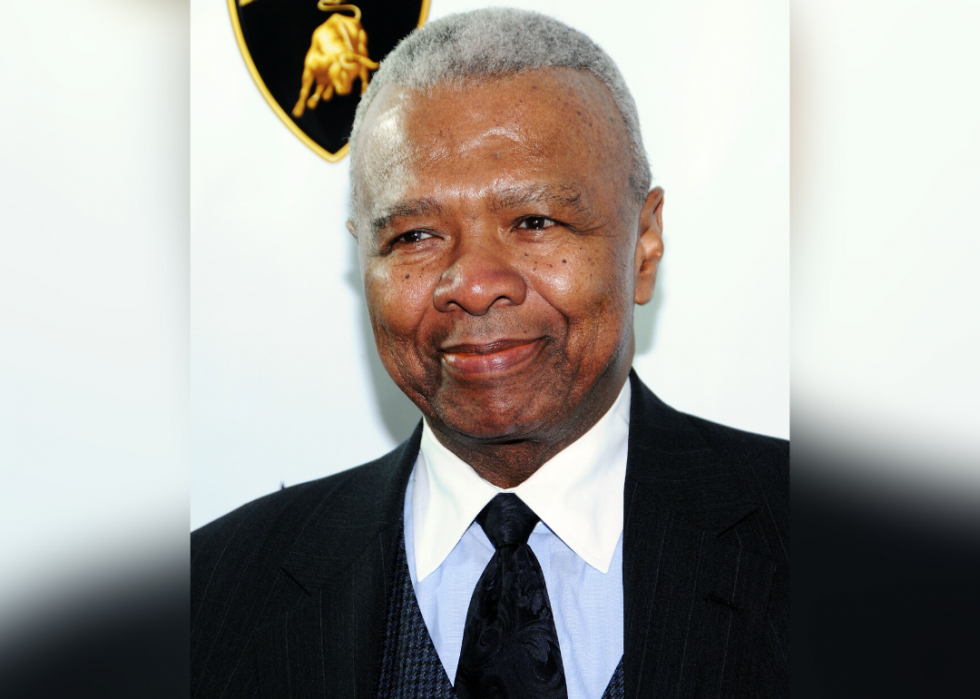
51 / 102
Desiree Navarro/WireImage // Getty Images
1970
- Return on the S&P 500: 3.56%
- Return on 3-month Treasury bills: 6.69%
On Feb. 13, 1970, Joseph L. Searles III became recognized as the NYSE's first African-American member. Searles said, though, that others preceded him without much attention. Before trading stocks, Searles played football for the New York Giants.
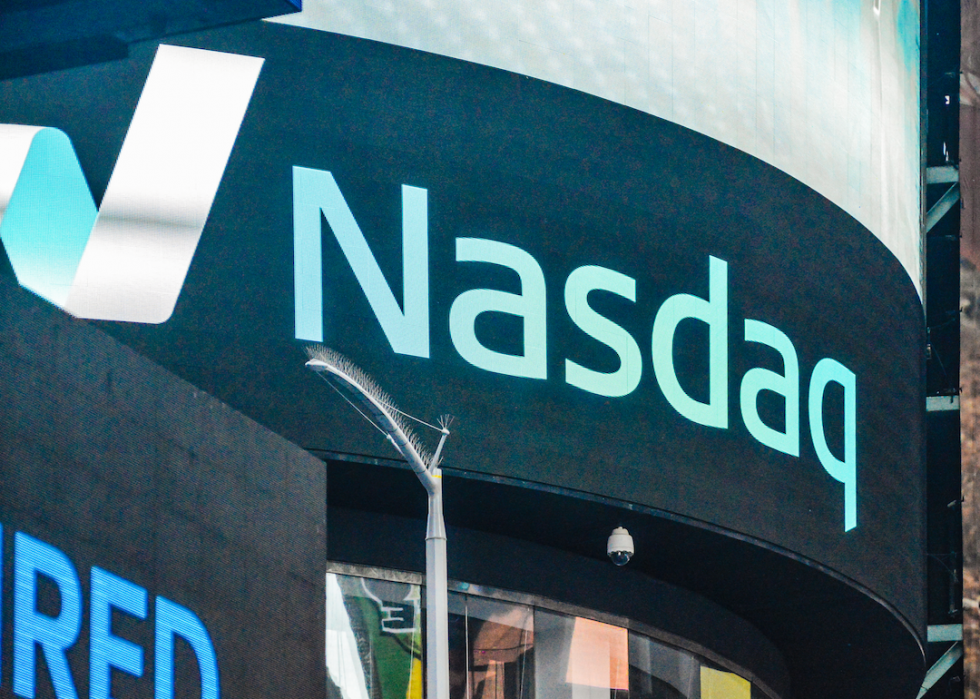
52 / 102
Goran Vrhovac // Shutterstock
1971
- Return on the S&P 500: 14.22%
- Return on 3-month Treasury bills: 4.54%
In an effort to move trading toward technology and away from in-person transactions, the Nasdaq Stock Market launched for business in 1971. Meanwhile, the NYSE became a not-for-profit organization.
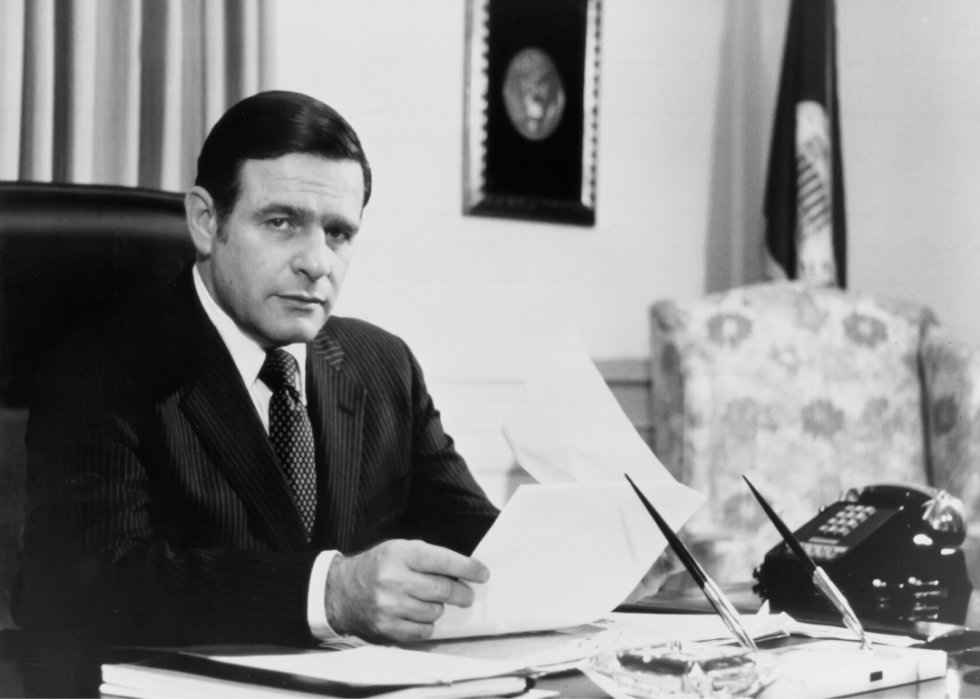
53 / 102
PL Gould/IMAGES // Getty Images
1972
- Return on the S&P 500: 18.76%
- Return on 3-month Treasury bills: 3.95%
Robert W. Haack ended his reign as president of the NYSE in 1972. Haack claimed he wanted to spend more time with his family and get away from the "hectic" pace of trading. Haack earned $125,000 per year from the job.
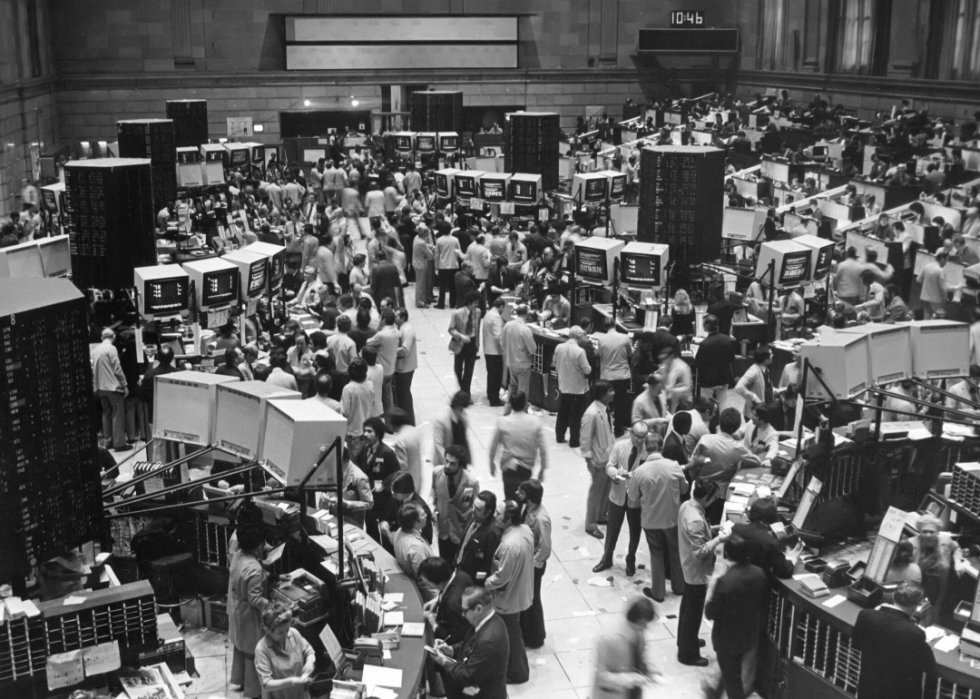
54 / 102
PL Gould/Images Press // Getty Images
1973
- Return on the S&P 500: -14.31%
- Return on 3-month Treasury bills: 6.73%
Fallout from the Watergate scandal and unrest in the Middle East led to a prolonged bear market beginning in January 1973. The Dow reached an all-time high of 1051.70, but finished the year at 850.
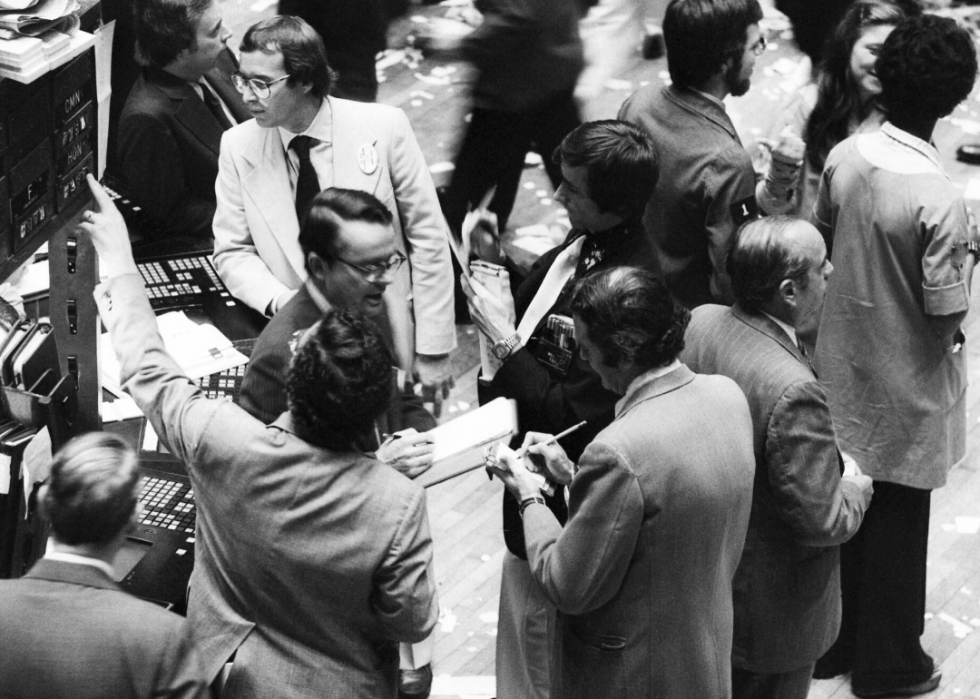
55 / 102
Bettmann Archive // Getty Images
1974
- Return on the S&P 500: -25.9%
- Return on 3-month Treasury bills: 7.78%
In October, the NYSE extended trading hours from 10 a.m. to 4 p.m. ET. The ongoing bear market extended to December 1974, when the Dow closed the year at 616.24, more than 27% down from the previous year.
You may also like: 25 companies you might not know are owned by Disney
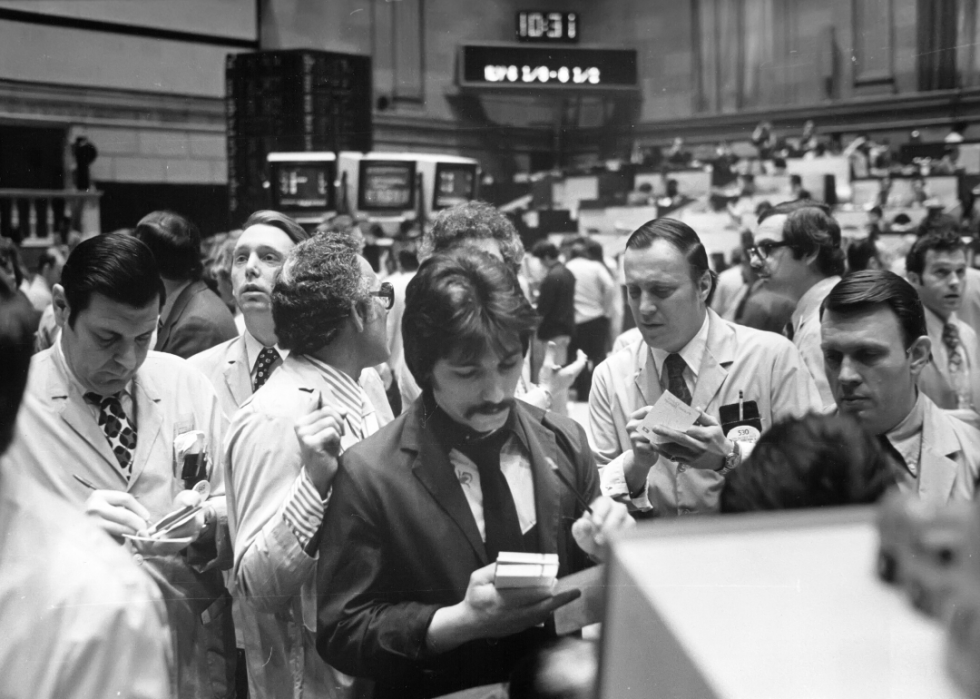
56 / 102
PL Gould/Images Press // Getty Images
1975
- Return on the S&P 500: 37%
- Return on 3-month Treasury bills: 5.99%
Fixed-rate commissions ended on May 1, 1975. May Day, as it became known in the industry, allowed many more Americans to find the stock market accessible, with lower-cost transactions.
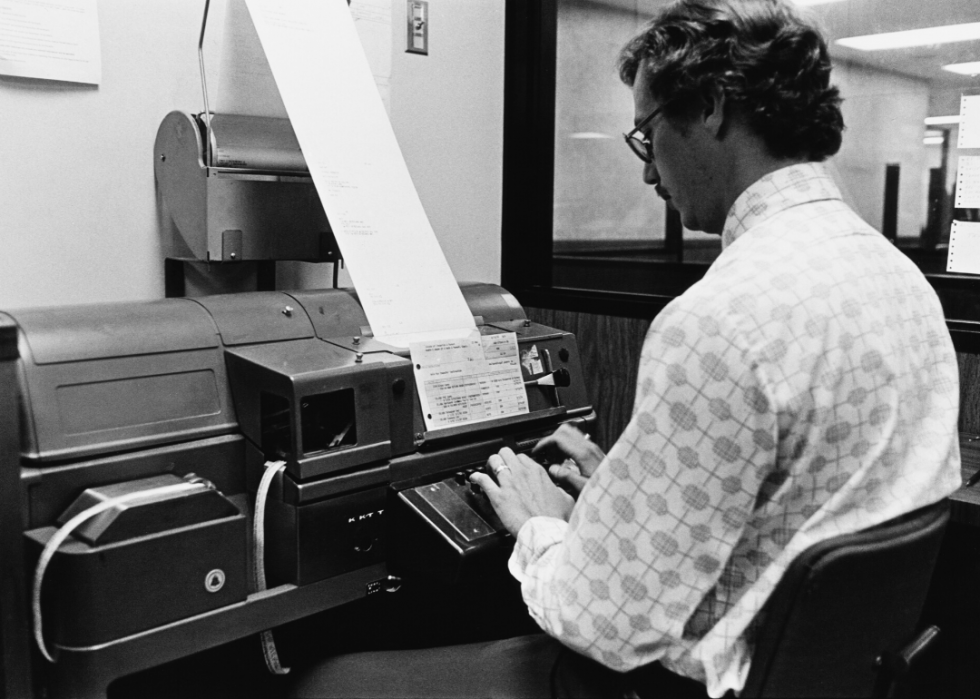
57 / 102
Barbara Alper // Getty Images
1976
- Return on the S&P 500: 23.83%
- Return on 3-month Treasury bills: 4.97%
The Vanguard First Index Investment Trust, the first retail index mutual fund, made its debut on Aug. 31, 1976. The Index allows individual investors "to buy into the broad market with a single purchase." Today, the Vanguard 500 Index Fund has billions in assets.

58 / 102
Allan Tannenbaum // Getty Images
1977
- Return on the S&P 500: -6.98%
- Return on 3-month Treasury bills: 5.13%
A major blackout across New York City caused the NYSE to close on July 14, 1977. For the year, the Dow ended down more than 17%, once again dropping below the 1,000 point mark.
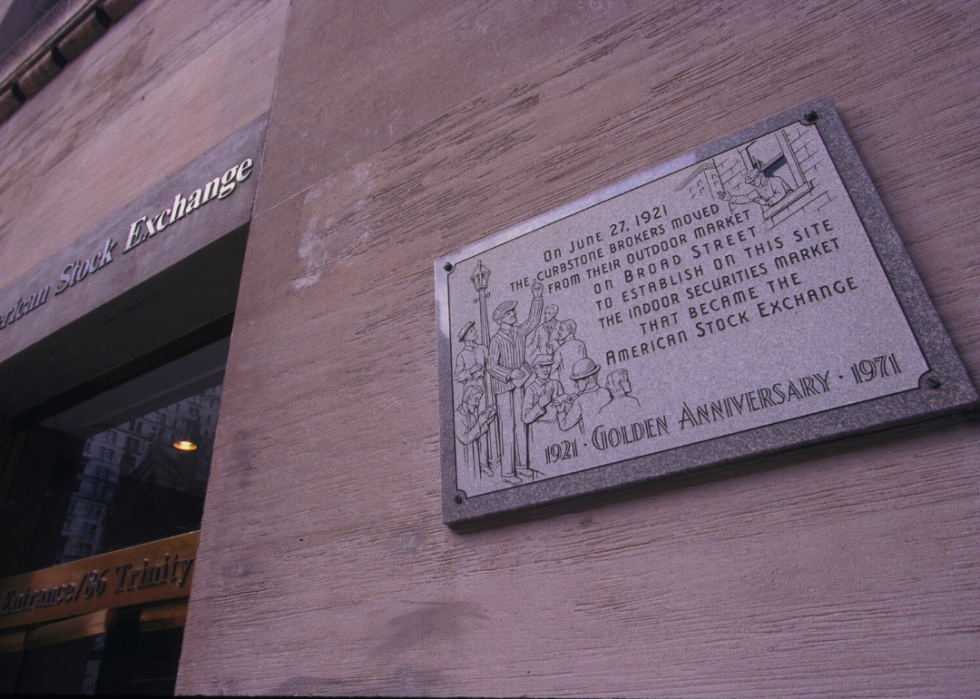
59 / 102
James Leynse/Corbis // Getty Images
1978
- Return on the S&P 500: 6.51%
- Return on 3-month Treasury bills: 6.93%
On June 2, 1978, the American Stock Exchange Building at 86 Trinity Place was added to the National Register of Historic Places. Similarly, the New York Stock Exchange Building at 11 Wall St. was also added to the register.
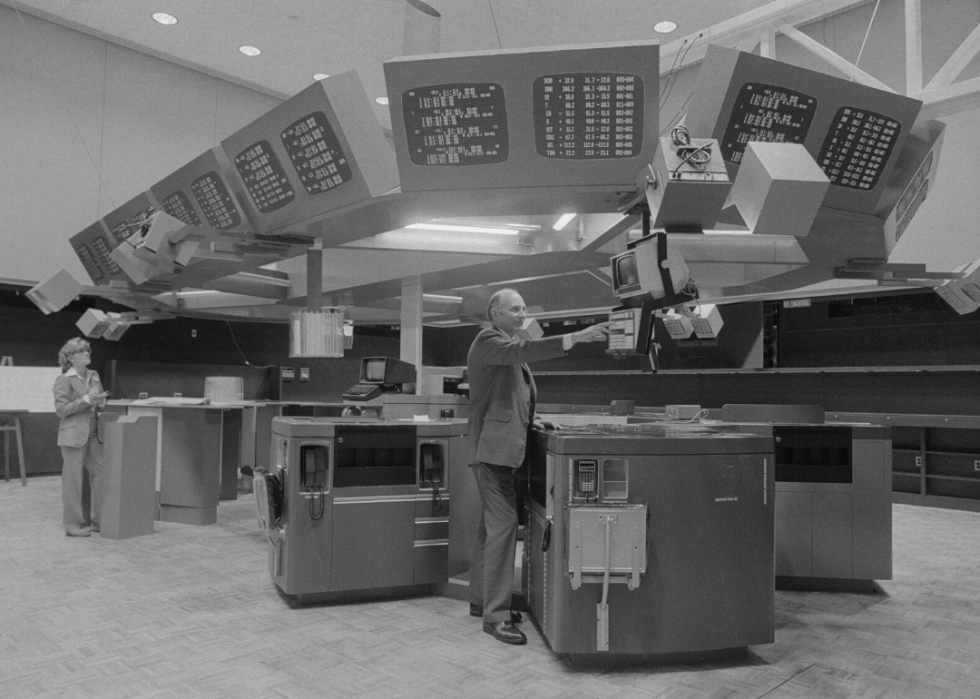
60 / 102
1979
- Return on the S&P 500: 18.52%
- Return on 3-month Treasury bills: 9.94%
Beginning in 1979, the trading floor of the American Stock Exchange expanded to accommodate the rise in stock and options trading. The construction of two balconies and takeover of a nearby building at 22 Thames St. occur over the next 10 years.
You may also like: Best value colleges in America
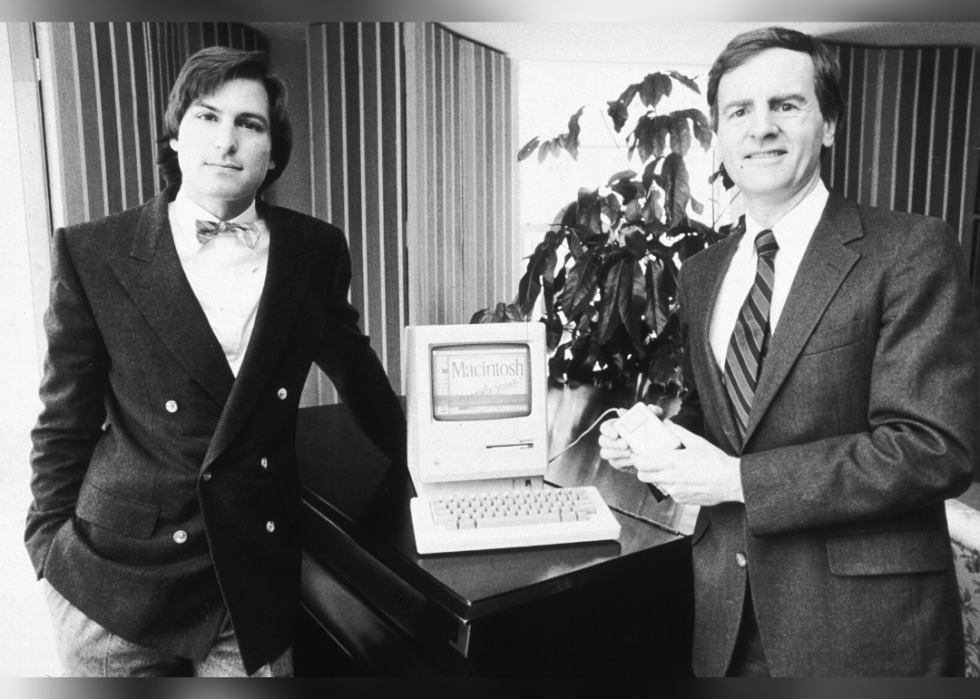
61 / 102
Marilyn K. Yee/New York Times Co. // Getty Images
1980
- Return on the S&P 500: 31.74%
- Return on 3-month Treasury bills: 11.22%
Apple's initial public offering (IPO) in December 1980, sold 4.6 million shares, opening at $22 each. Steve Jobs reportedly made $217 million off the IPO. In 2020, Apple's price has mostly fluctuated between 250 and 300.
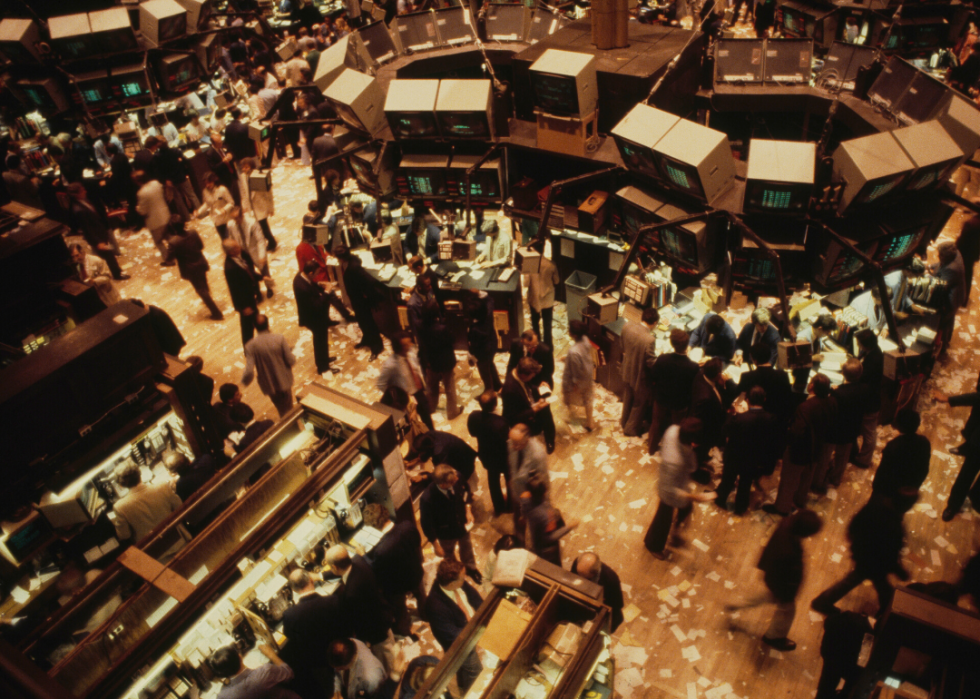
62 / 102
Barbara Alper // Getty Images
1981
- Return on the S&P 500: -4.7%
- Return on 3-month Treasury bills: 14.3%
In 1981, with renovations under way at the American Stock Exchange Building, the NYSE added infrastructure, like a new metal frame to hold up the weight of the floor and support new wiring for more-modern technologies being installed. The Dow closed the year at 875—the last year it would close below 1,000.
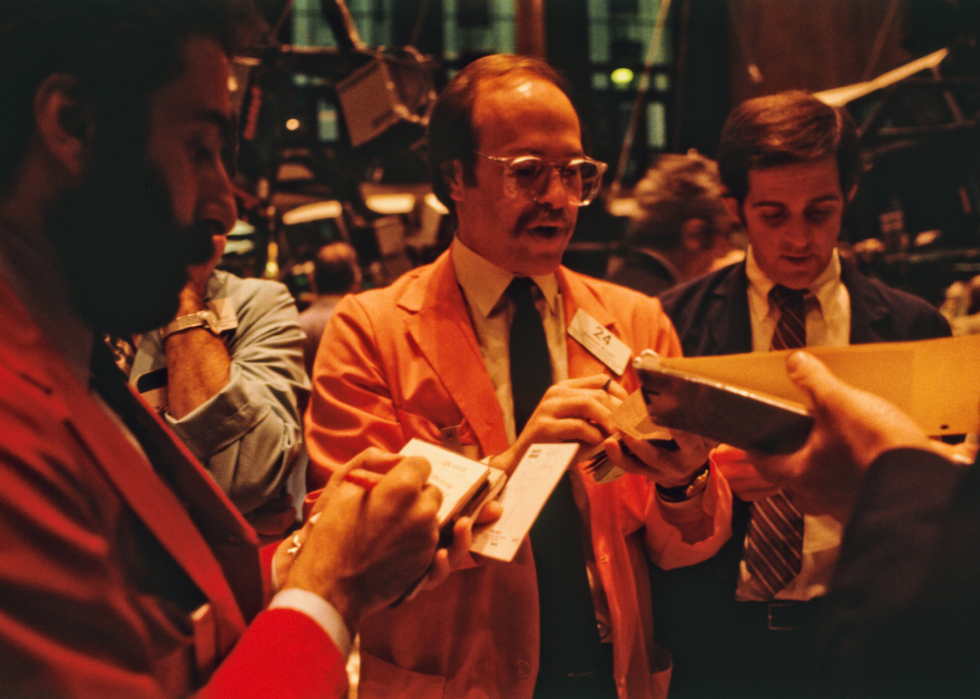
63 / 102
Barbara Alper // Getty Images
1982
- Return on the S&P 500: 20.42%
- Return on 3-month Treasury bills: 11.01%
In April 1982, the Chicago Mercantile Exchange began trading futures based on the S&P 500. The NYSE changed to a fully-automated computerized trading system by year's end and the Dow finished at 1,046.54, its highest year-end mark ever.
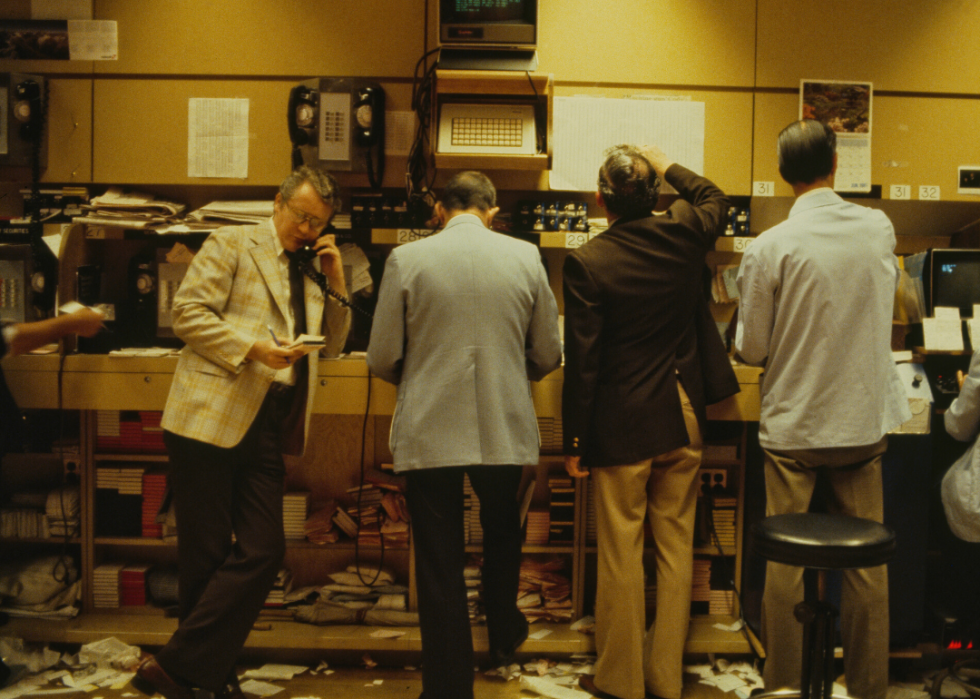
64 / 102
Barbara Alper // Getty Images
1983
- Return on the S&P 500: 22.34%
- Return on 3-month Treasury bills: 8.45%
In July, options contracts based on the S&P 500 index are now traded on the Chicago Board Options Exchange (CBOE). The Dow surpassed 1,100 for the first time in 1983, and finished up 20.27%.
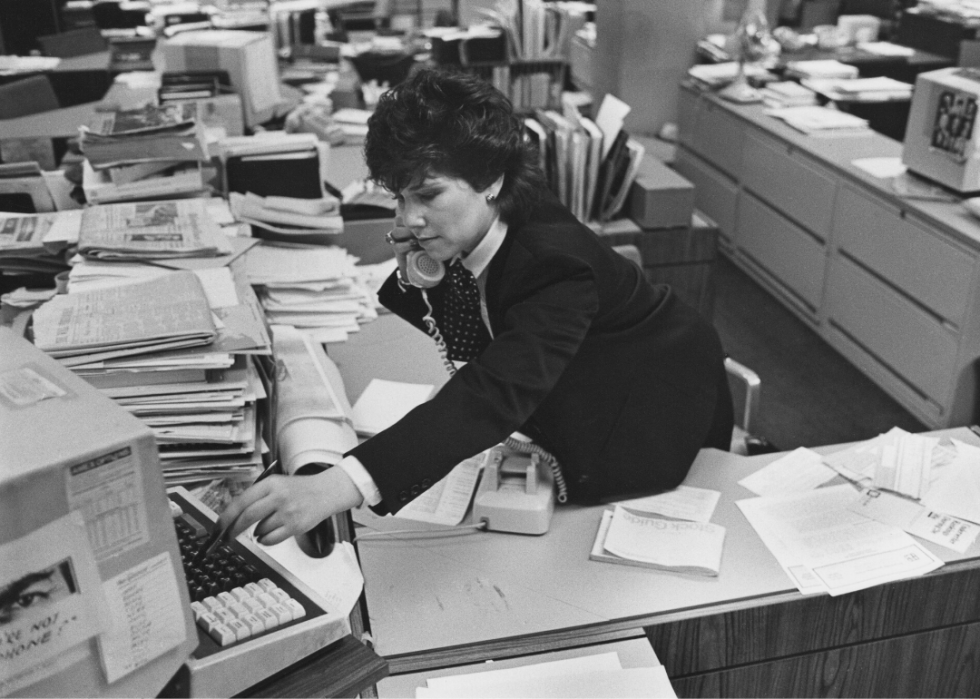
65 / 102
Barbara Alper // Getty Images
1984
- Return on the S&P 500: 6.15%
- Return on 3-month Treasury bills: 9.61%
John J. Phelan Jr. leaves his post as president of the NYSE in 1984. Toymakers and Tootsie Roll Industries were perceived as the biggest winners in the market, while volume of more than 23 billion shares marked the highest level in NYSE history.
You may also like: Cost of gas the year you started driving
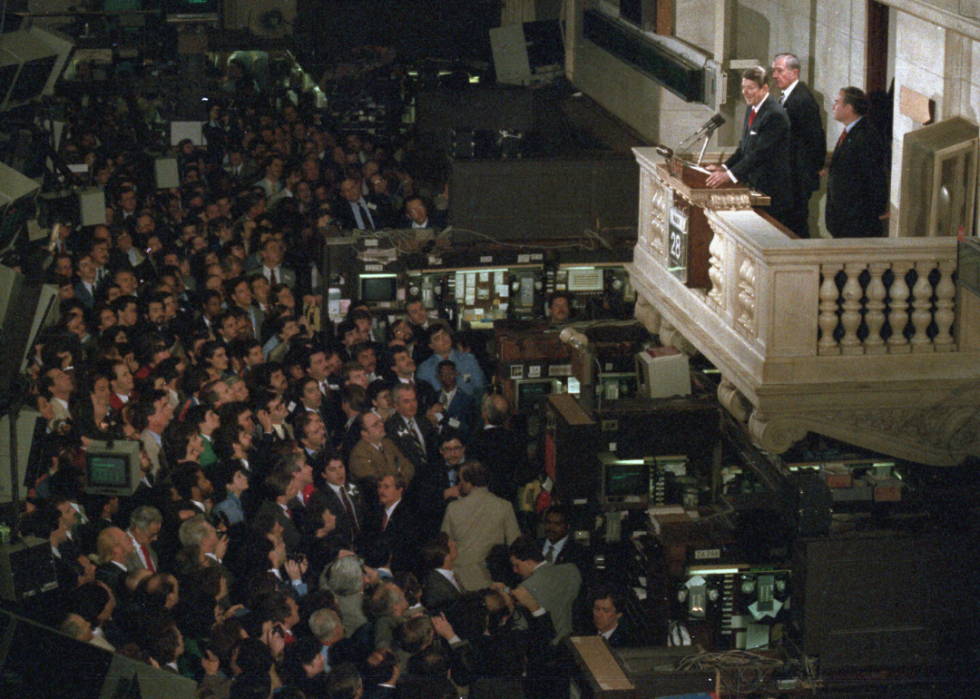
66 / 102
1985
- Return on the S&P 500: 31.24%
- Return on 3-month Treasury bills: 7.49%
Appearing on the market floor and declaring, "We're bullish on the American economy," Ronald Reagan became the first U.S. president to visit the NYSE while in office. Also in 1985, trading hours extended 30 minutes, from 9:30 a.m. to 4 p.m. ET.

67 / 102
Joe McNally // Getty Images
1986
- Return on the S&P 500: 18.49%
- Return on 3-month Treasury bills: 6.04%
Sun Microsystems, Oracle, and Microsoft all made IPOs in 1986. Microsoft opened at $21 and quickly jumped to $28. Today, Microsoft shares go for almost five times that amount.
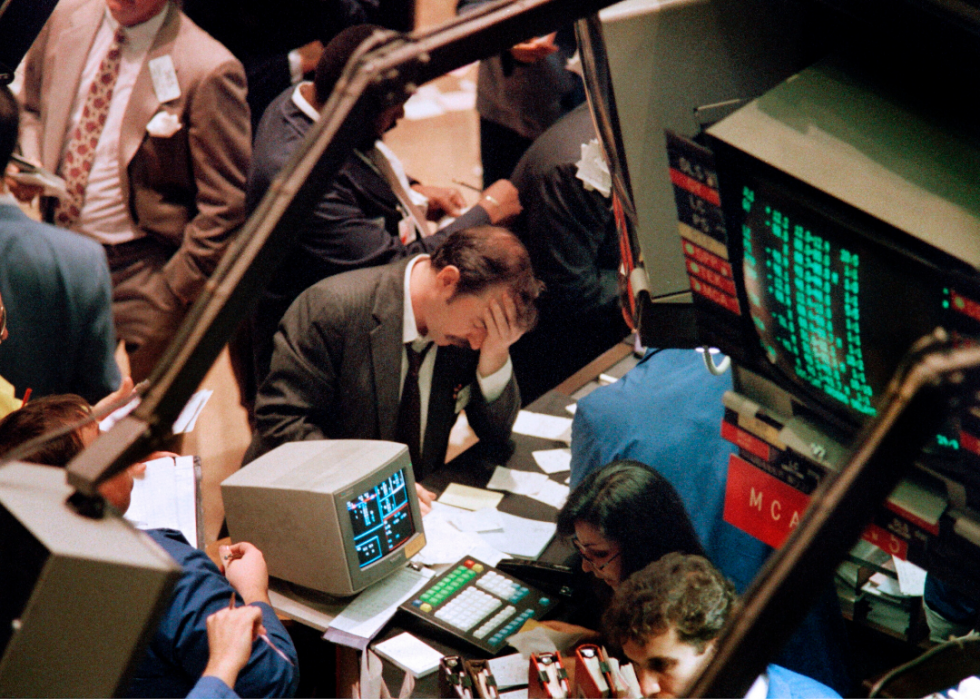
68 / 102
MARIA BASTONE/AFP // Getty Images
1987
- Return on the S&P 500: 5.81%
- Return on 3-month Treasury bills: 5.72%
After five years of tremendous growth, the stock market was shocked on Oct. 19, 1987, when Black Monday hit. The S&P 500 dropped 20.47%, its worst daily percentage loss at the time. The Dow plunged 22.6% due to an abundance of factors including worries about high interest rates, instability in the Persian Gulf, and computerized trading leading to more-frenzied sales.
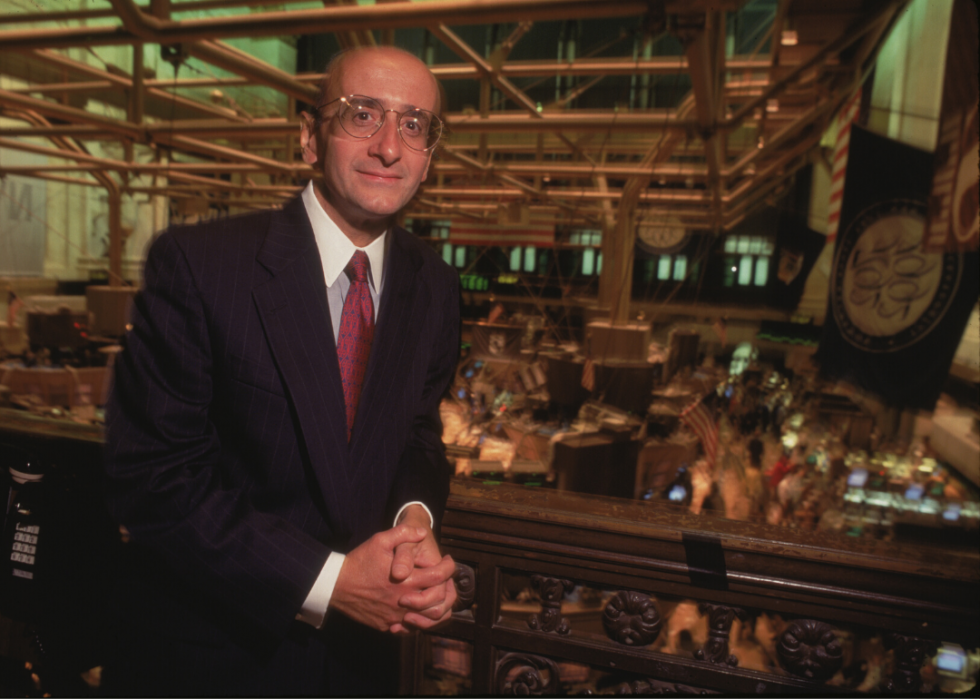
69 / 102
James Leynse/Corbis // Getty Images
1988
- Return on the S&P 500: 16.54%
- Return on 3-month Treasury bills: 6.45%
Shortly after presiding over the crash of 1987, Robert J. Birnbaum left his position as president of the NYSE. In 1988, Birnbaum was replaced by Richard Grasso, who once worked as a floor clerk at the NYSE.
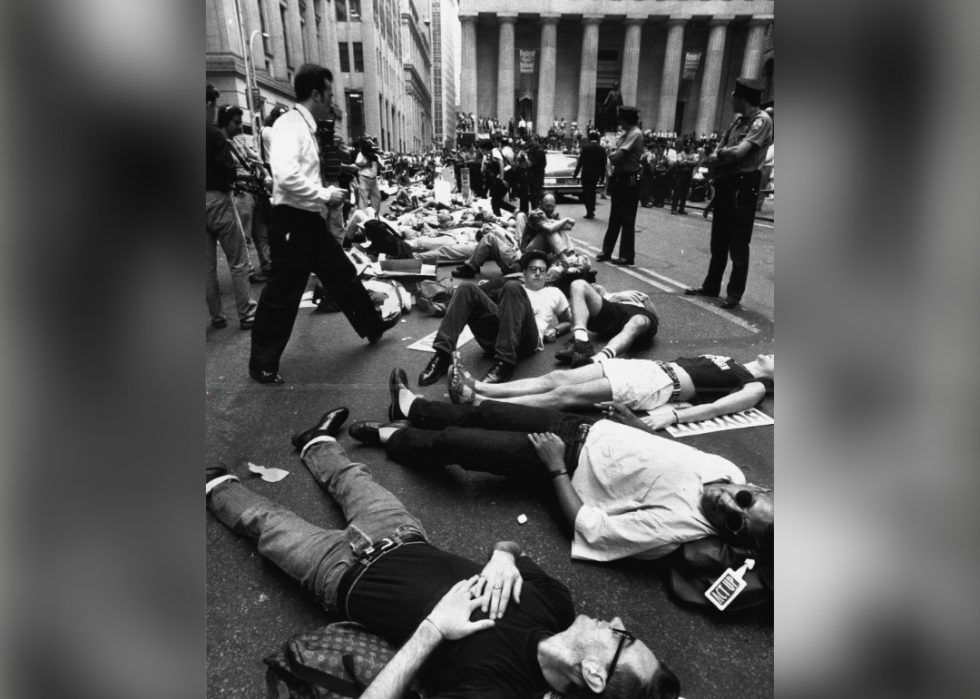
70 / 102
Louis Liotta/New York Post Archives/NYP Holdings, Inc. // Getty Images
1989
- Return on the S&P 500: 31.48%
- Return on 3-month Treasury bills: 8.11%
In September 1989, the AIDS Coalition to Unleash Power (ACT UP) protested at the NYSE. ACT UP was voicing its displeasure with drug companies charging high prices for AIDS medication; days later, the drugs in question were lowered almost 20% in price.
You may also like: Most common jobs in America 100 years ago
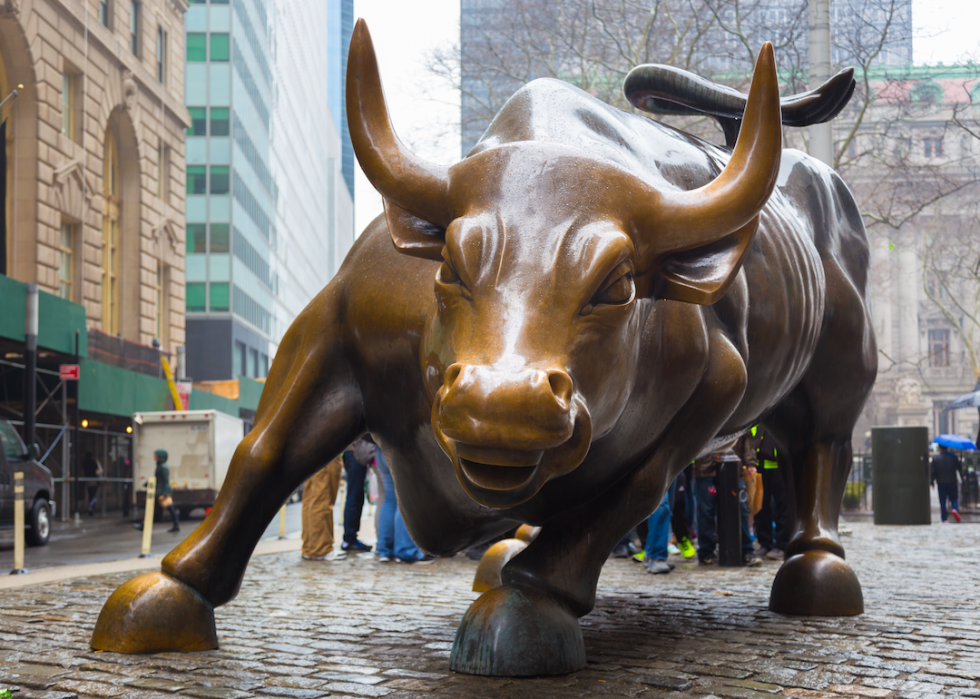
71 / 102
Matej Kastelic // Shutterstock
1990
- Return on the S&P 500: -3.06%
- Return on 3-month Treasury bills: 7.55%
The NYSE lost $3 million in 1990, and the Dow ended the year down 4.34%. Still, the market was strong, with the Dow almost reaching 3,000 for the first time, coming in at a high of 2,999.75 in 1990.
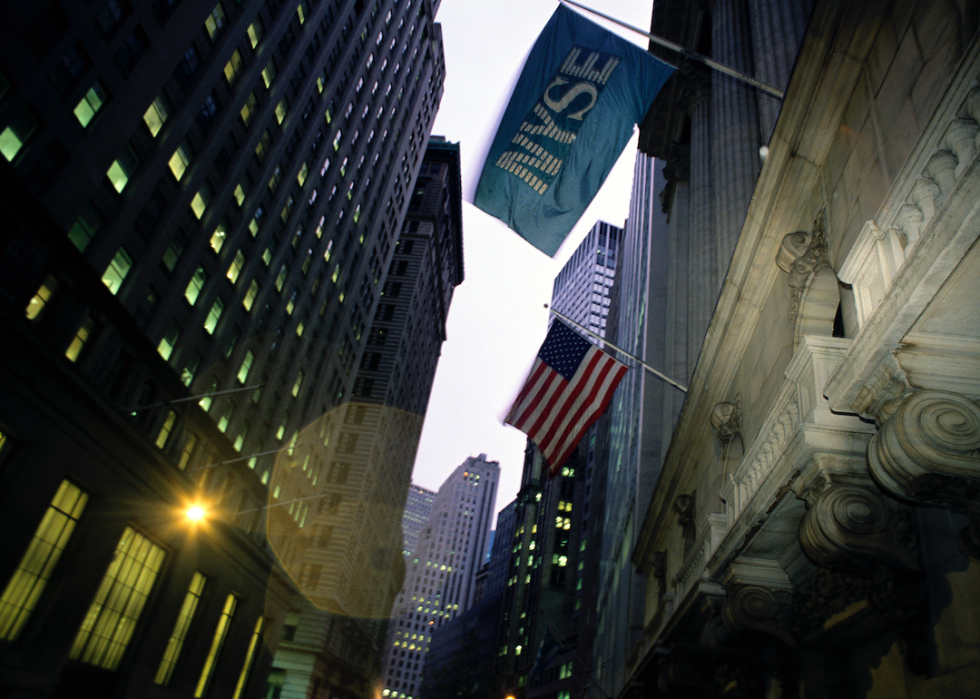
72 / 102
mark peterson/Corbis // Getty Images
1991
- Return on the S&P 500: 30.23%
- Return on 3-month Treasury bills: 5.61%
The Dow tops 3,000 for the first time, finishing the year at 3,168.83. In June 1991, the NYSE instituted after-hours trading, allowing for buy and sell orders one hour past the 4 p.m. ET close.
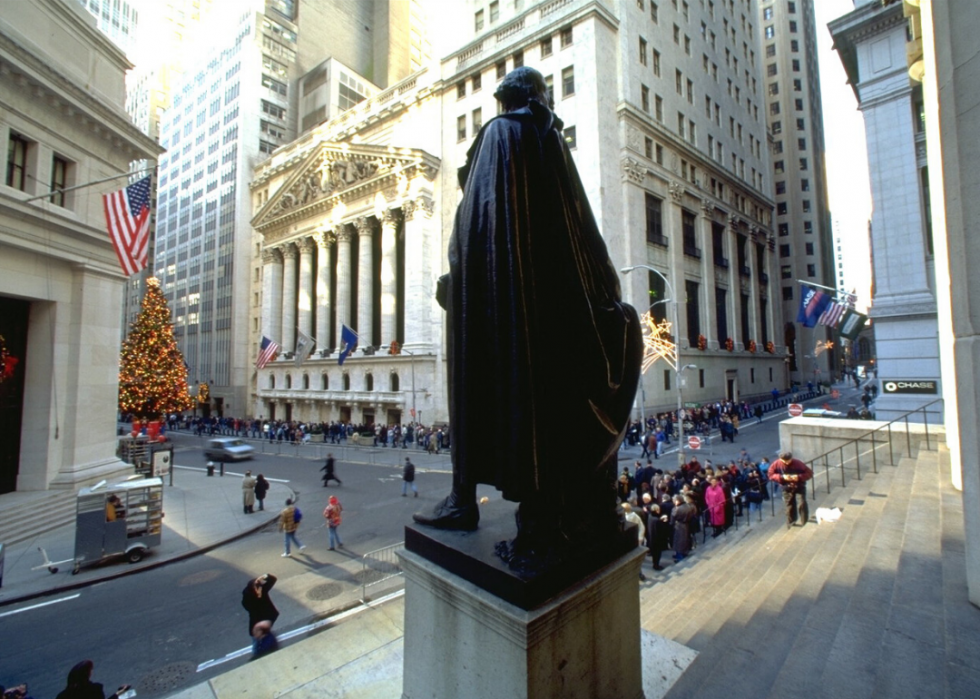
73 / 102
Rick Maiman/Sygma // Getty Images
1992
- Return on the S&P 500: 7.49%
- Return on 3-month Treasury bills: 3.41%
In May 1992, the NYSE turned 200 years old. New York City mayor David Dinkins rang the opening bell on the NYSE's 200th birthday, and Gov. Mario Cuomo made a proclamation in honor of the day.
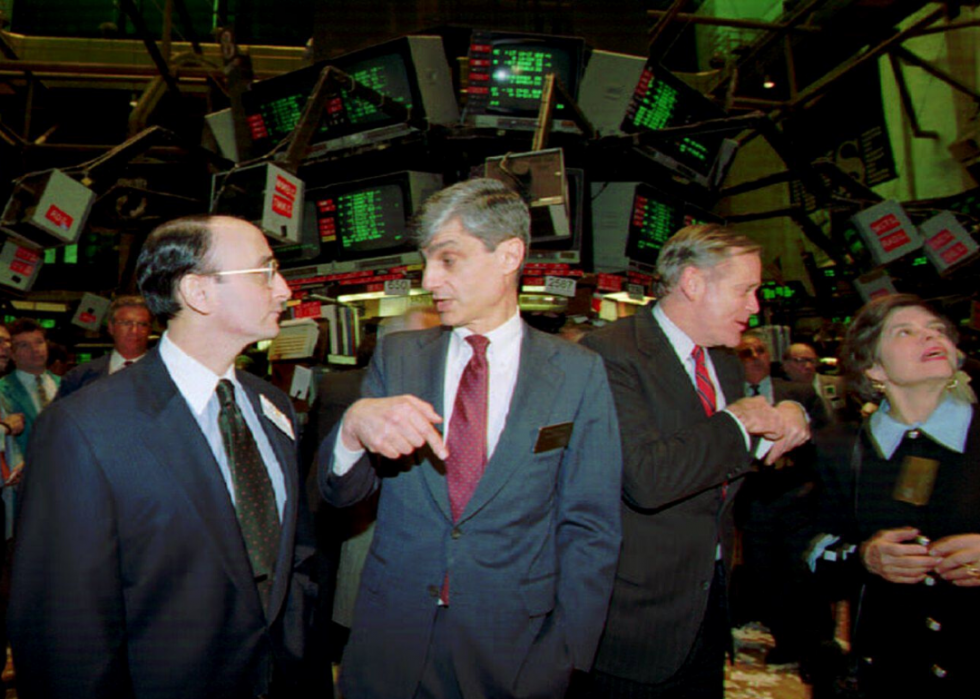
74 / 102
1993
- Return on the S&P 500: 9.97%
- Return on 3-month Treasury bills: 2.98%
Standard & Poor's Depositary Receipts (SPDR S&P 500) began trading on the American Stock Exchange in 1993. The SPDR S&P 500 became the first exchange-traded fund traded in America. Exchange-traded funds are like mutual funds—a pool of investments where individuals can buy shares.
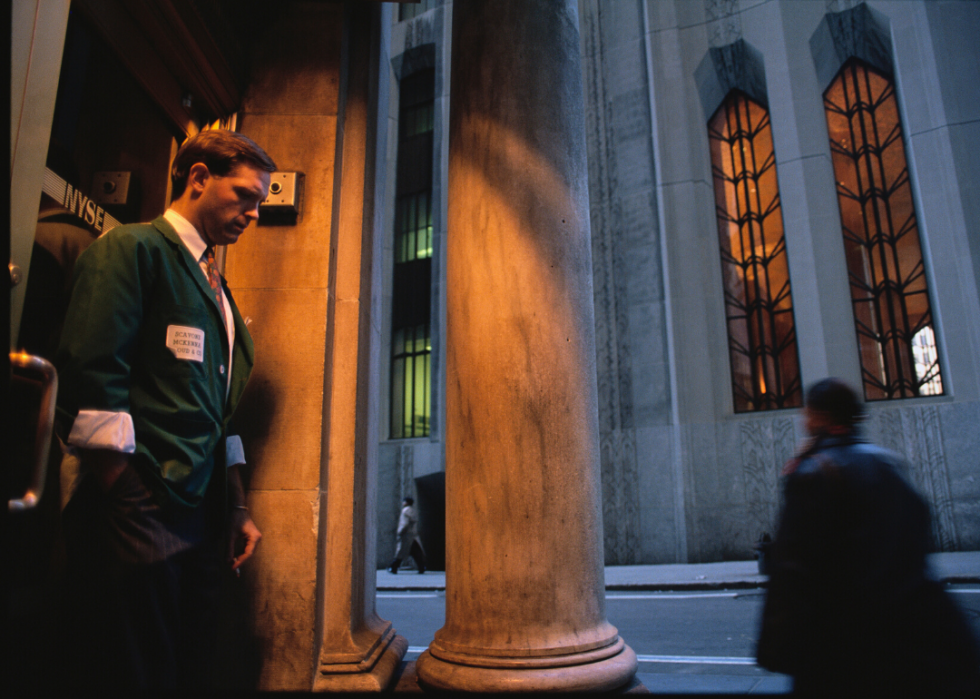
75 / 102
mark peterson/Corbis // Getty Images
1994
- Return on the S&P 500: 1.33%
- Return on 3-month Treasury bills: 3.99%
The Bank of Montreal becomes the first Canadian bank traded on the NYSE. Overall, 1994 was a weak year for mutual funds, and commercial banks became hungry for new clients, offering intriguing certificates of deposit for up to 6.5%.
You may also like: History of oil in America
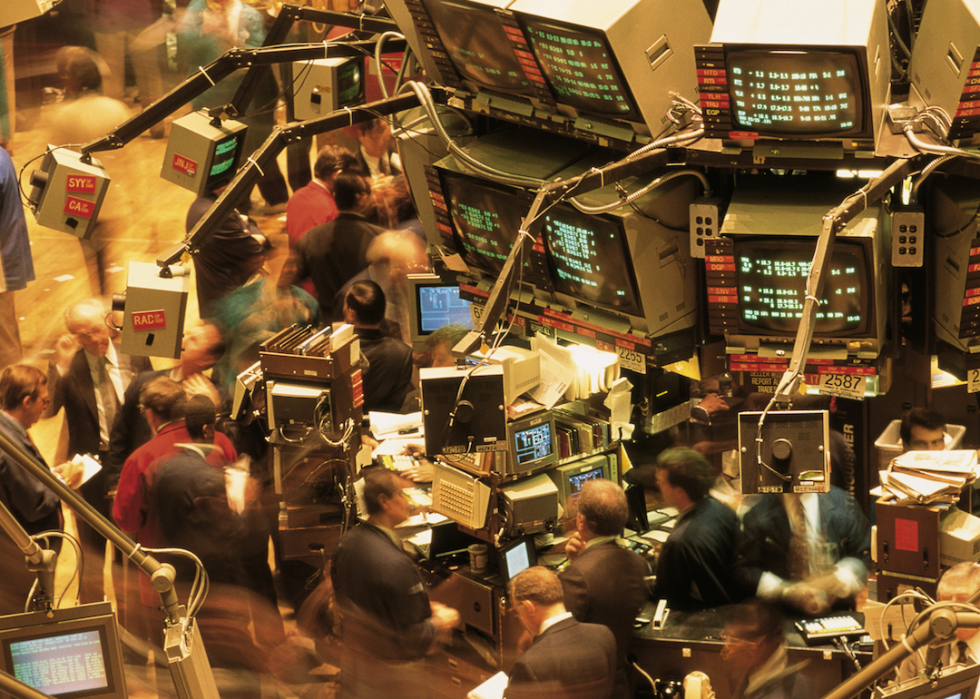
76 / 102
Joe Sohm/Visions of America/Universal Images Group // Getty Images
1995
- Return on the S&P 500: 37.2%
- Return on 3-month Treasury bills: 5.52%
Modern technology was considered to be born this year, with the advent of Windows 95, Java 1.0, and other programming languages. To keep up with increased trading in 1995, the NYSE modernized, with the installation of fiber optics, flat-screen panels, and hand-held terminals.
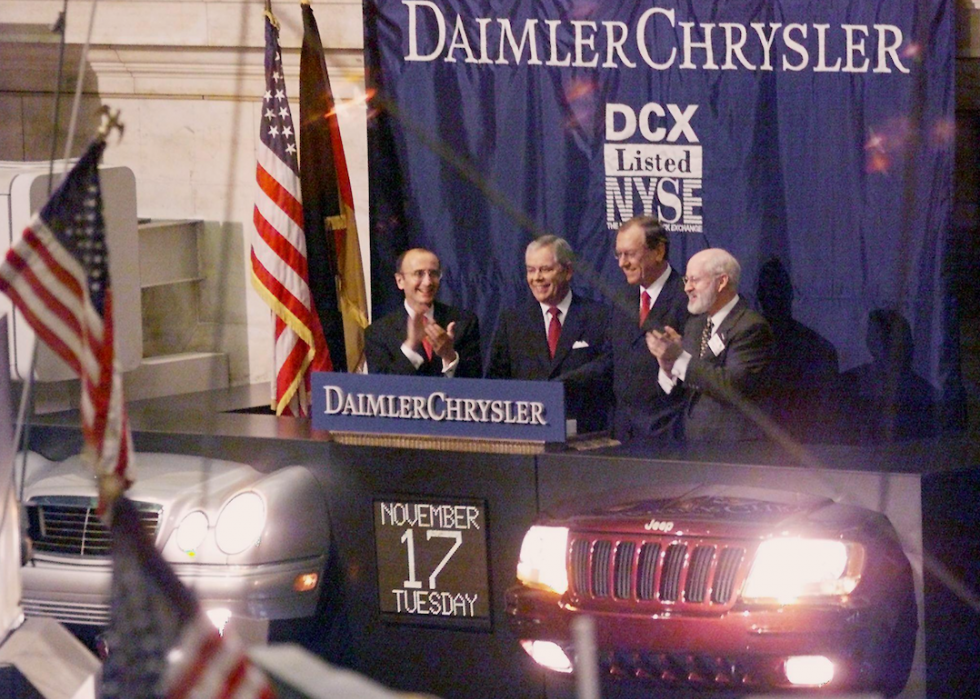
77 / 102
TIMOTHY A. CLARY/AFP // Getty Images
1996
- Return on the S&P 500: 22.68%
- Return on 3-month Treasury bills: 5.02%
William R. Johnston became president of the NYSE in 1996, taking over for Richard A. Grasso, now its chairman. Real-time electronic stock tickers were introduced on networks like CNBC, providing instant coverage of the market to investors.
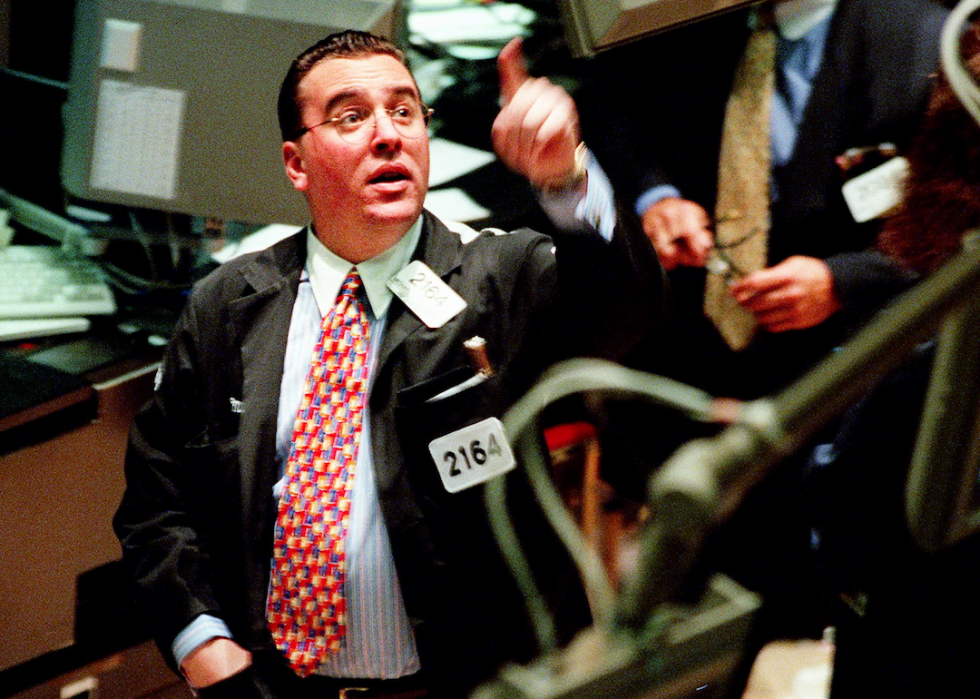
78 / 102
DON EMMERT/AFP // Getty Images
1997
- Return on the S&P 500: 33.1%
- Return on 3-month Treasury bills: 5.05%
A series of landmarks were reached in 1997. Daily volume topped one billion shares, and a fail-safe incident halted trading for 30 minutes on Oct. 27, dropping the Dow 350 points. Also, the S&P E-mini futures were introduced.
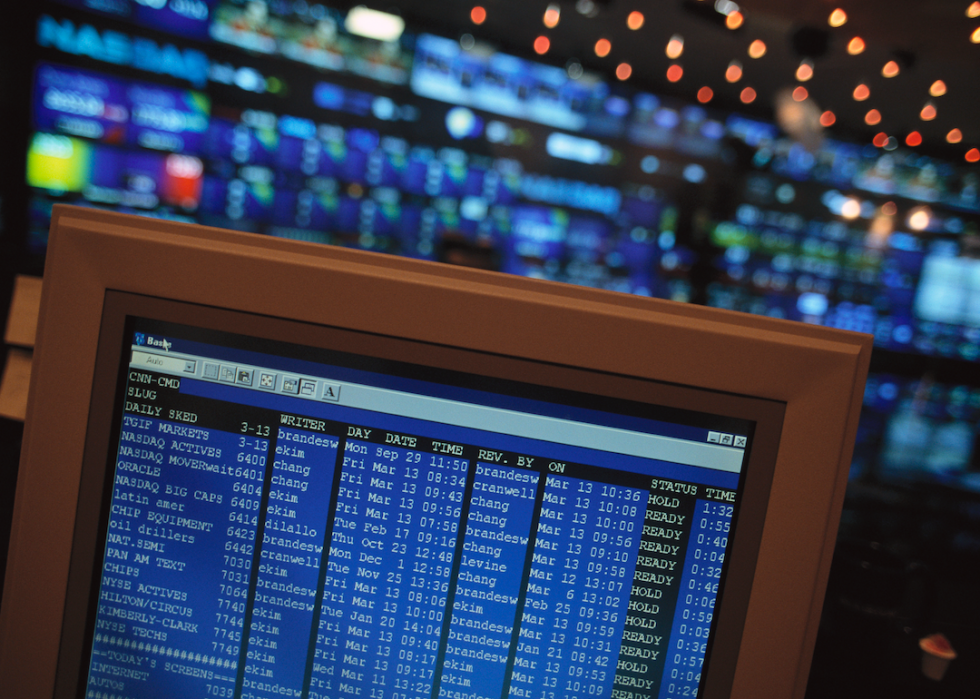
79 / 102
Mark Peterson/Corbis // Getty Images
1998
- Return on the S&P 500: 28.34%
- Return on 3-month Treasury bills: 4.73%
On Feb. 2, 1998, the S&P 500 closed above 1,000 for the first time. Nasdaq merged with the American Stock Exchange to create The Nasdaq-Amex Market Group.
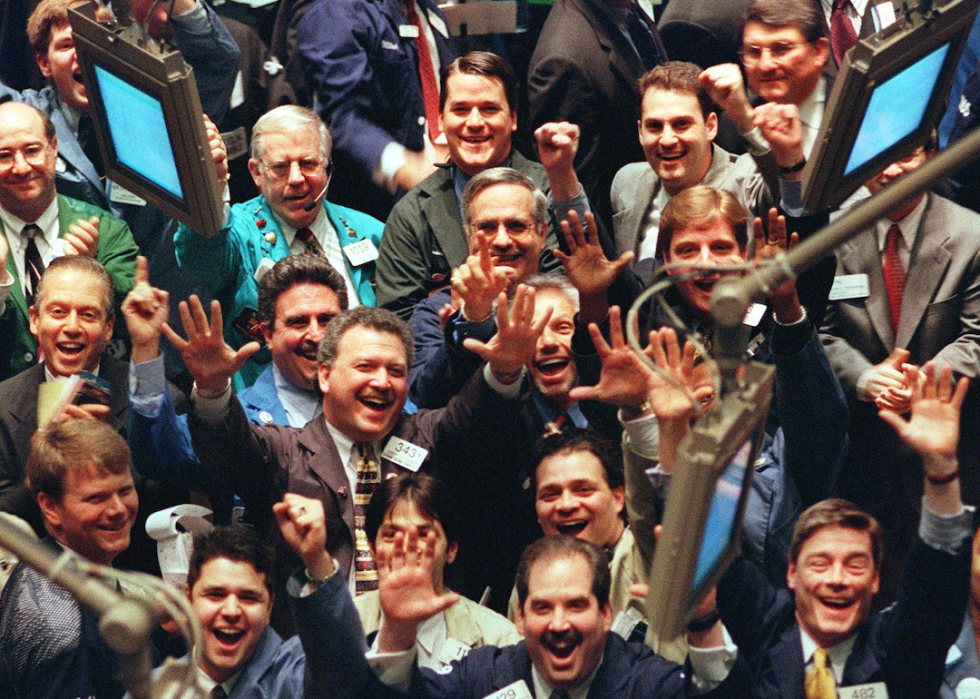
80 / 102
STAN HONDA/AFP // Getty Images
1999
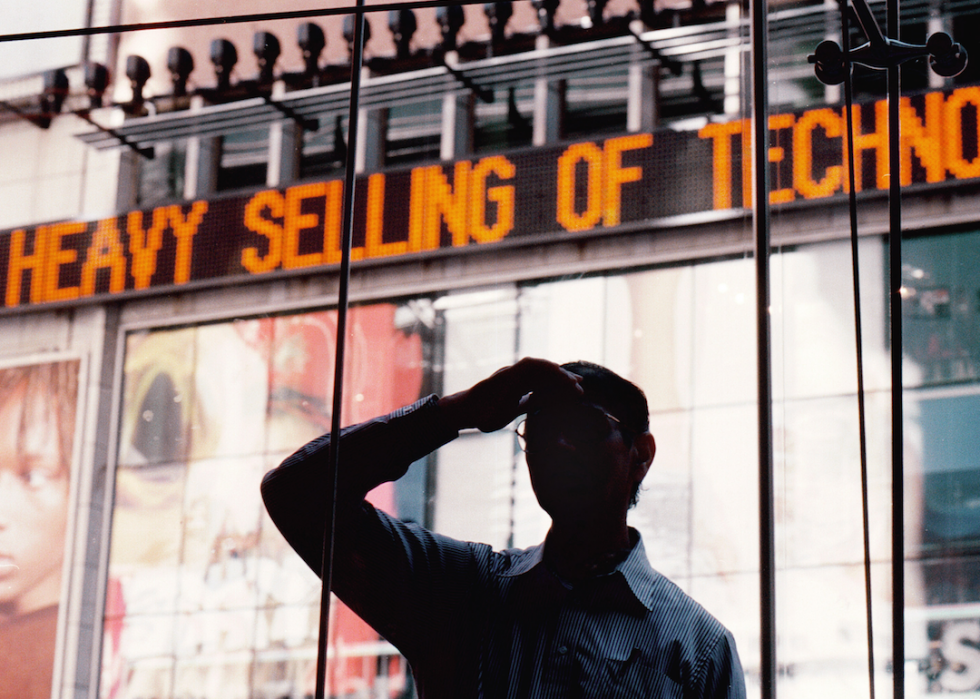
81 / 102
Chris Hondros/Newsmakers // Getty Images
2000
- Return on the S&P 500: -9.03%
- Return on 3-month Treasury bills: 5.76%
Fully electronic trades were executed and live 3D web broadcasts emanated from the NYSE floor in 2000. The dot-com bubble led to unforeseen highs, like the S&P 500 index reaching an intraday high of 1,552.87.
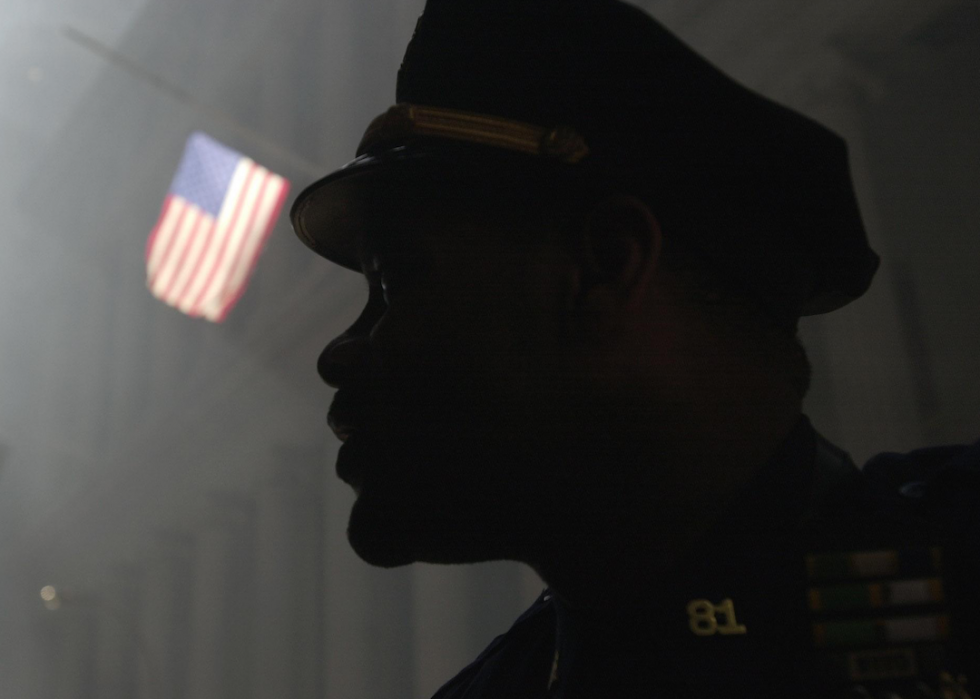
82 / 102
ROBERTO SCHMIDT/AFP // Getty Images
2001
- Return on the S&P 500: -11.85%
- Return on 3-month Treasury bills: 3.67%
The terrorist attacks of Sept. 11, 2001, closed the NYSE. The market reopened on Sept. 17, but stock markets around the world were affected and dropped sharply. The Dow ended the year down 7.10% from the previous year.
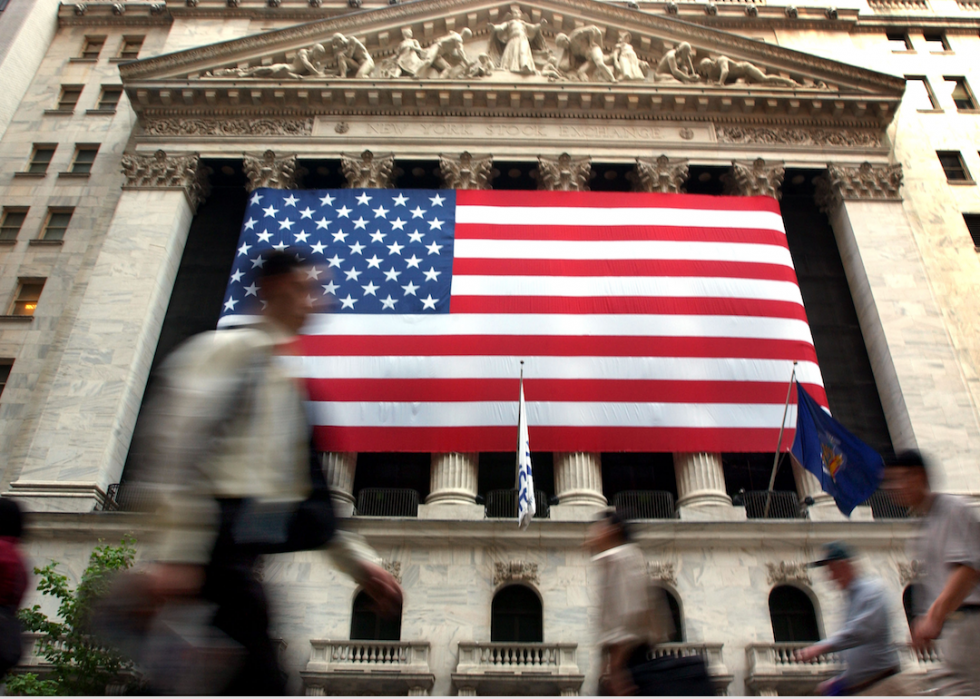
83 / 102
Spencer Platt // Getty Images
2002
- Return on the S&P 500: -21.97%
- Return on 3-month Treasury bills: 1.66%
One year after the terrorist attacks, the NYSE closed again on Sept. 11, 2002, to honor the fallen. The market struggled to recover in the wake of 9/11, reaching lows not seen since the 1987 crash. The S&P 500 incurred its worst losses since the early 1970s.
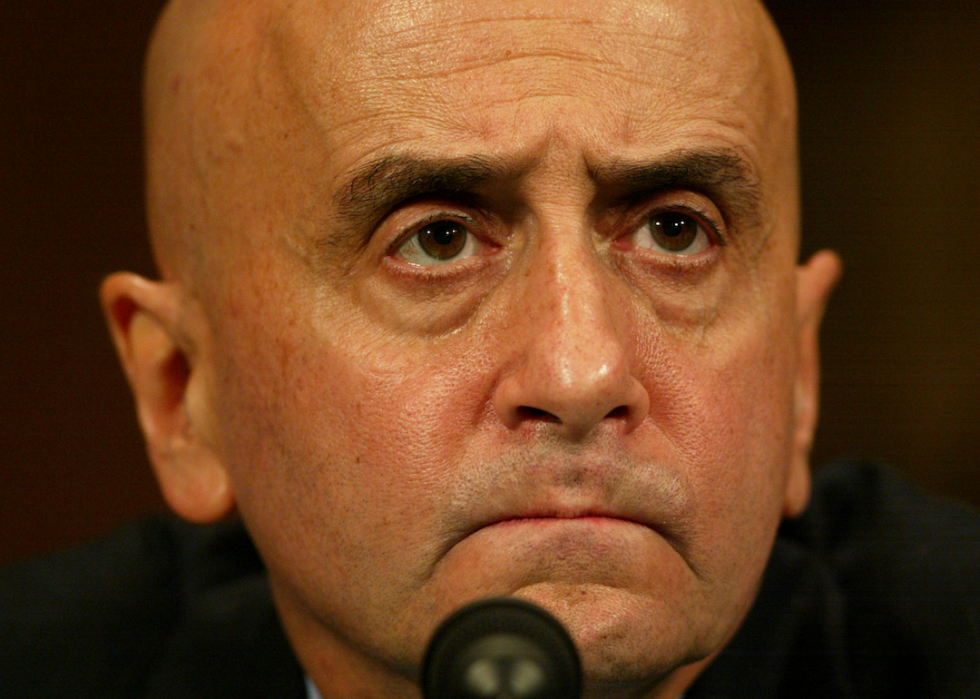
84 / 102
Alex Wong // Getty Images
2003
- Return on the S&P 500: 28.36%
- Return on 3-month Treasury bills: 1.03%
In 2003, Richard A. Grasso, chairman of the NYSE, negotiated to receive a deferred compensation package and retirement fund of about $140 million. Grasso was reported to be tied to a plan to turn the NYSE into a for-profit corporation, and was later sued to return the package.

85 / 102
Spencer Platt // Getty Images
2004
- Return on the S&P 500: 10.74%
- Return on 3-month Treasury bills: 1.23%
VIX, a ticker symbol added to the CBOE in 2004, is a volatility index that acts as a "fear gauge" for the S&P 500 index options. When stocks fall, the VIX rises.
You may also like: Best private high school in every state
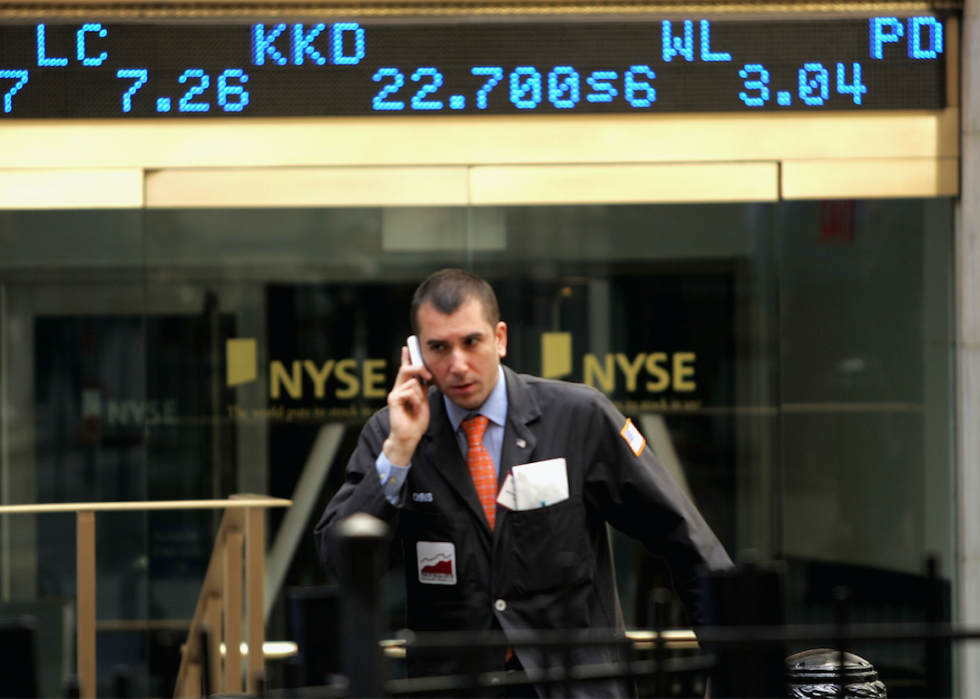
86 / 102
Spencer Platt // Getty Images
2005
- Return on the S&P 500: 4.83%
- Return on 3-month Treasury bills: 3.01%
The NYSE announces plans to merge with Archipelago, the electronic trading firm that would become a centerpiece of the investigation into the actions of Richard A. Grasso, former NYSE chairman. For the first time, the Dow remained above 10,000 throughout 2005.
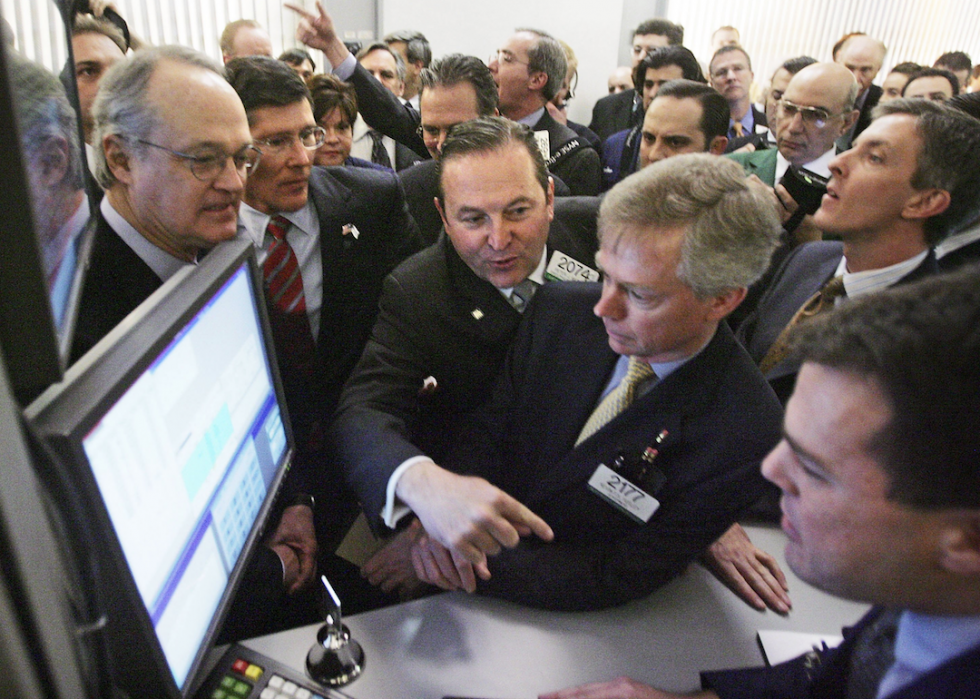
87 / 102
Mario Tama // Getty Images
2006
- Return on the S&P 500: 15.61%
- Return on 3-month Treasury bills: 4.68%
The NYSE began trading as a public company in 2006, after converting member seats into shares. The famed Stock Exchange Luncheon Club, a private dining facility, closes. The Club, decorated in marble and grand chandeliers, opened in 1898.
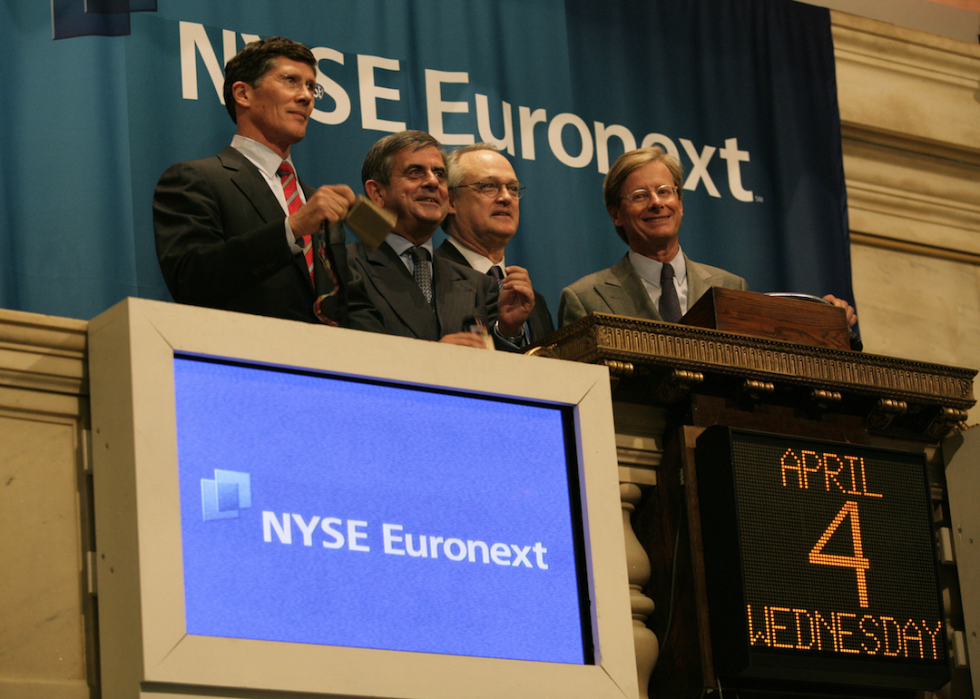
88 / 102
NICHOLAS ROBERTS/AFP // Getty Images
2007
- Return on the S&P 500: 5.48%
- Return on 3-month Treasury bills: 4.64%
As stock, bond, and other exchanges worldwide began consolidating, the NYSE merged with Euronext, a large European stock exchange. By October 2007, the S&P 500 hit an intraday high of 1,576.09.
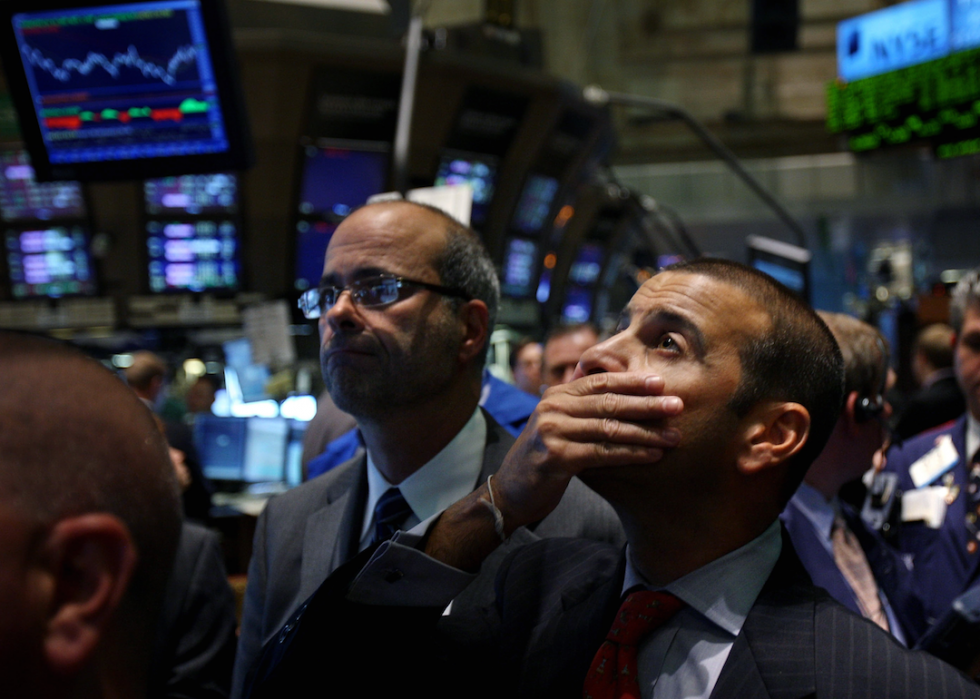
89 / 102
Spencer Platt // Getty Images
2008
- Return on the S&P 500: -36.55%
- Return on 3-month Treasury bills: 1.59%
The NYSE acquired its rival, the American Stock Exchange, in a deal worth $260 million in stock. In 2008, NYSE-owned stock exchanges traded 802 billion shares, the most in its history.
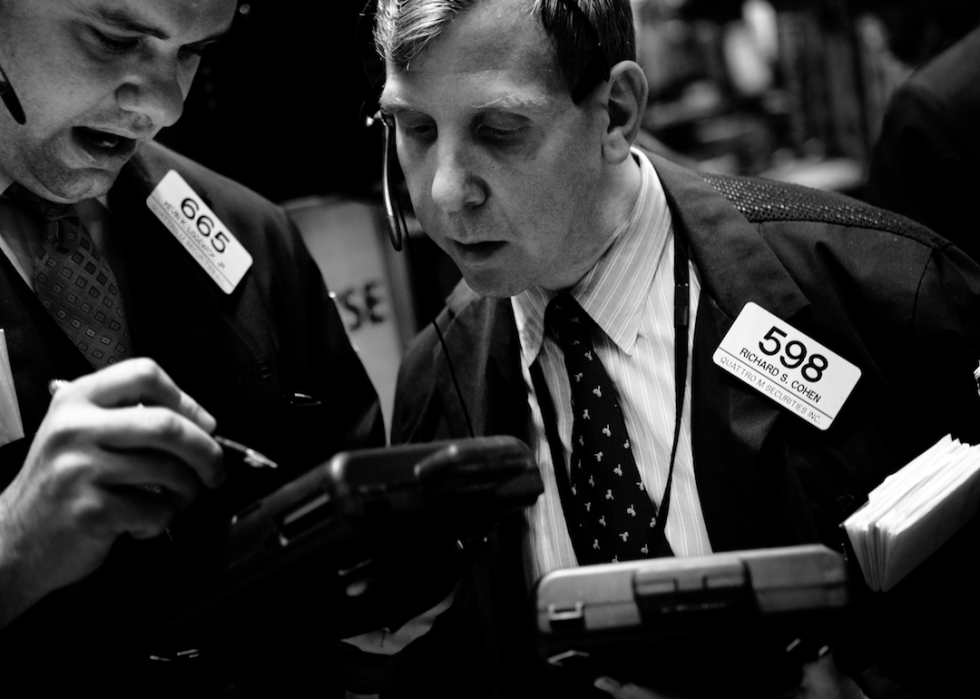
90 / 102
Jeff Hutchens // Getty Images
2009
- Return on the S&P 500: 25.94%
- Return on 3-month Treasury bills: 0.14%
Despite taking over the American Stock Exchange, the NYSE sees a threat from smaller, private rivals favored by big banks and investment funds. The Dow finished 2009 at 10,428.05, and throughout the next decade, never closed out the year below the 10,000 mark.
You may also like: 25 IPOs that skyrocketed on their first day
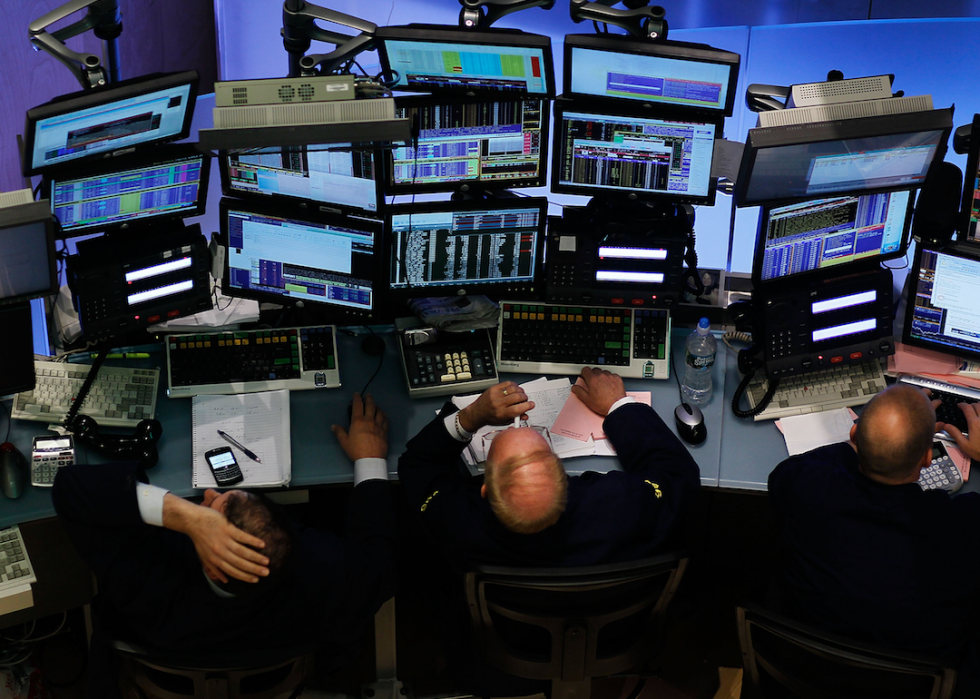
91 / 102
Chris Hondros // Getty Images
2010
- Return on the S&P 500: 14.82%
- Return on 3-month Treasury bills: 0.13%
A circuit breaker that closed the NYSE in 1997 also led to a flash crash on May 6, 2010, after a surge of automated high-frequency trading. A newly-formed NYSE Commission on Corporate Governance created a report of 10 core principles to possibly be used by investors, directors, issuers, and other market participants. One such principle is: "The board's fundamental objective should be to build long-term, sustainable growth in shareholder value for the corporation, and the board is accountable to shareholders for its performance in achieving this objective."
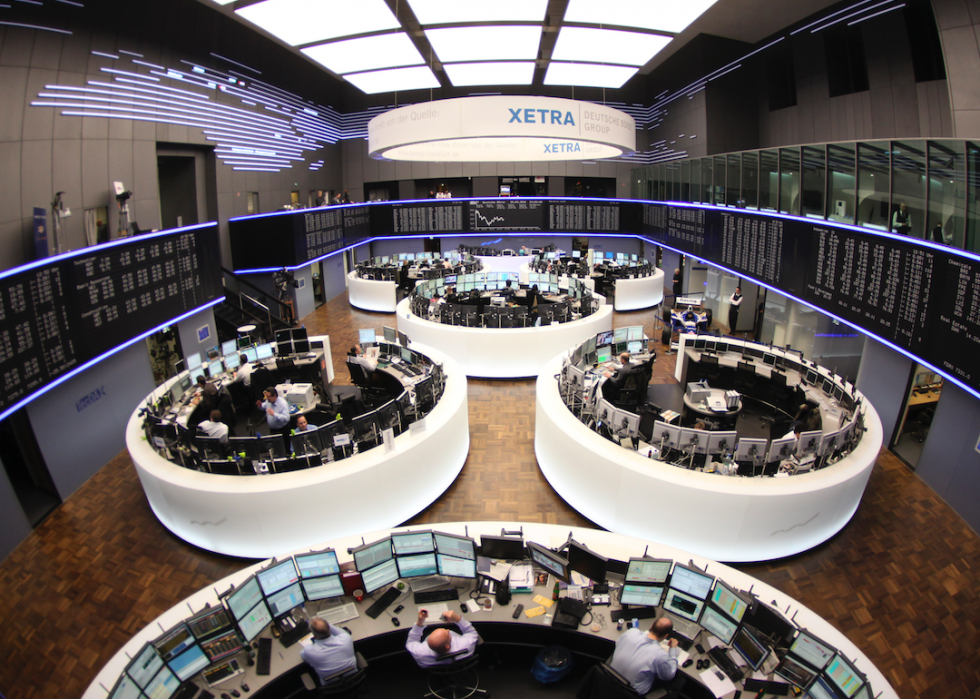
92 / 102
Ralph Orlowski // Getty Images
2011
- Return on the S&P 500: 2.1%
- Return on 3-month Treasury bills: 0.03%
Mergers continue to be a trend, as the NYSE Euronext agrees to combine with Germany's Deutsche Boerse AG, which owns Frankfurt's stock exchange. Nasdaq also made a bid to acquire NYSE Euronext in 2011.
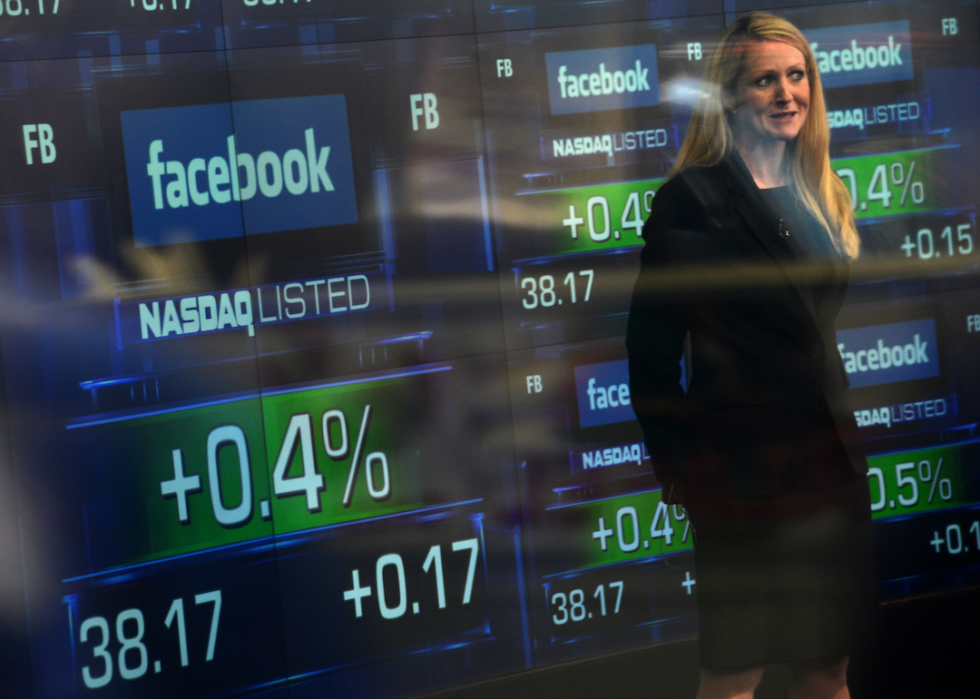
93 / 102
EMMANUEL DUNAND/AFP // GettyImages
2012
- Return on the S&P 500: 15.89%
- Return on 3-month Treasury bills: 0.05%
Facebook's IPO, which debuted at $42.05 in 2012, was one of the most highly-anticipated IPOs of the 21st century. Five months later, Hurricane Sandy shut down the NYSE, and the market closed for two full days for the first time since 1988.
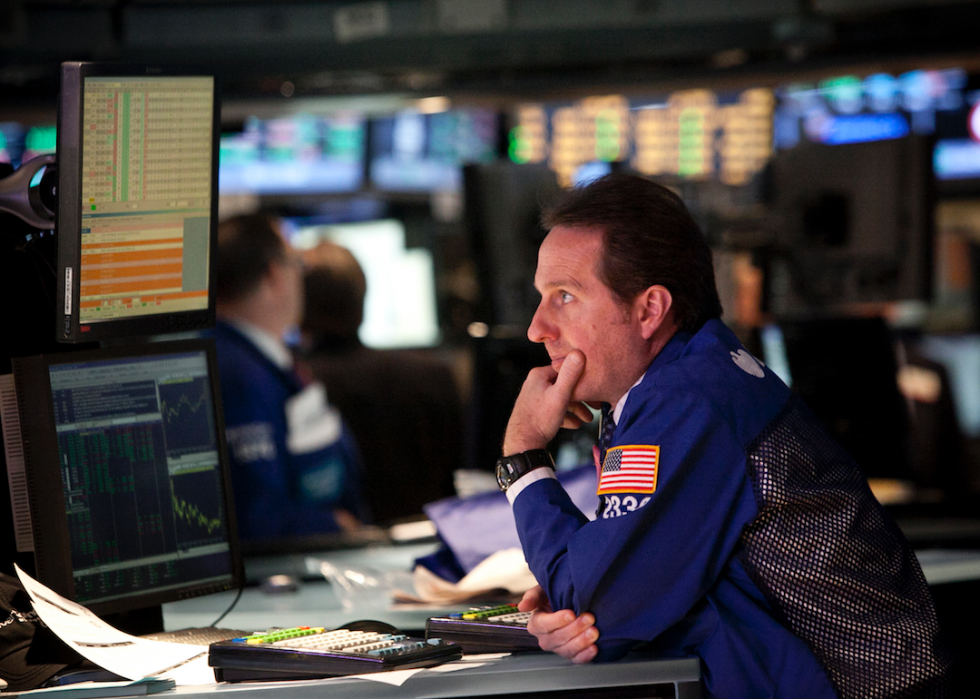
94 / 102
Allison Joyce // Getty Images
2013
- Return on the S&P 500: 32.15%
- Return on 3-month Treasury bills: 0.07%
In 2013, Intercontinental Exchange (ICE) acquired NYSE Euronext for $8.2 billion, which ICE chairman Jeffrey Sprecher called "a game-changing transaction." Sprecher founded ICE only 13 years earlier, and at that time he immediately tried to buy the New York Mercantile Exchange.

95 / 102
Andrew Burton // Getty Images
2014
- Return on the S&P 500: 13.52%
- Return on 3-month Treasury bills: 0.05%
ICE began its takeover of the NYSE in 2014 by modernizing the NYSE building and creating more space for listed companies. Santander Consumer USA Holdings, Inc.; Synchrony Financial; and Alibaba Group Holding, Ltd., were responsible for some of the biggest IPOs.
You may also like: Worst jobs in America
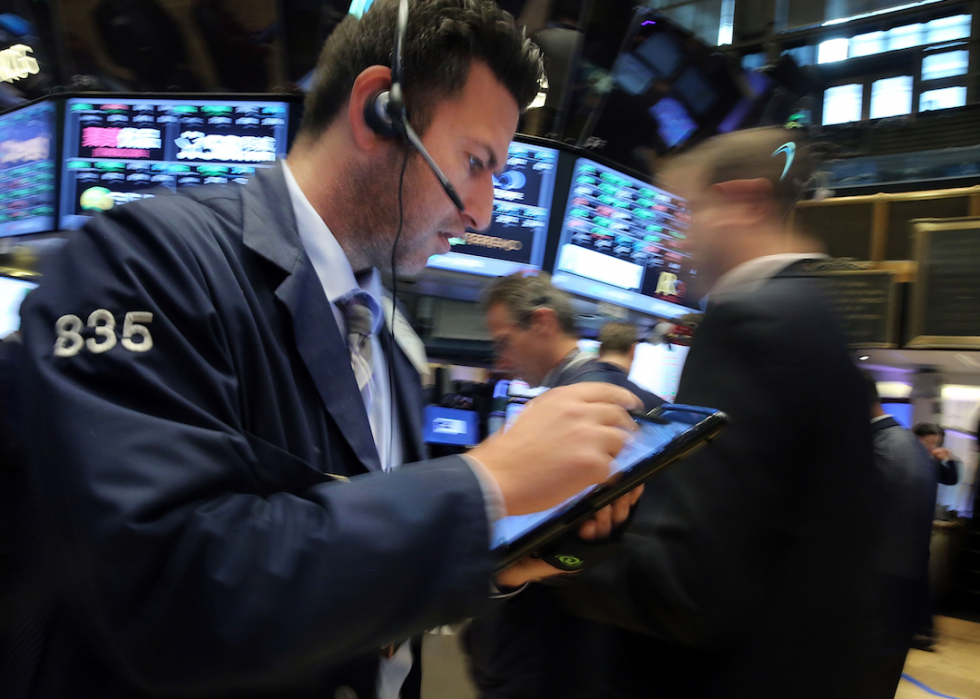
96 / 102
Spencer Platt // Getty Images
2015
- Return on the S&P 500: 1.38%
- Return on 3-month Treasury bills: 0.21%
The NYSE had to momentarily cease trading on July 8, 20l5 due to technical issues, which some initially speculated was a cyberattack. Netflix and Amazon were two of the stars of the S&P 500, while in their sectors, Whole Foods and Navient suffered big drops.
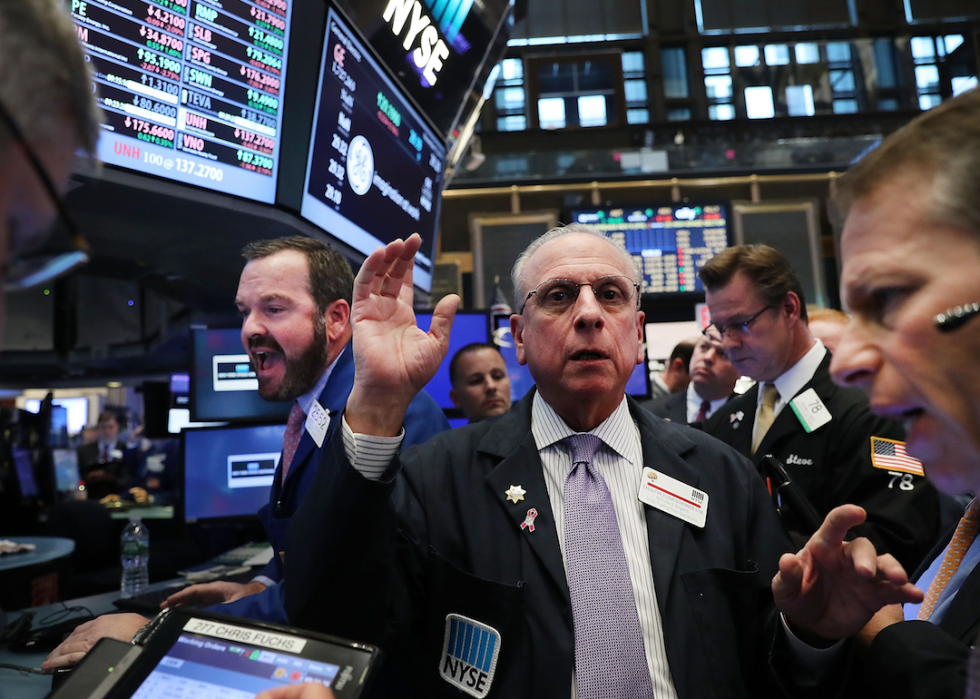
97 / 102
Spencer Platt // Getty Images
2016
- Return on the S&P 500: 11.77%
- Return on 3-month Treasury bills: 0.51%
The NYSE reported $13.1 billion raised from IPOs in 2016. After the 2016 presidential election, the Dow finished the year just falling short of reaching the 20,000 mark, closing at 19,762.60.
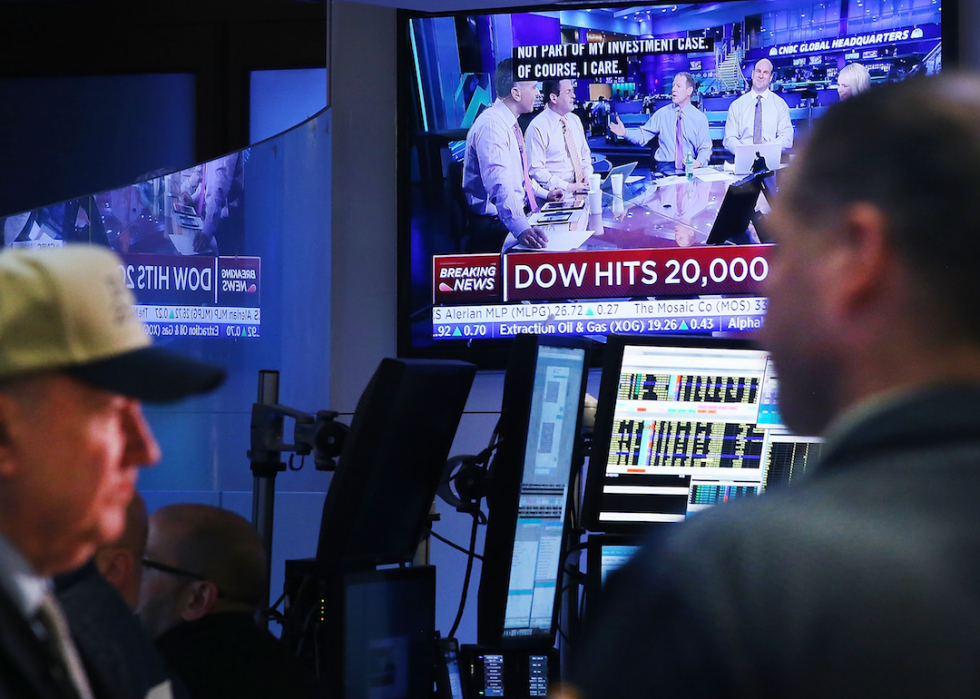
98 / 102
Spencer Platt // Getty Images
2017
- Return on the S&P 500: 21.64%
- Return on 3-month Treasury bills: 1.39%
On Jan. 25, 2017, the Dow reached the 20,000 mark for the first time. Canada Goose, BP Midstream Partners, and despegar.com are some of the notable IPOs. The NYSE also became the U.S. leader in Chinese IPOs, signaling a new focus on the Asian market.
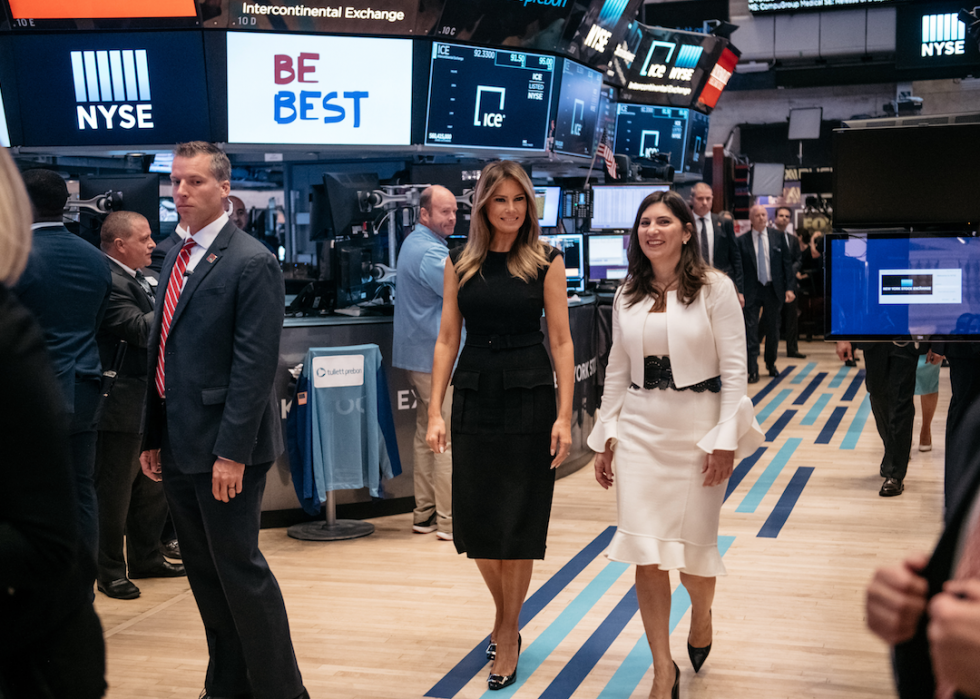
99 / 102
Scott Heins // Getty Images
2018
- Return on S&P 500: -4.38%
- Return on 3-month Treasury bills: 1.94%
Stacey Cunningham became president of the NYSE in 2018. ADT, Dropbox, and BJ's Wholesale Club were some of the top IPOs. Spotify, however, was perhaps the most notable, opening at $165.90.
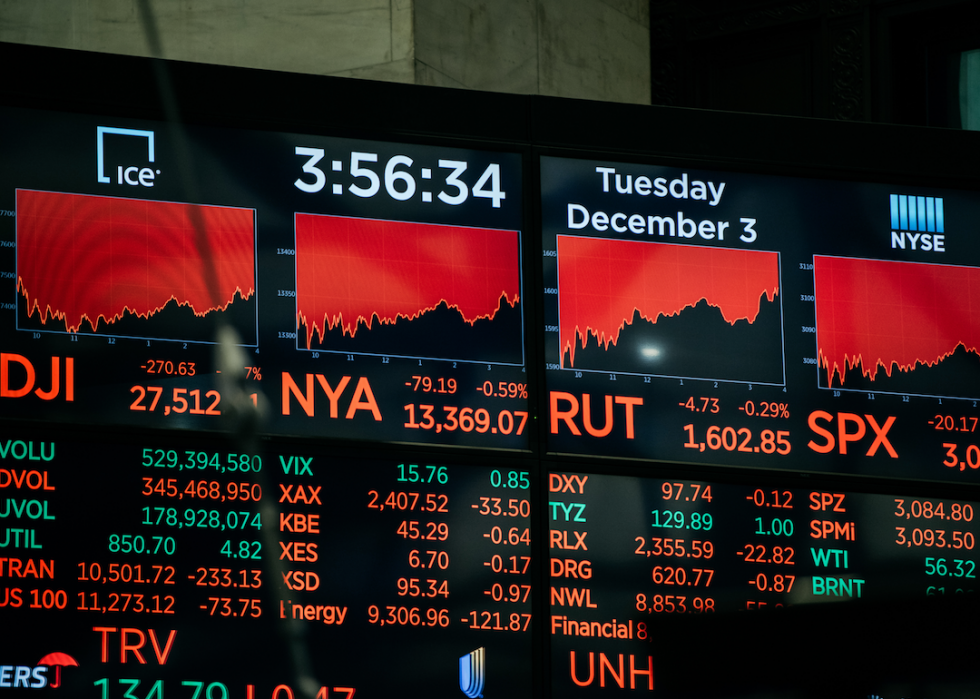
100 / 102
Scott Heins // Getty Images
2019
- Return on S&P 500: 31.49%
- Return on 3-month Treasury bills: 2.06%
Nasdaq and the NYSE engaged in a heated battle for top upcoming IPOs. A back-and-forth trade battle between China and the United States in 2019 resulted in huge market fluctuations. The Dow closed at 28,538.44.
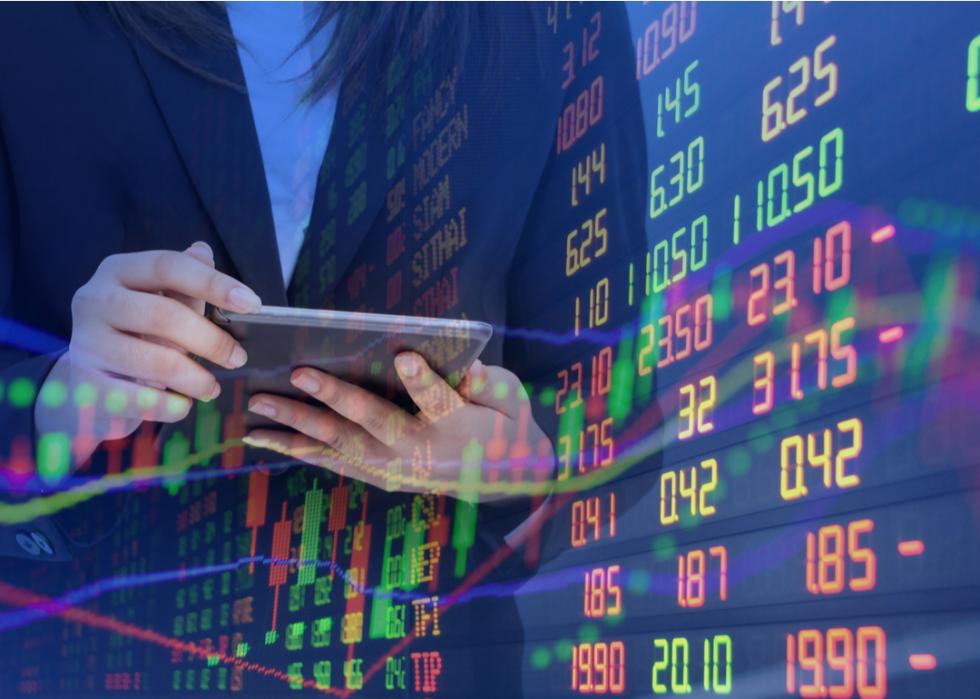
101 / 102
photofriday // Shutterstock
2020
- Return on S&P 500: 17.88%
- Return on 3-month Treasury bills: 0.09%
On Feb. 19, 2020, the S&P 500 reached a record high, but news of COVID-19 compelled investors to sell, inciting what turned out to be the shortest bear market in history—33 days, in which the S&P 500 crashed 34%. Despite the catastrophic pandemic, mass protests against police violence, the contentious 2020 presidential election, and the struggling economy, the stock market ultimately reached all-time highs in 2020. SPACs (Special Purchase Acquisition Company) had a breakout year and experienced record growth in 2020, raising 462% more than in 2019.
You may also like: Best small towns for retirees in America
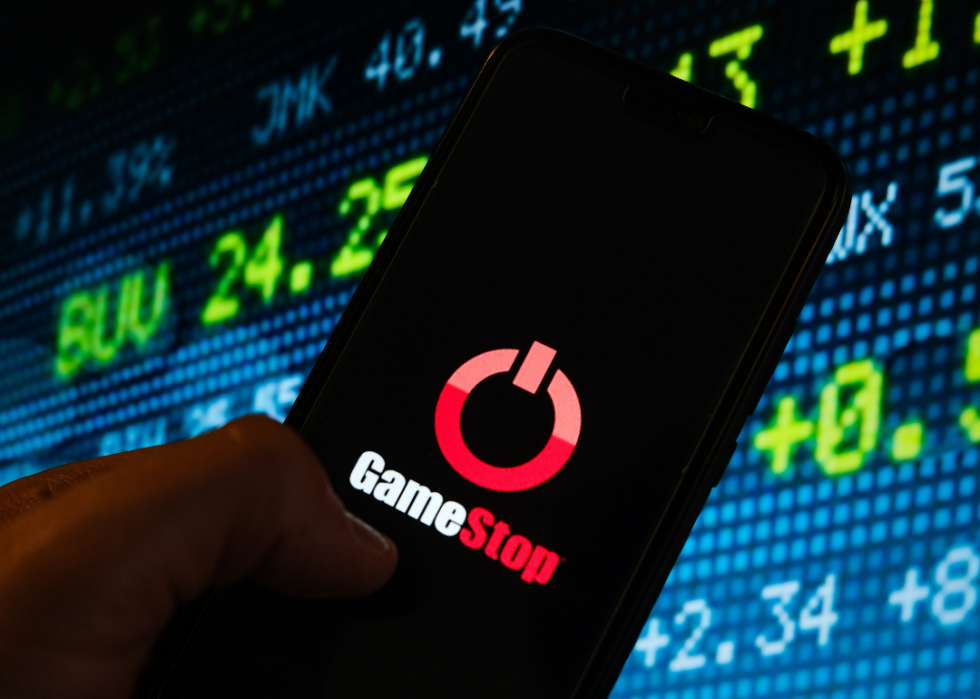
102 / 102
Omar Marques/SOPA Images/LightRocket via Getty Images
2021
- Return on the S&P 500: 4.14% (as of March 2, 2021)
- Return on 3-month Treasury bills: 0.06%
In the six months leading up to January 2021, GameStop stock grew roughly 8,000% despite the video game retailer's financial struggles. The reason for the explosive growth was due to people in large online trading forums buying up GameStop stock to drive its value in order to disrupt short sellers—professional investors such as hedge funds that borrow shares of stock to sell and buy back for a profit when prices fall. Short sellers were estimated in January 2021 to have lost $23.6 billion on GameStop. Similar activity ensconced fellow short seller companies AMC Theatres, Bed Bath & Beyond, and Blockbuster.
Trending Now
© Stacker 2022. All rights reserved.
gilliardcongavoke41.blogspot.com
Source: https://stacker.com/stories/4028/stock-market-history-year-you-were-born
0 Response to "Java Bay Stock Play It Again Sports Stocks"
Postar um comentário